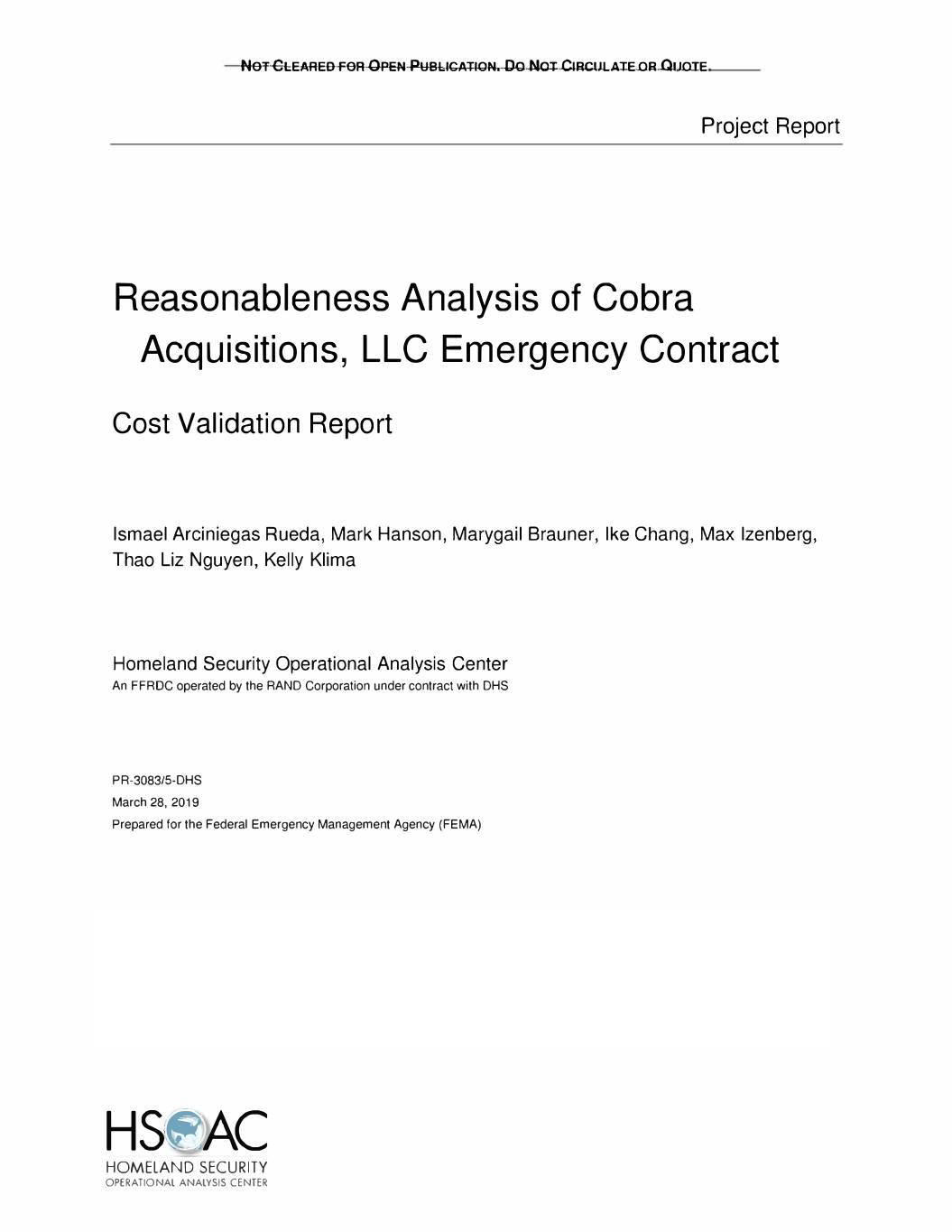
NOT CLEARED FOR OPEN PUBLICATION. Do NOT CIRCI ILATE OR a, IOIE Project Report Reasonableness Analysis of Cobra Acquisitions, LLC Emergency Contract Cost Validation Report Ismael Arciniegas Rueda, Mark Hanson, Marygail Brauner, Ike Chang, Max lzenberg, Thao Liz Nguyen, Kelly Klima Homeland Security Operational Analysis Center An FFRDC operated by the RAND Corporation under contract with DHS PR-3083/5-DHS March 28, 2019 Prepared for the Federal Emergency Management Agency (FEMA) NOT CLEARED FOR PUBLIC RELEASE This document has not been formally reviewed, edited, or cleared for public release. It may not be cited, quoted, reproduced or transmitted without the permission of the Homeland Security Operational Analysis Center (HSOAC), an FFRDC operated by the RAND Corporation under contract with the Department of Homeland Security. HS8AC HOMELAND SECURITY OPERATIONAL ANALYSIS CENTER
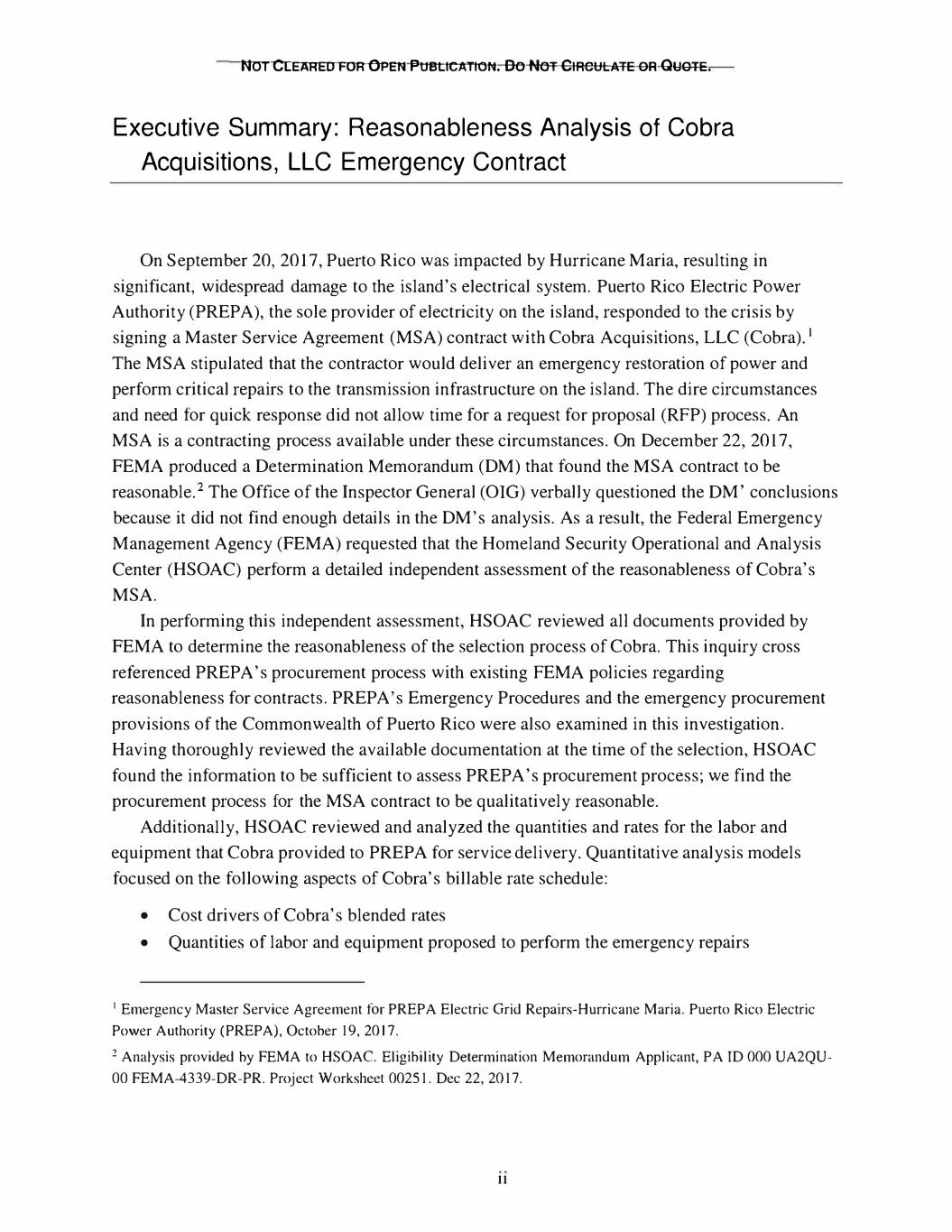
Nor CLEARED FOR OPEN PUBLICATION. Do NOT CIRCULATE OR QUOTE. Executive Summary: Reasonableness Analysis of Cobra Acquisitions, LLC Emergency Contract On September 20, 2017, Puerto Rico was impacted by Hurricane Maria, resulting in significant, widespread damage to the island's electrical system. Puerto Rico Electric Power Authority (PREP A), the sole provider of electricity on the island, responded to the crisis by signing a Master Service Agreement (MSA) contract with Cobra Acquisitions, LLC (Cobra). 1 The MSA stipulated that the contractor would deliver an emergency restoration of power and perform critical repairs to the transmission infrastructure on the island. The dire circumstances and need for quick response did not allow time for a request forproposal (RFP) process. An MSA is a contracting process available under these circumstances. On December 22, 2017, FEMA produced a Determination Memorandum (DM) that found the MSA contract to be 2 reasonable. The Officeof the Inspector General (OIG) verbally questioned the DM' conclusions because it did not find enough details in the DM's analysis. As a result, the Federal Emergency Management Agency (FEMA) requested that the Homeland Security Operational and Analysis Center (HSOAC) perform a detailed independent assessment of the reasonableness of Cobra's MSA. In performingthis independent assessment, HSOAC reviewed all documents provided by FEMA to determine the reasonableness of the selection process of Cobra. This inquiry cross referencedPREPA's procurement process with existing FEMA policies regarding reasonableness for contracts. PREPA's Emergency Procedures and the emergency procurement provisions of the Commonwealth of Puerto Rico were also examined in this investigation. Having thoroughly reviewed the available documentation at the time of the selection, HSOAC foundthe information to be sufficient to assess PREPA's procurement process; we find the procurement process for the MSA contract to be qualitatively reasonable. Additionally, HSOAC reviewed and analyzed the quantities and rates for the labor and equipment that Cobra provided to PREPA forservice delivery. Quantitative analysis models focusedon the following aspects of Cobra's billable rate schedule: • Cost drivers of Cobra's blended rates • Quantities of labor and equipment proposed to perform the emergency repairs 1 Emergency Master Service Agreement for PREP A Electric Grid Repairs-Hurricane Maria. Puerto Rico Electric Power Authority (PREPA), October 19, 2017. 2 Analysis provided by FEMA to HSOAC. Eligibility Determination Memorandum Applicant, PA JD 000 UA2QU OO FEMA-4339-DR-PR. Project Worksheet 00251. Dec 22, 2017. II
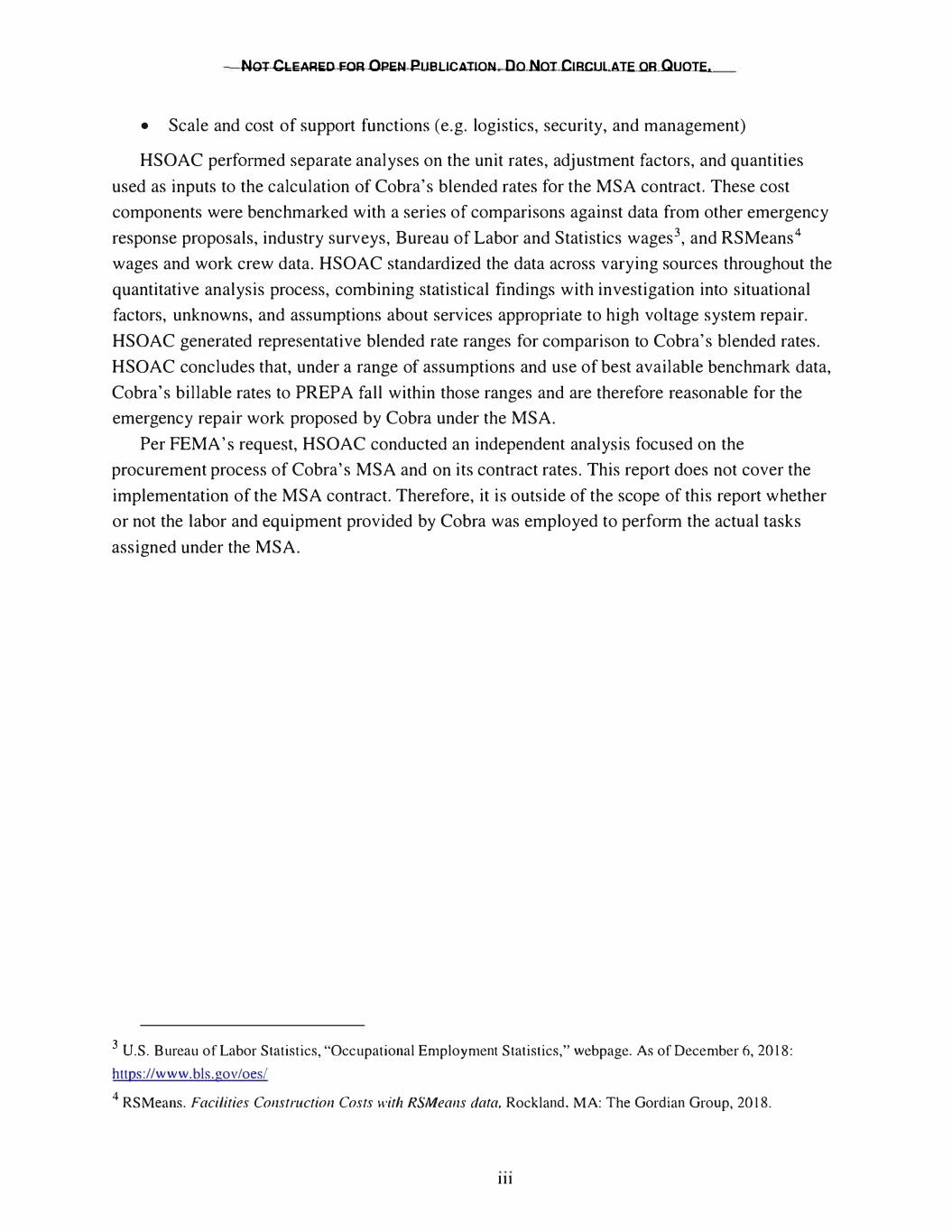
NOT CbEARED FOR OPEN Pl IBLICATI0N no Nor CIBCIII ATE OR OUOTE. • Scale and cost of support functions (e.g. logistics, security, and management) HSOAC perfonned separate analyses on the unit rates, adjustment factors, and quantities used as inputs to the calculation of Cobra's blended rates forthe MSA contract. These cost components were benchmarked with a series of comparisons against data from other emergency response proposals, industry surveys, Bureau of Labor and Statistics wages 3, and RSMeans4 wages and work crew data. HSOAC standardized the data across varying sources throughout the quantitative analysis process, combining statistical findings with investigation into situational factors, unknowns, and assumptions about services appropriate to high voltage system repair. HSOAC generated representative blended rate ranges forcomparison to Cobra's blended rates. HSOAC concludes that, under a range of assumptions and use of best available benchmark data, Cobra's billable rates to PREP A fall within those ranges and are therefore reasonable for the emergency repair work proposed by Cobra under the MSA. Per FEMA's request, HSOAC conducted an independent analysis focused on the procurement process of Cobra's MSA and on its contract rates. This report does not cover the implementation of the MSA contract. Therefore, it is outside of the scope of this report whether or not the labor and equipment provided by Cobra was employed to perform the actual tasks assigned under the MSA. 3 U.S. Bureau of Labor Statistics, "Occupational Employment Statistics," webpage. As of December 6, 2018: https://www.bls.gov/oes/ 4 RSMeans. Facilities Construction Costs with RSMeans data, Rockland, MA: The Gordian Group, 2018. Ill
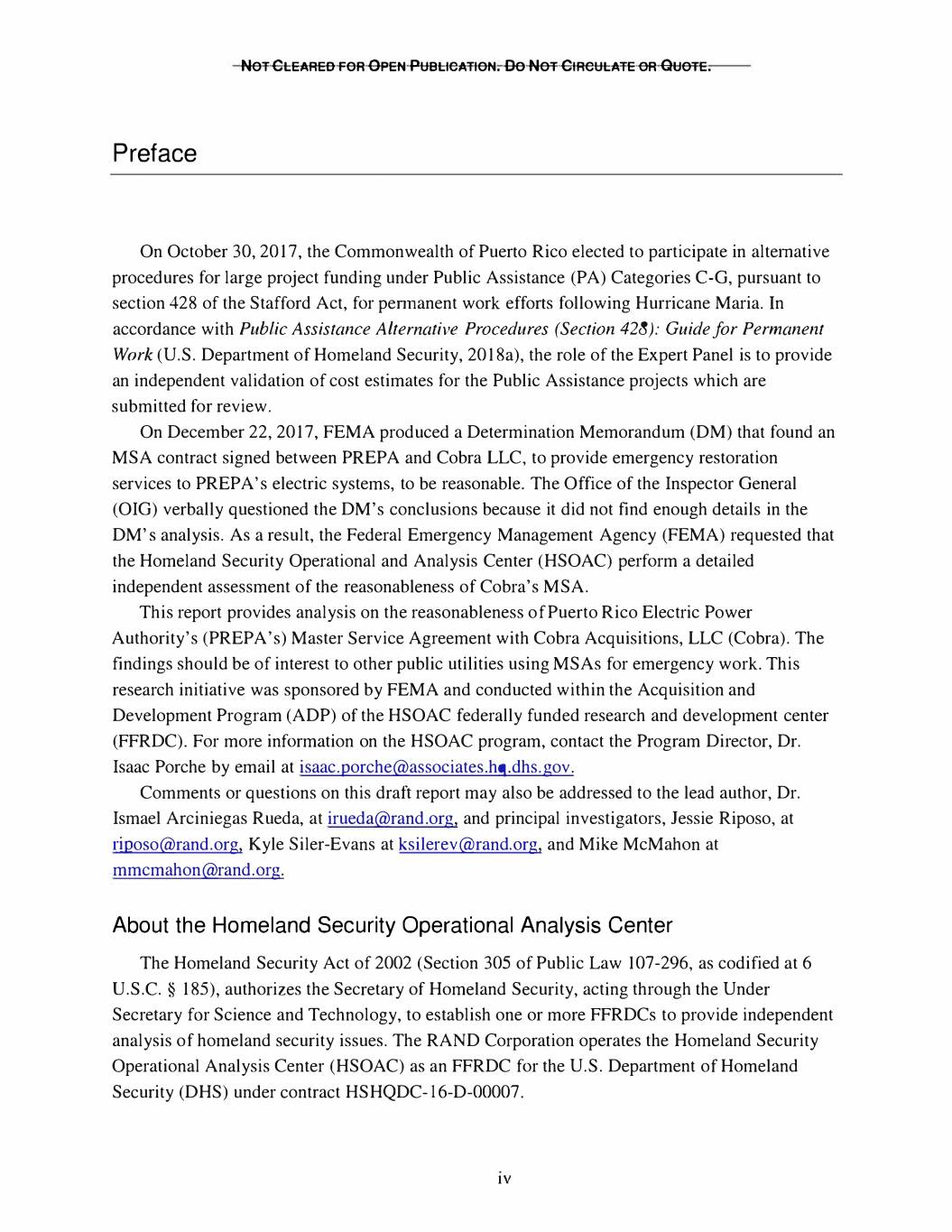
NOT CLEARED FOR OPEN PUBLICATION. 00 NOT CIRCULATE OR QUOTE. Preface On October 30, 2017, the Commonwealth of Puerto Rico elected to participate in alternative procedures forlarge project funding under Public Assistance (PA) Categories C-G, pursuant to section 428 of the Stafford Act, for permanent work efforts followingHurricane Maria. In accordance with Public Assistance Alternative Procedures (Section 428): Guide for Permanent Work (U.S. Department of Homeland Security, 2018a), the role of the Expert Panel is to provide an independent validation of cost estimates forthe Public Assistance projects which are submitted forreview. On December 22, 2017, FEMA produced a Determination Memorandum (DM) that foundan MSA contract signed between PREPA and Cobra LLC, to provide emergency restoration services to PREP A's electric systems, to be reasonable. The Officeof the Inspector General (OIG) verbally questioned the DM's conclusions because it did not find enough details in the DM' s analysis. As a result, the Federal Emergency Management Agency (FEMA) requested that the Homeland Security Operational and Analysis Center (HSOAC) perform a detailed independent assessment of the reasonableness of Cobra's MSA. This report provides analysis on the reasonableness of Puerto Rico Electric Power Authority's (PREPA's) Master Service Agreement with Cobra Acquisitions, LLC (Cobra). The findings should be of interest to other public utilities using MSAs for emergency work. This research initiative was sponsored by FEMA and conducted within the Acquisition and Development Program (ADP) of the HSOAC federally funded research and development center (FFRDC). For more information on the HSOAC program, contact the Program Director, Dr. Isaac Porche by email at isaac.porche@associates.hg.dhs.gov. Comments or questions on this draftreport may also be addressed to the lead author, Dr. Ismael Arciniegas Rueda, at irueda@rand.org, and principal investigators, Jessie Riposo, at 1iposo@rand.org. Kyle Siler-Evans at ksilerev@rand.org. and Mike McMahon at mmcmahon@rand.org. About the Homeland Security Operational Analysis Center The Homeland Security Act of 2002 (Section 305 of Public Law 107-296, as codified at 6 U.S.C. § 185), authorizes the Secretary of Homeland Security, acting through the Under Secretary for Science and Technology, to establish one or more FFRDCs to provide independent analysis of homeland security issues. The RAND Corporation operates the Homeland Security Operational Analysis Center (HSOAC) as an FFRDC for the U.S. Department of Homeland Security (DHS) under contract HSHQDC-16-D-00007. IV
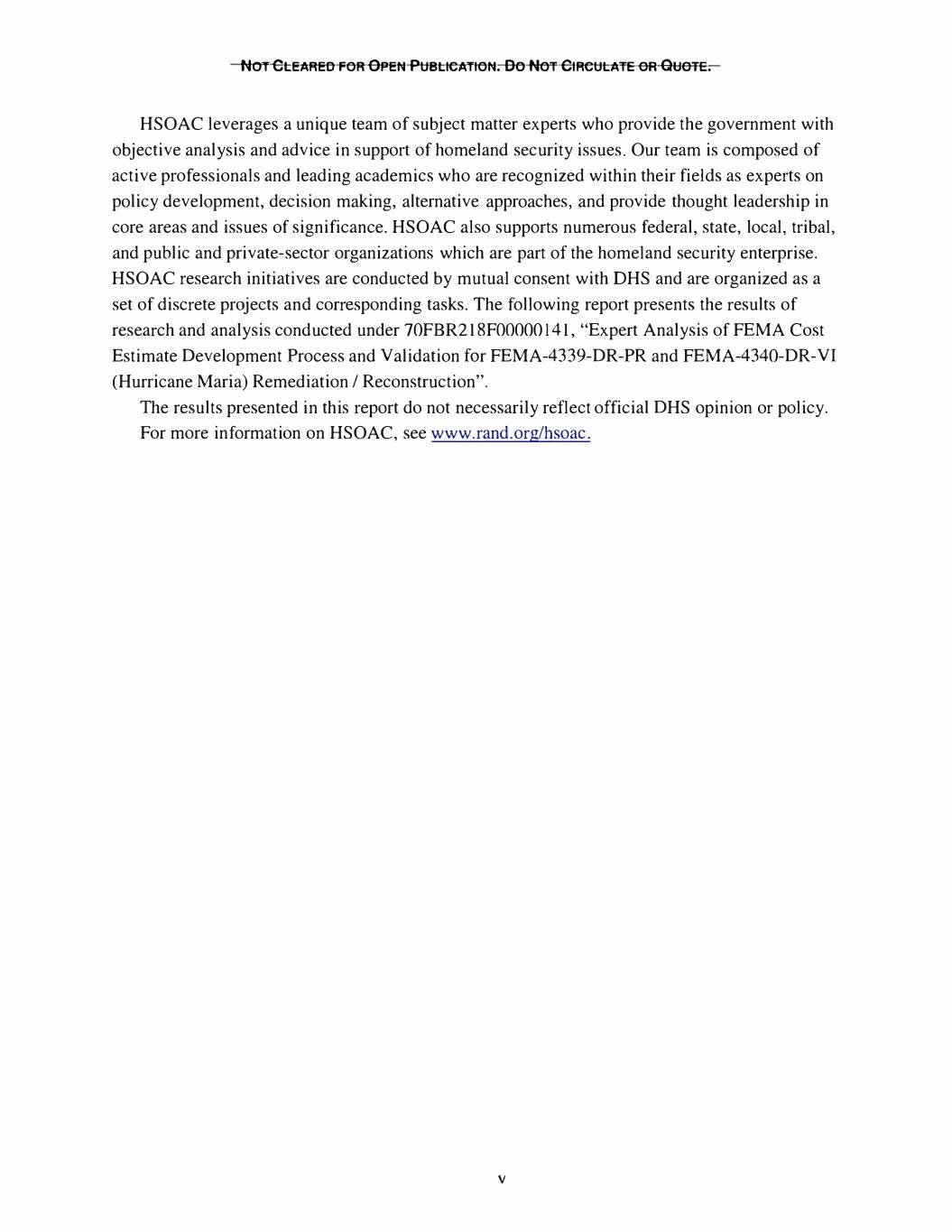
NOT CLEARED FOR OPEN PUBLICATION. 00 NOT CIRCULATE OR QUOTE. HSOAC leverages a unique team of subject matter experts who provide the government with objective analysis and advice in support of homeland security issues. Our team is composed of active professionals and leading academics who are recognized within their fields as experts on policy development, decision making, alternative approaches, and provide thought leadership in core areas and issues of significance. HSOAC also supports numerous federal, state, local, tribal, and public and private-sector organizations which are part of the homeland security enterprise. HSOAC research initiatives are conducted by mutual consent with OHS and are organized as a set of discrete projects and corresponding tasks. The following report presents the results of research and analysis conducted under 70FBR218F00000141, "Expert Analysis of FEMA Cost Estimate Development Process and Validation forFEMA-4339-DR-PR and FEMA-4340-DR-VI (Hurricane Maria) Remediation/ Reconstruction". The results presented in this report do not necessarily reflect official DHS opinion or policy. For more information on HSOAC, see www.rand.org/hsoac. V
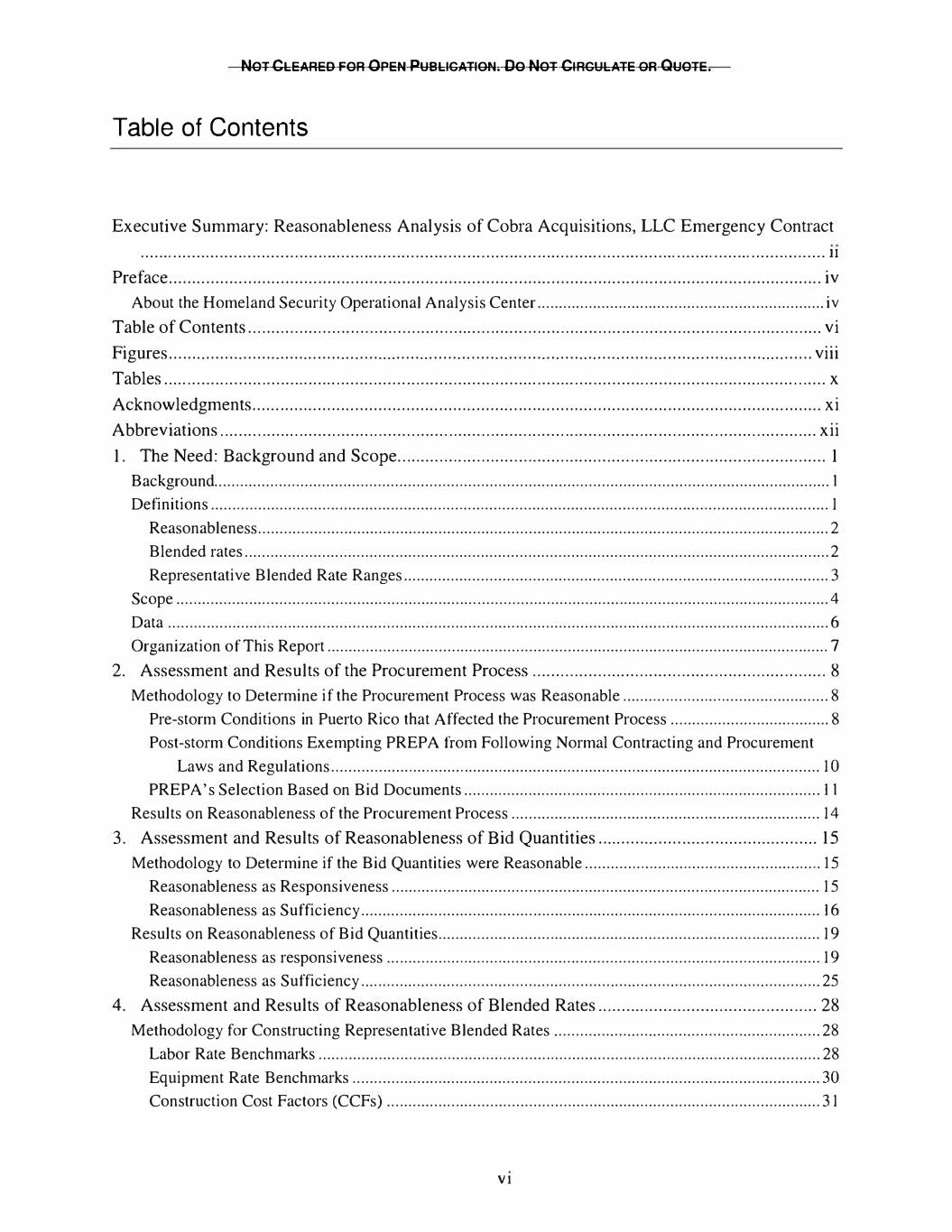
NOT CLEARED FOR OPEN PUBLICATlml. Do NOT CIRCULATE OR QUOTE. Table of Contents Executive Summary: Reasonableness Analysis of Cobra Acquisitions, LLC Emergency Contract ................................................................................................................................................... 11 Preface............................................................................................................................................ iv Table of Contents ........................................................................................................................... vi About the Homeland Security Operational Analysis Center ................................................................... iv Figures .......................................................................................................................................... viii Tables .............................................................................................................................................. x Acknowledgments.......................................................................................................................... xi Abbreviations ................................................................................................................................ xii 1. The Need: Background and Scope.......................... .................................................................. 1 Background............................................................................................................................................... 1 Definitions ................................................................................................................................................ 1 Reasonableness ..................................................................................................................................... 2 Blended rates ........................................................................................................................................ 2 Representative Blended Rate Ranges ................................................................................................... 3 Scope ........................................................................................................................................................ 4 Data .......................................................................................................................................................... 6 2. Assessment and Results of the Procurement Process ............................................................... 8 Organization of This Report ..................................................................................................................... 7 Methodology to Determine if the Procurement Process was Reasonable ................................................ 8 Pre-storm Conditions in Puerto Rico that Affected the Procurement Process ..................................... 8 Post-storm Conditions Exempting PREPA from Following Normal Contracting and Procurement Laws and Regulations .................................................................................................................. 10 PREPA's Selection Based on Bid Documents ................................................................................... 11 3. Assessment and Results of Reasonableness of Bid Quantities ............................................... 15 Results on Reasonableness of the Procurement Process ........................................................................ 14 Methodology to Determine if the Bid Quantities were Reasonable ....................................................... 15 Reasonableness as Responsiveness .................................................................................................... 15 Reasonableness as Sufficiency ........................................................................................................... 16 Results on Reasonableness of Bid Quantities ......................................................................................... 19 Reasonableness as responsiveness ..................................................................................................... 19 4. Assessment and Results of Reasonableness of Blended Rates ............................................... 28 Reasonableness as Sufficiency ........................................................................................................... 25 Methodology for Constructing Representative Blended Rates .............................................................. 28 Labor Rate Benchmarks ..................................................................................................................... 28 Equipment Rate Benchmarks ............................................................................................................. 30 Construction Cost Factors (CCFs) ..................................................................................................... 31 Vl
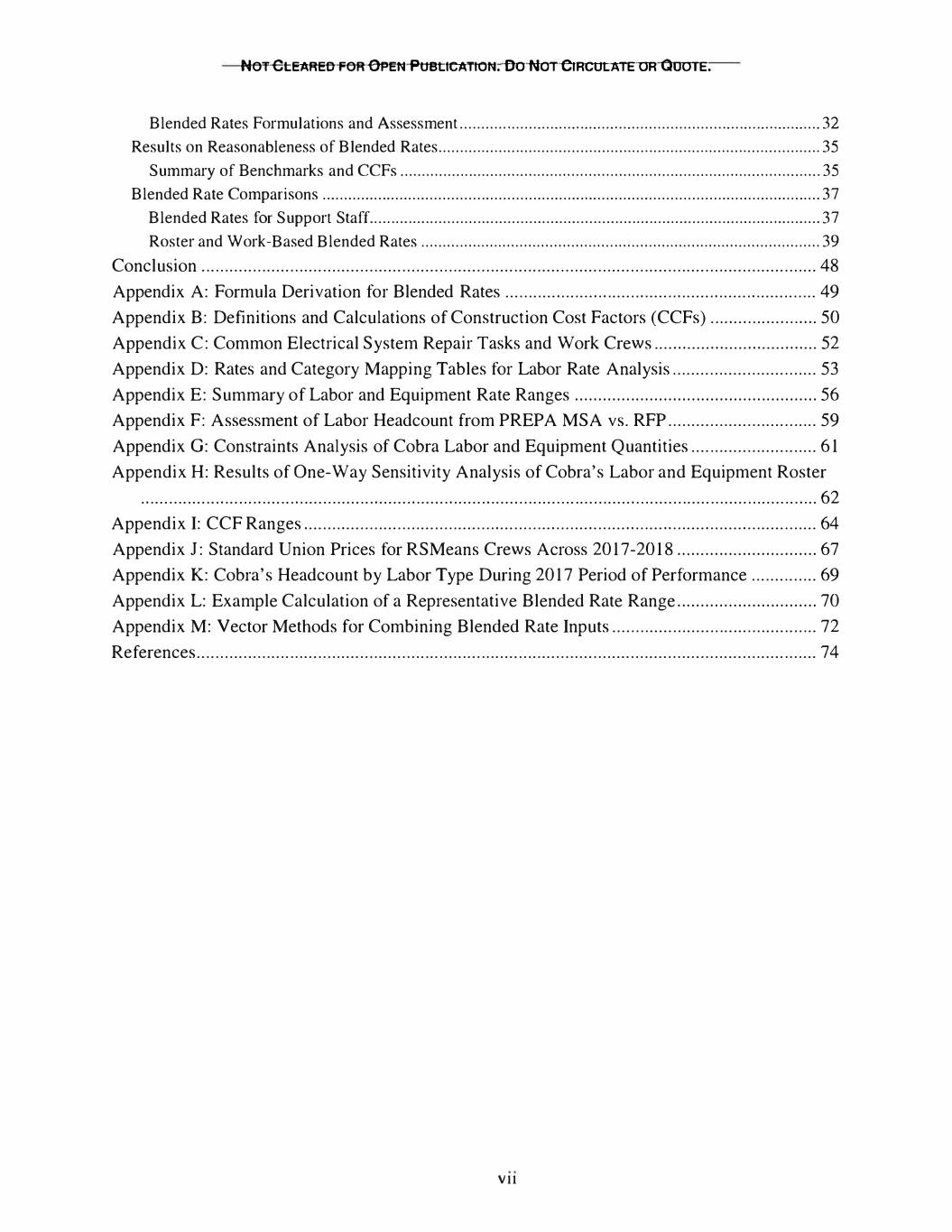
NOT CLEARED FOR OPEN PUBLICATION. Do NOT CIRCULATE OR QuoIE. Blended Rates Formulations and Assessment .................................................................................... 32 Results on Reasonableness of Blended Rates ......................................................................................... 35 Summary of Benchmarks and CCFs .................................................................................................. 35 Blended Rate Comparisons .................................................................................................................... 37 Blended Rates for Support Staff......................................................................................................... 37 Roster and Work-Based Blended Rates ............................................................................................. 39 Conclusion .................................................................................................................................... 48 Appendix A: Formula Derivation forBlended Rates ................................................................... 49 Appendix B: Definitions and Calculations of Construction Cost Factors (CCFs) ....................... 50 Appendix C: Common Electrical System Repair Tasks and Work Crews ................................... 52 Appendix D: Rates and Category Mapping Tables for Labor Rate Analysis ............................... 53 Appendix E: Summary of Labor and Equipment Rate Ranges .................................................... 56 Appendix F: Assessment of Labor Headcount from PREPA MSA vs. RFP ................................ 59 Appendix G: Constraints Analysis of Cobra Labor and Equipment Quantities ........................... 61 Appendix H: Results of One-Way Sensitivity Analysis of Cobra's Labor and Equipment Roster ................................................................................................................................................. 62 Appendix I: CCF Ranges .............................................................................................................. 64 Appendix J: Standard Union Prices forRSMeans Crews Across 2017-2018 .............................. 67 Appendix K: Cobra's Headcount by Labor Type During 2017 Period of Performance .............. 69 Appendix L: Example Calculation of a Representative Blended Rate Range .............................. 70 Appendix M: Vector Methods for Combining Blended Rate Inputs ............................................ 72 References ..................................................................................................................................... 74 Vll

NOT CLEARED FOA OPEN PUBLICATION. 00 NOT CIRCULATE OR QUOTE. Figures Figure 1.1 Illustration of the Composition of a Blended Rate ........................................................ 3 Figure 1.2 Illustration of Ranges forRepresentative Blended Rates .............................................. 4 Figure 2.1 Timeline of Events that Led to the Cobra Contracts ..................................................... 9 Figure 3.1 Graphical Timeline of Key Events Surrounding Initial Delivery of Crew and Equipment in 2017 (Source: Cobra Daily Reports) .............................................................. 24 Figure 3.2 Cobra Headcount by Labor Type (Linemen, Security, Logistics, Management) Based on 2017 Cobra Invoices ........................................................................................................ 25 Figure 4.1 Comparison of Cobra Blended Rates to Representative Ranges forSupport Staff.... 38 Figure 4.2 Comparison of Cobra's "Blended Rate, skilled linemen and equipment" to Representative Ranges forRoster-Based Models without Support Staffand Equipment without Fuel .......................................................................................................................... 40 Figure 4.3 Comparison of Cobra's "Total Rate per Blended Lineman" to Representative Ranges forRoster-Based Models with Support Staffand Equipment without Fuel ......................... 40 Figure 4.4 Comparison of Cobra's "Blended Rate, skilled lineman and equipment" to Representative Ranges forHigh Voltage System Repairs on Flat Tenain without Support Staffand Equipment without Fuel ........................................................................................ 41 Figure 4.5 Comparison of Cobra's "Total Rate per Blended Lineman" to Representative Ranges for High Voltage System Repairs on Flat Terrain with Support Staff and Equipment without Fuel ....................................................................................................................................... 41 Figure 4.6 Comparison of Cobra's "Blended Rate, skilled lineman and equipment" to Representative Ranges forHigh Voltage System Repairs on Rugged Tena.in without Support Staffand Equipment without Fuel .......................................................................... 42 Figure 4.7 Comparison of Cobra's "Total Rate per Blended Lineman" to Representative Ranges for High Voltage System Repairs on Rugged Terrain with Support Staffand Equipment without Fuel .......................................................................................................................... 43 Figure 4.8 Comparison of Cobra's "Blended Rate, skilled linemen and equipment" to Representative Ranges forRoster-Based Models without Support Staff and Equipment with Fuel ....................................................................................................................................... 44 Figure 4.9 Comparison of Cobra's "Total Rate per Blended Lineman" to Representative Ranges for Roster-Based Models with Support Staff and Equipment with Fuel .............................. 44 Figure 4.10 Comparison of Cobra's "Blended Rate, skilled lineman and equipment" to Representative Ranges forHigh Voltage System Repairs on Flat Terrain without Support Staffand Equipment with Fuel ............................................................................................. 45 Vlll
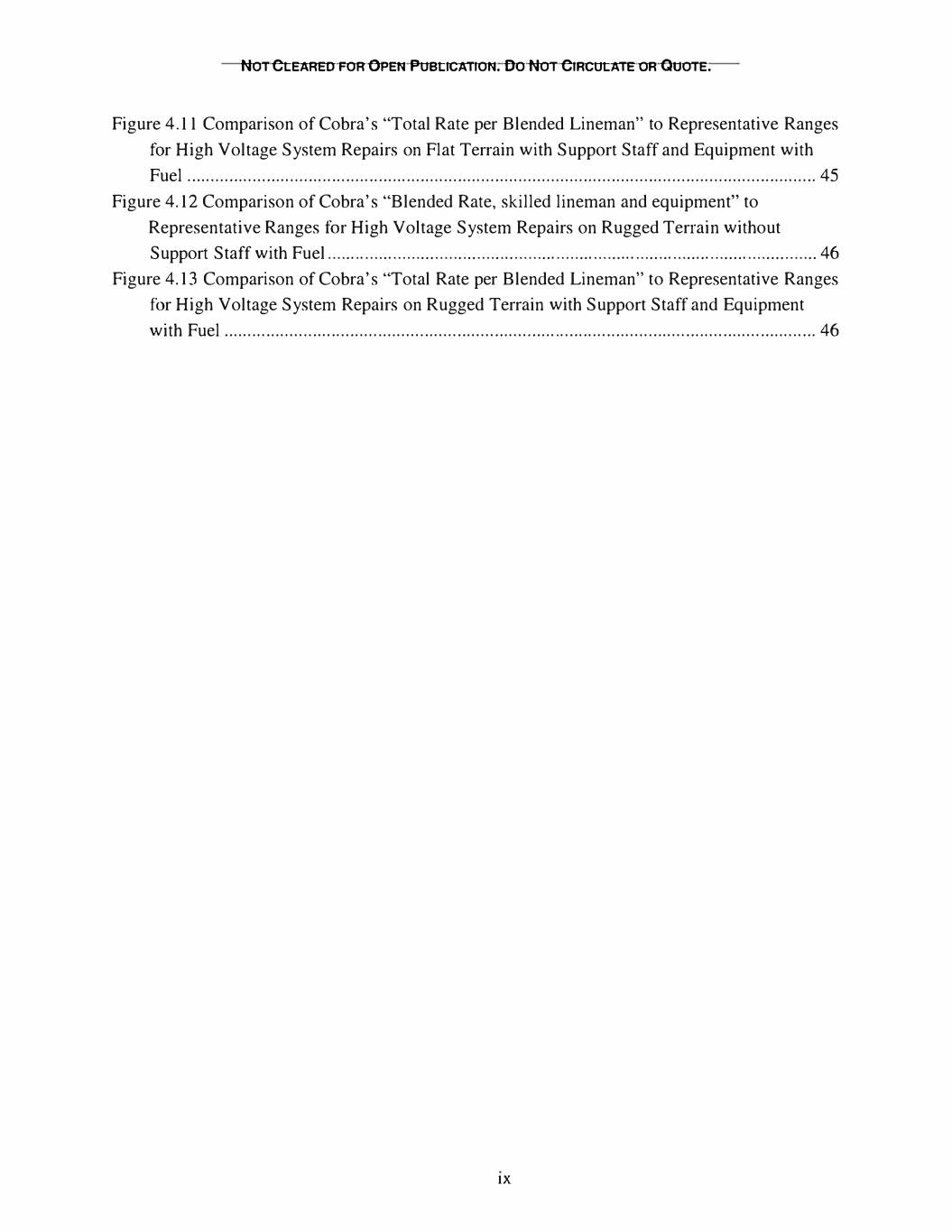
NOT CLEARED FOR OPEN PUBLICATION. Do NOT CIRCULATE OR QUOTE. Figure 4.11 Comparison of Cobra's "Total Rate per Blended Lineman" to Representative Ranges for High Voltage System Repairs on Flat Terrain with Support Staffand Equipment with Fuel ....................................................................................................................................... 45 Figure 4.12 Comparison of Cobra's "Blended Rate, skilled lineman and equipment" to Representative Ranges forHigh Voltage System Repairs on Rugged Terrain without Support Staff with Fuel ......................................................................................................... 46 Figure 4.13 Comparison of Cobra's "Total Rate per Blended Lineman" to Representative Ranges for High Voltage System Repairs on Rugged Terrain with Support Staffand Equipment with Fuel ............................................................................................................................... 46 IX
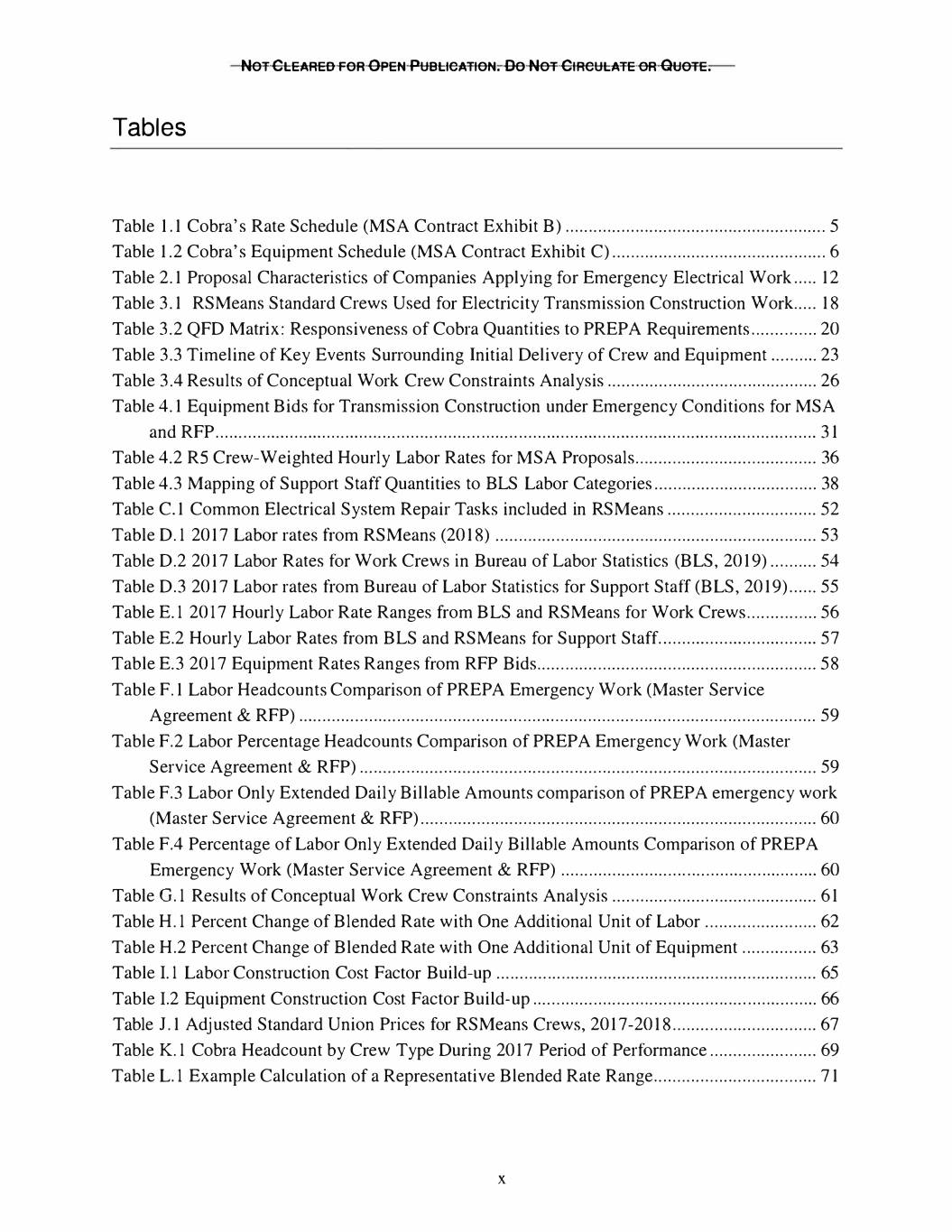
NOT CLEARED FOR OPEN PUBLICATION. 00 NOT CIRCULATE OR QUOTE. Tables Table 1.1 Cobra's Rate Schedule (MSA Contract Exhibit B) ........................................................ 5 Table 1.2 Cobra's Equipment Schedule (MSA Contract Exhibit C) .............................................. 6 Table 2.1 Proposal Characteristics of Companies Applying forEmergency Electrical Work ..... 12 Table 3.1 RSMeans Standard Crews Used for Electricity Transmission Construction Work..... 18 Table 3.2 QFD Matrix: Responsiveness of Cobra Quantities to PREP A Requirements .............. 20 Table 3.3 Timeline of Key Events Surrounding Initial Delivery of Crew and Equipment .......... 23 Table 3.4 Results of Conceptual Work Crew Constraints Analysis ............................................. 26 Table 4.1 Equipment Bids for Transmission Construction under Emergency Conditions forMSA and RFP ................................................................................................................................. 31 Table 4.2 RS Crew-Weighted Hourly Labor Rates forMSA Proposals....................................... 36 Table 4.3 Mapping of Support StaffQuantities to BLS Labor Categories ................................... 38 Table C. 1 Common Electrical System Repair Tasks included in RS Means ................................ 52 Table D.1 2017 Labor rates fromRSMeans (2018) ..................................................................... 53 Table D.2 2017 Labor Rates for Work Crews in Bureau of Labor Statistics (BLS, 2019) .......... 54 Table D.3 2017 Labor rates fromBureau of Labor Statistics for Support Staff (BLS, 2019) ...... 55 Table E.1 2017 Hourly Labor Rate Ranges fromBLS and RSMeans forWork Crews............... 56 Table E.2 Hourly Labor Rates fromBLS and RSMeans for Support Staff. ................................. 57 Table E.3 2017 Equipment Rates Ranges from RFP Bids............................................................ 58 Table F.1 Labor Headcounts Comparison of PREPA Emergency Work (Master Service Agreement & RFP) ............................................................................................................... 59 Table F.2 Labor Percentage Headcounts Comparison of PREP A Emergency Work (Master Service Agreement & RFP) .................................................................................................. 59 Table F.3 Labor Only Extended Daily Billable Amounts comparison of PREP A emergency work (Master Service Agreement & RFP) ..................................................................................... 60 Table F.4 Percentage of Labor Only Extended Daily Billable Amounts Comparison of PREP A Emergency Work (Master Service Agreement & RFP) ....................................................... 60 Table G .1 Results of Conceptual Work Crew Constraints Analysis ............................................ 61 Table H.1 Percent Change of Blended Rate with One Additional Unit of Labor ........................ 62 Table H.2 Percent Change of Blended Rate with One Additional Unit of Equipment ................ 63 Table 1.1 Labor Construction Cost Factor Build-up ..................................................................... 65 Table 1.2 Equipment Construction Cost Factor Build-up ............................................................. 66 Table J.1 Adjusted Standard Union Prices for RSMeans Crews, 2017-2018 ............................... 67 Table K.1 Cobra Headcount by Crew Type During 2017 Period of Performance ....................... 69 Table L.1 Example Calculation of a Representative Blended Rate Range ................................... 71 X
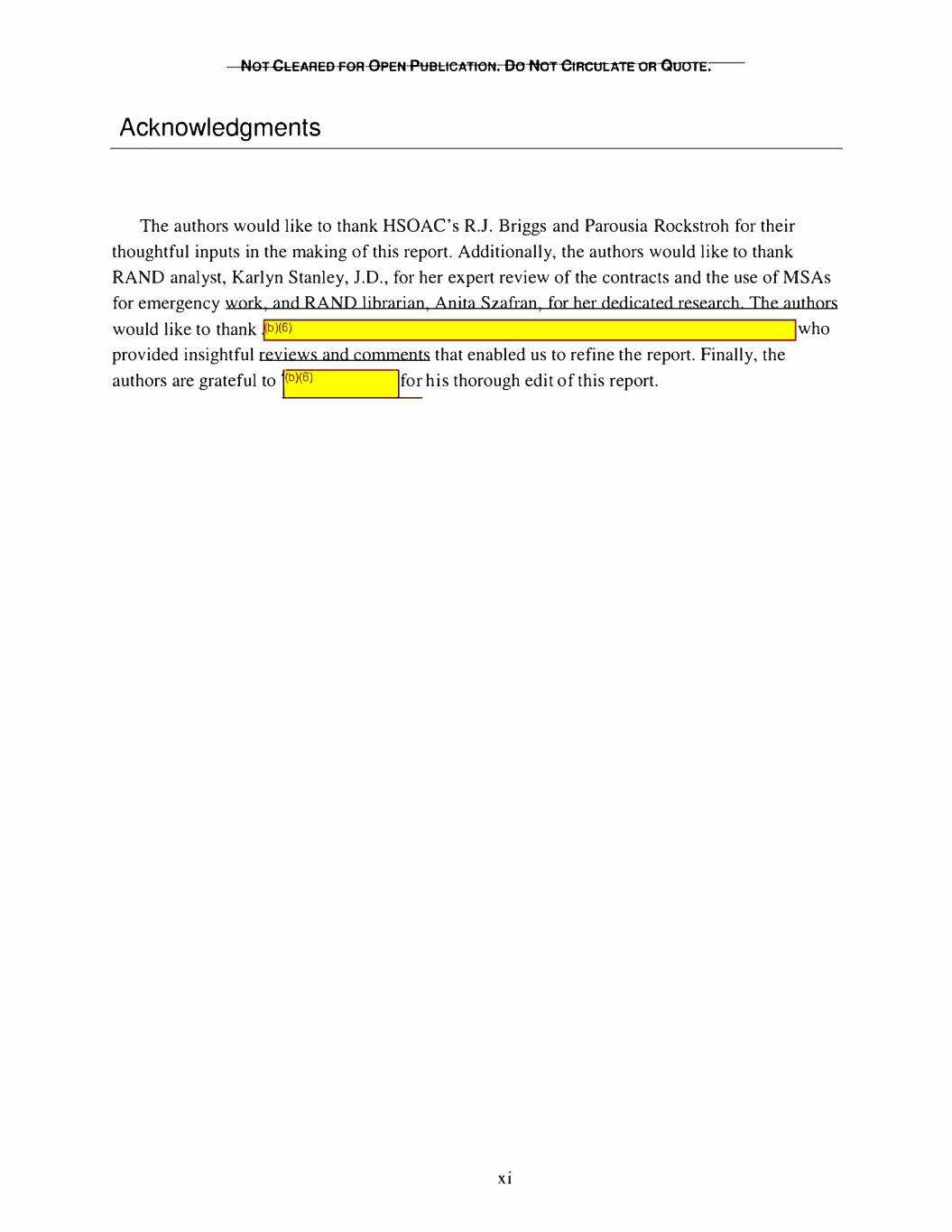
NOT CLEARED FOR OPEN PUBLICATION. Do NOT CIRCULATE OR QuoIE. Acknowledgments The authors would like to thank HSOAC's R.J. Briggs and Parousia Rockstroh fortheir thoughtful inputs in the making of this report. Additionally, the authors would like to thank RAND analyst, Karlyn Stanley, J.D., for her expert review of the contracts and the use of MSAs for emergency work, and RAND librarian, Anita Szafran, for her dedicated research. The authors would like to thank b)(6) who provided insightful reviews and comments that enabled us to refine the report. Finally, the 6l authors are grateful to 1(b)( !forhis thorough edit of this report. XI
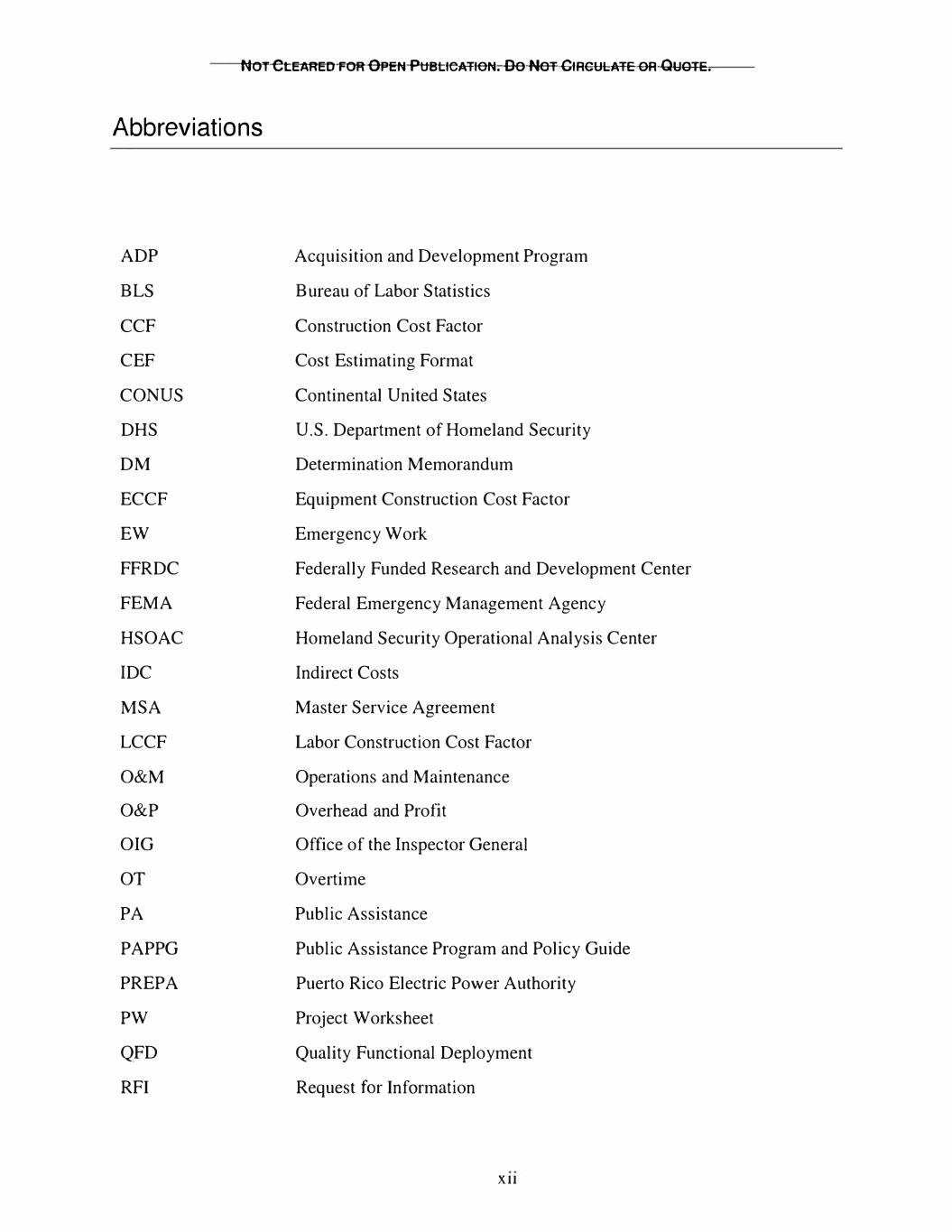
NOT CtEAFIEDFOR OPEN PUBLICATION. Do NOT CIRCULATE OR QUOTE. Abbreviations ADP Acquisition and Development Program BLS Bureau of Labor Statistics CCF Construction Cost Factor CEF Cost Estimating Format CONUS Continental United States DHS U.S. Department of Homeland Security DM Determination Memorandum ECCF Equipment Construction Cost Factor EW Emergency Work FFRDC Federally Funded Research and Development Center FEMA Federal Emergency Management Agency HSOAC Homeland Security Operational Analysis Center IDC Indirect Costs MSA Master Service Agreement LCCF Labor Construction Cost Factor O&M Operations and Maintenance O&P Overhead and Profit OIG Office of the Inspector General OT Overtime PA Public Assistance PAPPG Public Assistance Program and Policy Guide PREPA Puerto Rico Electric Power Authority PW Project Worksheet QFD Quality Functional Deployment RFI Request forInformation XII
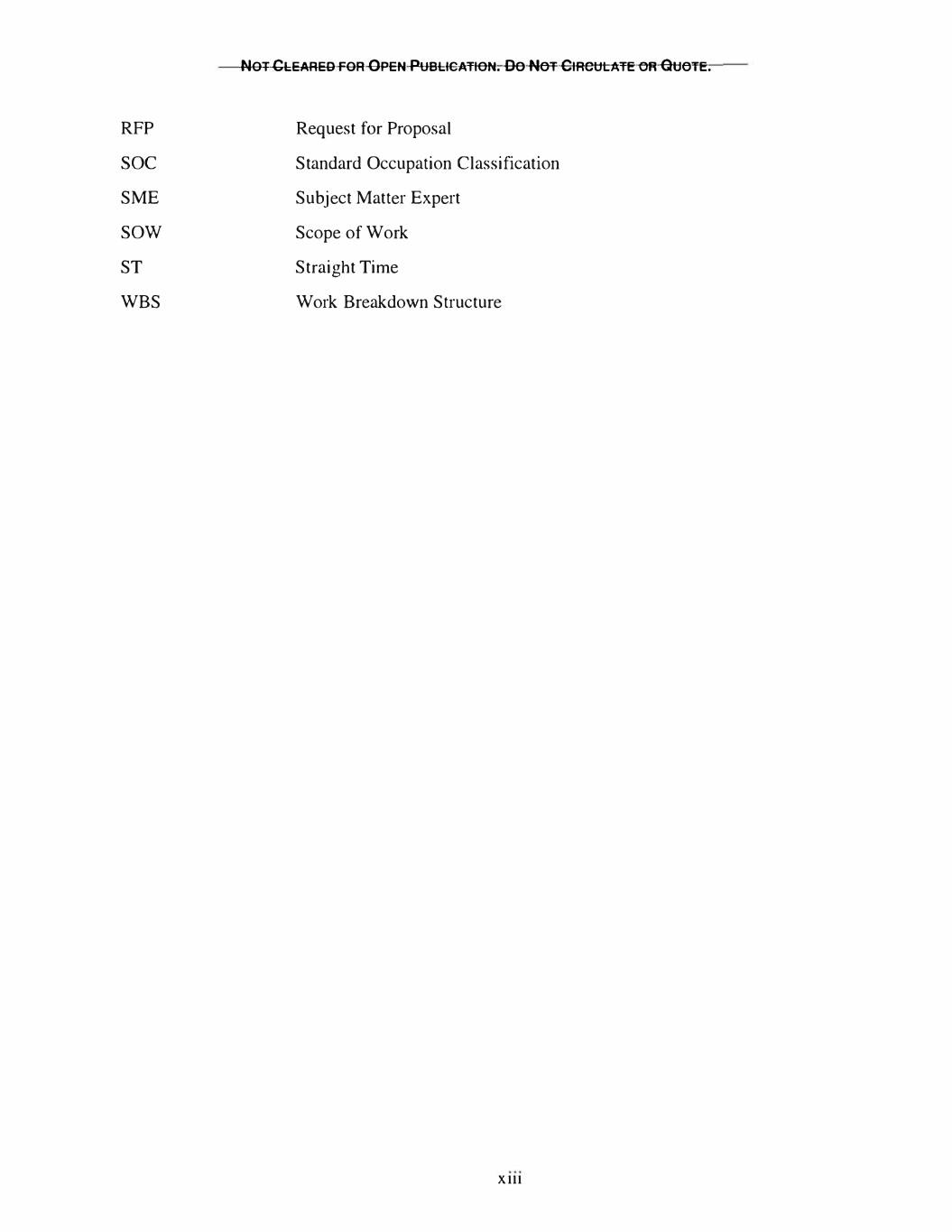
NOT CLEARED FOR OPEN PUBLICATION. 00 NOT CIRCULATE OR QUOTE. RFP Request for Proposal soc Standard Occupation Classification SME Subject Matter Expert sow Scope of Work ST Straight Time WBS Work Breakdown Structure Xlll

NOT CLEARED FOR OPEN PUBLICATION. 00 NOT CIRCULATE OR QUOTE. 1. The Need: Background and Scope Background On September 20, 2017, Puerto Rico was impacted by Hurricane Maria, causing widespread damage to the power infrastructure (Government of Puerto Rico, 2018). The Puerto Rico Electric Power Authority (PREP A) is the primary provider of electricity on the island and is required to undergo a comprehensive review of cost reasonableness prior to receiving FEMA funding for labor and equipment procurements (U.S. Department of Homeland Security, 2018a, 2018b ). In the wake of Hurricane Maria, PREPA sought to obtain fastand effective contractor support to repair the electrical system and restore power. In the first iteration, PREP A issued the contract opportunity under a Master Service Agreement (MSA). An MSA is a general business agreement which describes the terms that a government entity or contracting organization must comply with to be considered eligible for a given contract opportunity. 5 Following an evaluation of six submitted proposals, PREP A awarded the contract to Cobra Acquisitions, LLC (Cobra) under an MSA to deliver emergency repairs to PREPA's electric system. The contract was dated October 19, 2017 and was defined as valid fora period of 12 months or an expenditure ceiling of $200 million, whichever event occurred first. PREPA retained the option to renew the terms of the agreement on a month-to-month basis (PREP A, 2017b). On December 22, 2017, FEMA produced a Determination Memorandum (DM) that found 6 the MSA contract to be reasonable. The Office of the Inspector General (OIG) verbally questioned the conclusions in the DM due to a lack of supporting analysis. As a result, the Federal Emergency Management Agency (FEMA) requested that the Homeland Security Operational and Analysis Center (HSOAC) perform a detailed independent assessment of the reasonableness of Cobra's MSA. Definitions HSOAC assessed the reasonableness of the Cobra MSA contract through complementary qualitative and quantitative analyses that considered FEMA definitions and industry standards. 5 Note this general business agreement appears in FEMA documents, i.e. a document on FEMA cooperatives in Texas, https://comptroller.texas.gov/purchasing/docs/txmas/fema-cooperative.pdf. In general an MSA is a short term contract. In February 2018, PREPA initiated a request for proposals (RFP) process for additional restoration of electrical services. 6 Analysis provided by FEMA to HSOAC. Eligibility Determination Memorandum Applicant, PA ID 000 UA2QU OO FEMA-4339-DR-PR. Project Worksheet 00251. Dec 22, 2017. 1

NOT CLEARED FOR OPEN PUBLICATIO►I. Do NOT CIRCULATE OR QUOTE In this section, we provide definitions of reasonableness in light of FEMA policy guidance and introduce terms we refer to when assessing the reasonableness of Cobra's blended rates. Reasonableness Per FEMA's definition, "a cost is reasonable if, in its nature and amount, it does not exceed that which would be incurred by a prudent person under the circumstances prevailing at the time the decision was made to incur the cost" (U.S. Department of Homeland Security, 2018c). When examined froma contract procurement perspective, we define reasonableness as compliance with the established practices and policies regarding PREPA's circumstantial incurrence of cost. In our quantitative analysis, HSOAC defined the reasonableness of blended rates as being appropriate to the scope of services under the MSA and falling within a range of representative blended rate estimates as illustrated in Figure 1.2 and discussed further below. Blended rates Blended rates express total resource costs (e.g. labor and equipment) per labor headcount 7. In this analysis, blended rates are calculated according to a function that combines labor and equipment quantities, base rates (e.g., hourly labor rate, or daily equipment rate) and an adjustment factor that produces a rate composite to be billed according to the number of linemen for a given day. The adjustment factor applied in the calculation is called a construction cost factor (CCF) in this report. A derivation of the blended rate equation is provided in Appendix A and the calculation of a CCF is in Appendix B. Cobra proposed two blended rates forhigh voltage electrical repair services. The "Blended 4 Rate, skilled lineman and equipment" proposed by Cobra amounts to rb)( ) I per person, per day; this rate covers both the lineman daily wages and daily equipment costs incurred by Cobra for high voltage repair services. Cobra also proposed the "Total Rate per Blended Lineman" which includes the additional cost of support staffand living expenses, for a total amount of �per person, per day. Support staff perform management, logistics and security functions in support of the electrical repairs by skilled linemen. The denominator for both of these blended rates is the number of linemen in the workforce proposed by Cobra (250 linemen). Figure 1.1 illustrates the composition of these blended rates, according to data from Cobra's proposal (see Table 1.1.) 7In general, the Blended Daily Rate= (Labor Daily Total Cost+ Equipment Daily Total Cost)/ Labor Headcount. 2

NOT CtEAFIEDF0Ft OPEN PUBLICATION. Do NOT CIRCULATE OR QUOTE. Figure 1.1 Illustration of the Composition of a Blended Rate b)(4) Total $1,563,000 Representative Blended Rate Ranges We assess reasonableness of Cobra's blended rates after comparing them to a range of representative blended rates. We judge a blended rate to be reasonable if it falls within a range of blended rates that represent the variation observed across benchmark data, adjusted by appropriate construction cost factors, and for labor and equipment quantities appropliate to high voltage system repair tasks, as illustrated in Figure 1.2. Benchmarks forequipment and labor are derived from industry standard databases such as RSMeans, Bureau of Labor Statistics, and competitive bid data. Benchmarks are adjusted by CCFs that account for overhead, profit, contingencies, risk and indirect costs (IDC) that comprise a fully burdened wage according to published guidance fromFEMA (U.S. Department of Homeland Security, 2009). A representative range intends to accommodate variation among the above factors to reflect a range of current market prices for similar goods and services relevant to high voltage system repair. Because Cobra did not provide details on how labor and equipment quantities would be applied to perform repair services, we developed several scenarios relevant to electrical system repair and computed several representative blended rate ranges for comparison to Cobra's proposed rates. An example calculation of a blended rate range is provided for a common work 3
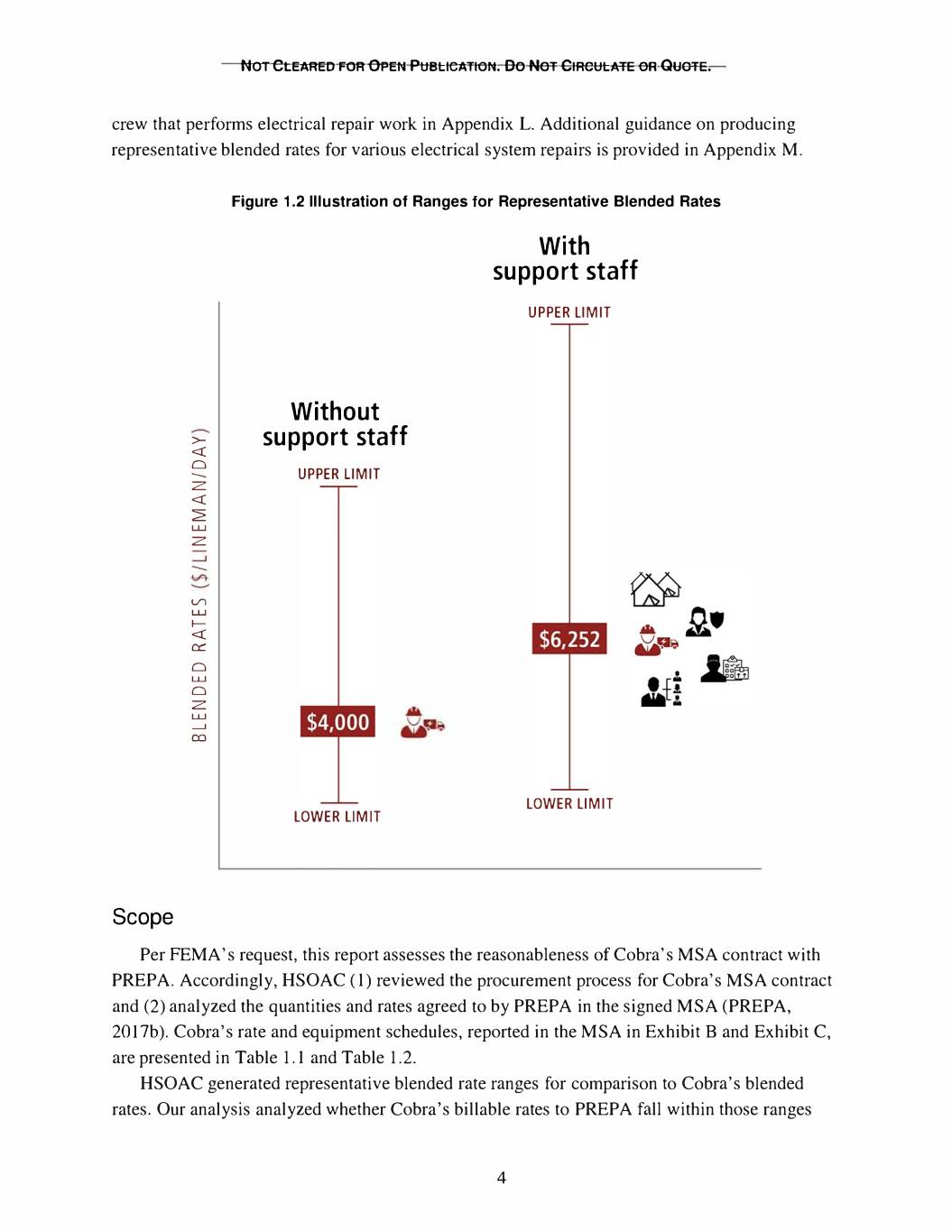
NOT CtEAFIEDFOFI OPEi� PUBLICATION. Do NOT CIRCULATE OR QUOTE. crew that performselectrical repair work in Appendix L. Additional guidance on producing representative blended rates forvaiious electrical system repairs is provided in Appendix M. Figure 1.2 Illustration of Ranges for Representative Blended Rates With support staff UPPER LIMIT Without > <( support staff 0 -z UPPER LIMIT <( � LU z Vl LU f <( a::: 0 LU 0 z LU __J co LOWER LIMIT LOWER LIMIT Scope Per FEMA' s request, this report assesses the reasonableness of Cobra's MSA contract with PREPA. Accordingly, HSOAC (1) reviewed the procurement process forCobra's MSA contract and (2) analyzed the quantities and rates agreed to by PREPA in the signed MSA (PREPA, 2017b). Cobra's rate and equipment schedules, reported in the MSA in Exhibit Band Exhibit C, are presented in Table 1.1 and Table 1.2. HSOAC generated representative blended rate ranges for comparison to Cobra's blended rates. Our analysis analyzed whether Cobra's billable rates to PREPA fall within those ranges 4
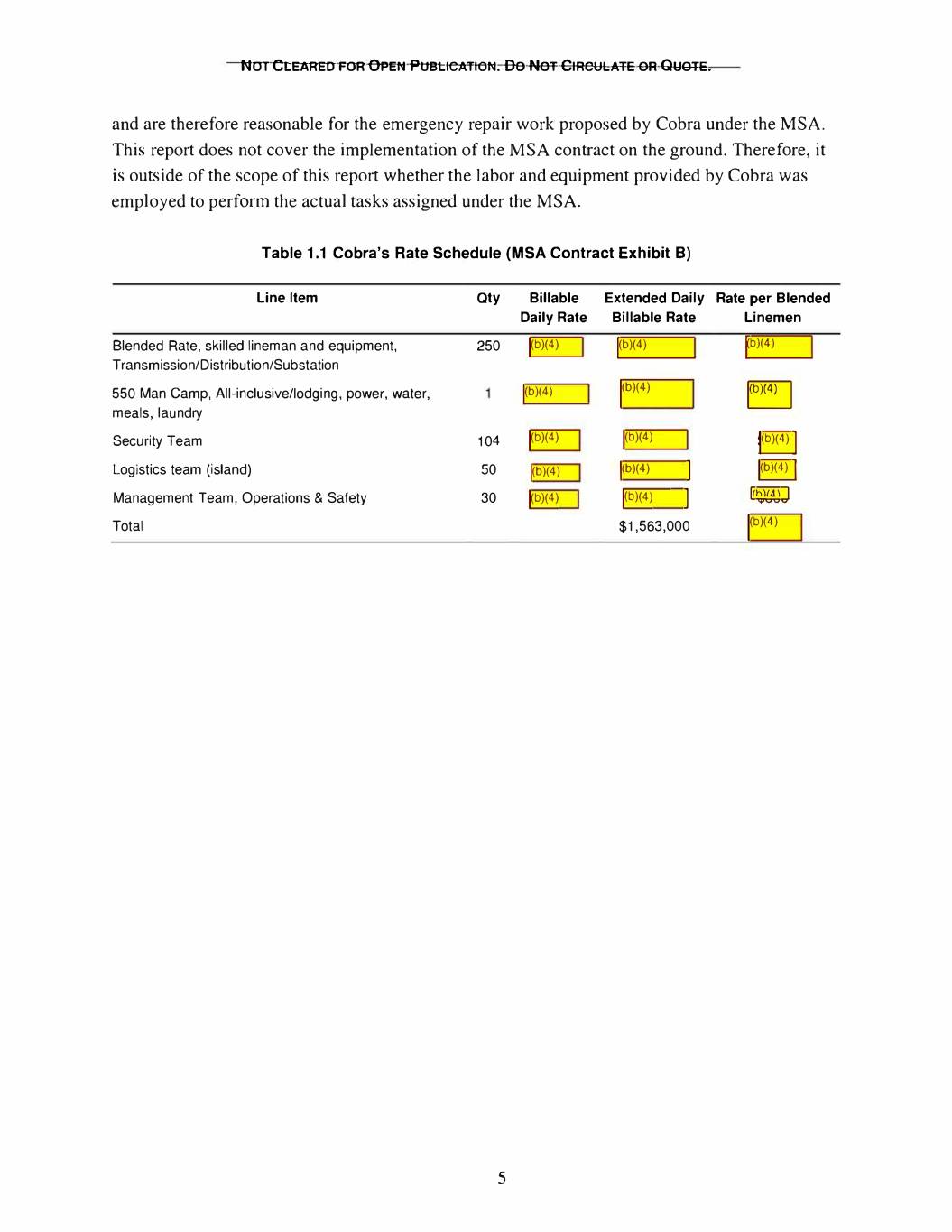
NoI CtEARED FOR OPEN PUBLICATION. Do NOT CIRCULATE OR QUOTE. and are therefore reasonable for the emergency repair work proposed by Cobra under the MSA. This report does not cover the implementation of the MSA contract on the ground. Therefore, it is outside of the scope of this report whether the labor and equipment provided by Cobra was employed to perfmm the actual tasks assigned under the MSA. Table 1.1 Cobra's Rate Schedule (MSA Contract Exhibit B) Line Item Qty Billable Extended Daily Rate per Blended Daily Rate Billable Rate Linemen Blended Rate, skilled lineman and equipment, 250 l(b)(4) (b)(4) b)(4) Transmission/Distribution/Substation l � 550 Man Camp, All-inclusive/lodging, power, water, (b)(4) l(b)(4) l � meals, laundry Security Team 104 l(b)(4) l(b)(4) j(b)(4) I Logistics team (island) 50 l(b)(4) l(b)(4) I l(b)(4) I Management Team, Operations & Safety 30 kWL4J l(b)(4) l(b)(4) I ) Total $1,563,000 l(b)(4) 5
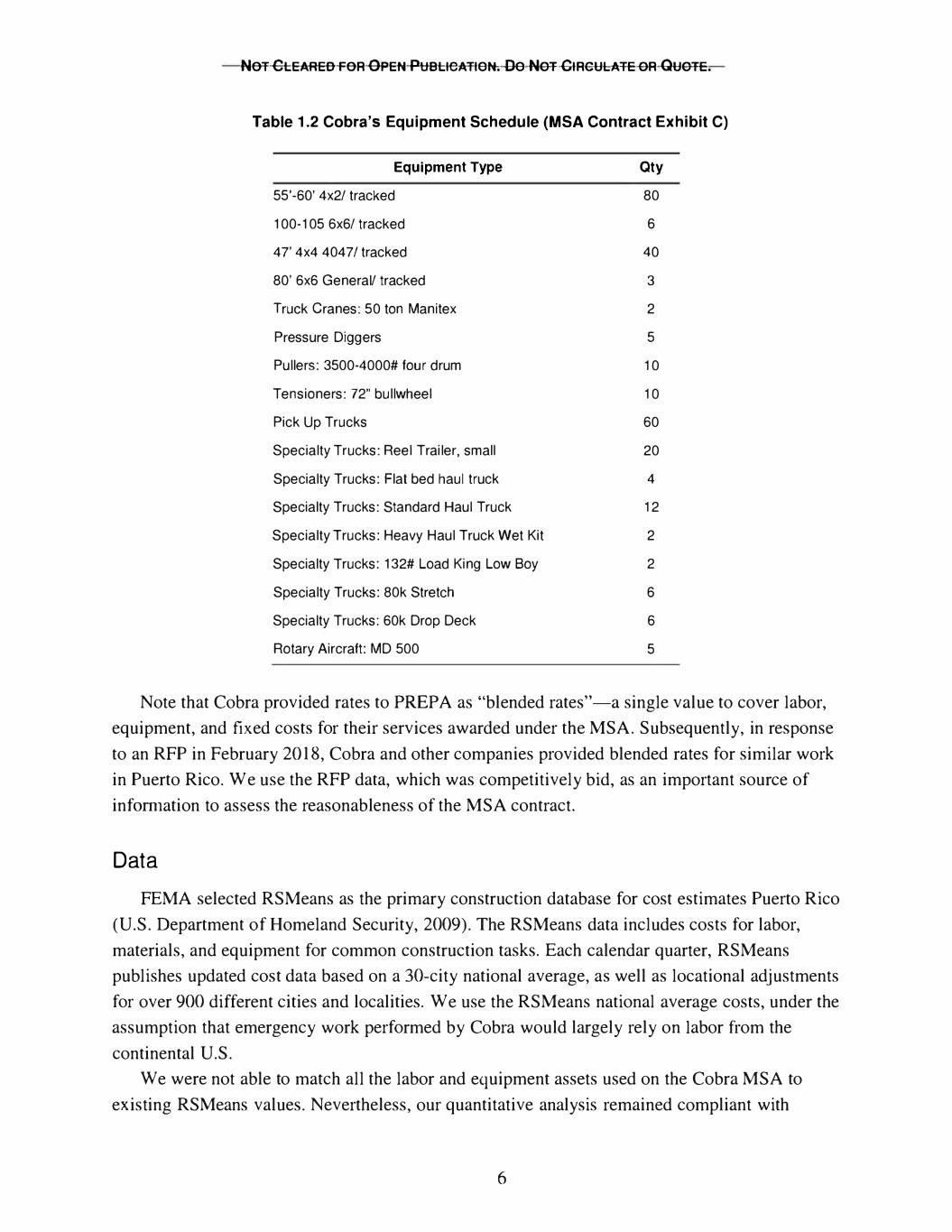
NOT CLEARED FOR OPEN PUBLICATlott Do NOT CIRCULATE OR QUOTE. Table 1.2 Cobra's Equipment Schedule (MSA Contract Exhibit C) Equipment Type Qty 55' -60' 4x2/ tracked 80 100-105 6x6/ tracked 6 47' 4x4 4047/ tracked 40 80' 6x6 General/ tracked 3 Truck Cranes: 50 ton Manitex 2 Pressure Diggers 5 Pullers: 3500-4000# four drum 10 Tensioners: 72" bullwheel 10 Pick Up Trucks 60 Specialty Trucks: Reel Trailer, small 20 Specialty Trucks: Flat bed haul truck 4 Specialty Trucks: Standard Haul Truck 12 Specialty Trucks: Heavy Haul Truck Wet Kit 2 Specialty Trucks: 132# Load King Low Boy 2 Specialty Trucks: 80k Stretch 6 Specialty Trucks: 60k Drop Deck 6 Rotary Aircraft: MD 500 5 Note that Cobra provided rates to A as "blended rates"-a single value to cover labor, equipment, and fixed costs for their services awarded under the MSA. Subsequently, in response PREP to an RFP in February 2018, Cobra and other companies provided blended rates forsimilar work in Puerto Rico. We use the RFP data, which was competitively bid, as an important source of infom1ation to assess the reasonableness of the MSA contract. Data FEMA selected RSMeans as the primary construction database for cost estimates Puerto Rico (U.S. Department of Homeland Security, 2009). The RSMeans data includes costs for labor, materials, and equipment for common construction tasks. Each calendar quarter, RSMeans publishes updated cost data based on a 30-city national average, as well as locational adjustments for over 900 different cities and localities. We use the RSMeans national average costs, under the assumption that emergency work performed by Cobra would largely rely on labor from the continental U.S. We were not able to match all the labor and equipment assets used on the Cobra MSA to existing RSMeans values. Nevertheless, our quantitative analysis remained compliant with 6
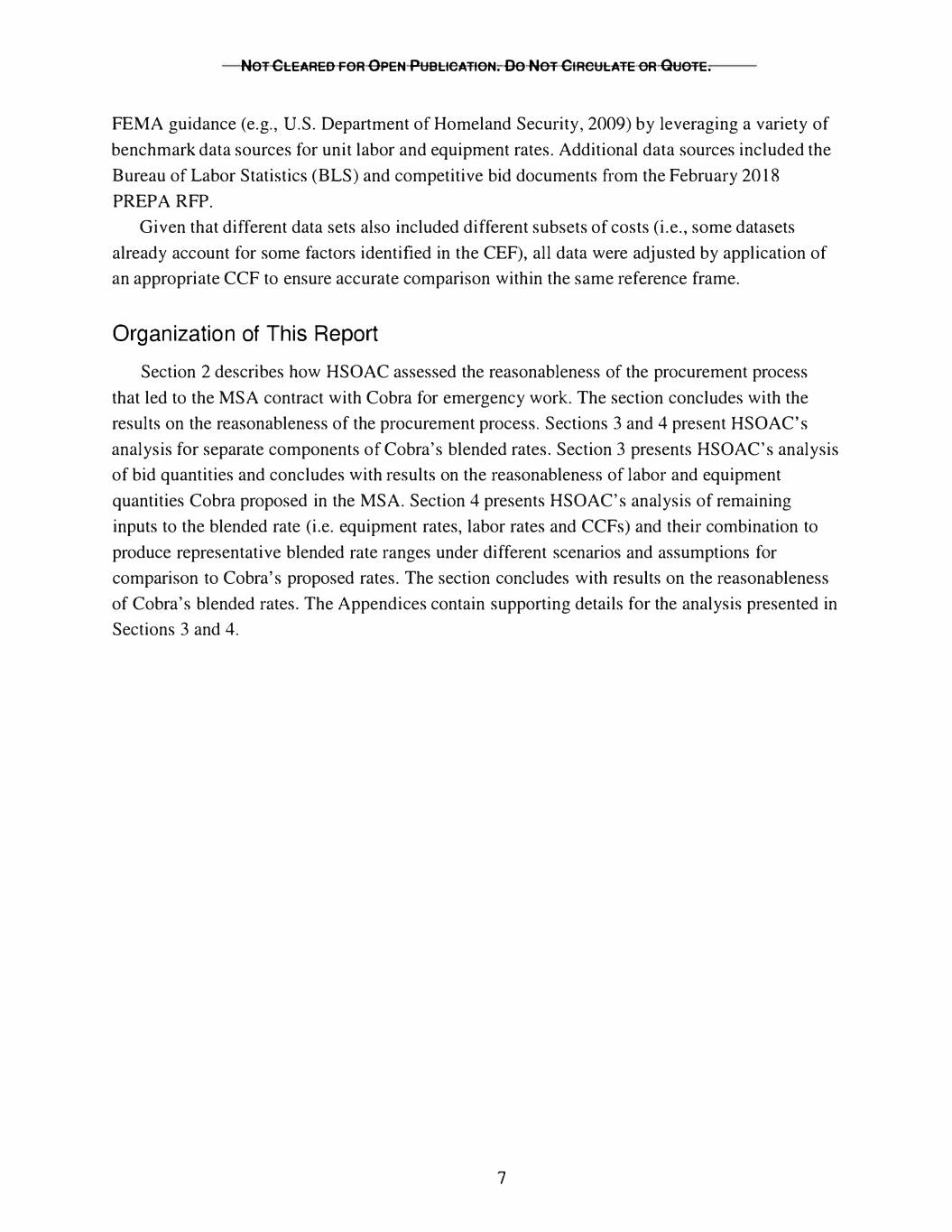
NOT CLEARED FOR OPEN PUBLICATION. 00 NOT CIRCULATE OR QUOTE. FEMA guidance (e.g., U.S. Department of Homeland Security, 2009) by leveraging a variety of benchmark data sources forunit labor and equipment rates. Additional data sources included the Bureau of Labor Statistics (BLS) and competitive bid documents fromthe February 2018 PREPA RFP. Given that differentdata sets also included different subsets of costs (i.e., some datasets already account for some factorsidentified in the CEF), all data were adjusted by application of an appropriate CCF to ensure accurate comparison within the same reference frame. Organization of This Report Section 2 describes how HSOAC assessed the reasonableness of the procurement process that led to the MSA contract with Cobra for emergency work. The section concludes with the results on the reasonableness of the procurement process. Sections 3 and 4 present HSOAC's analysis for separate components of Cobra's blended rates. Section 3 presents HSOAC's analysis of bid quantities and concludes with results on the reasonableness of labor and equipment quantities Cobra proposed in the MSA. Section 4 presents HSOAC's analysis of remaining inputs to the blended rate (i.e. equipment rates, labor rates and CCFs) and their combination to produce representative blended rate ranges under different scenarios and assumptions for comparison to Cobra's proposed rates. The section concludes with results on the reasonableness of Cobra's blended rates. The Appendices contain supporting details for the analysis presented in Sections 3 and 4. 7
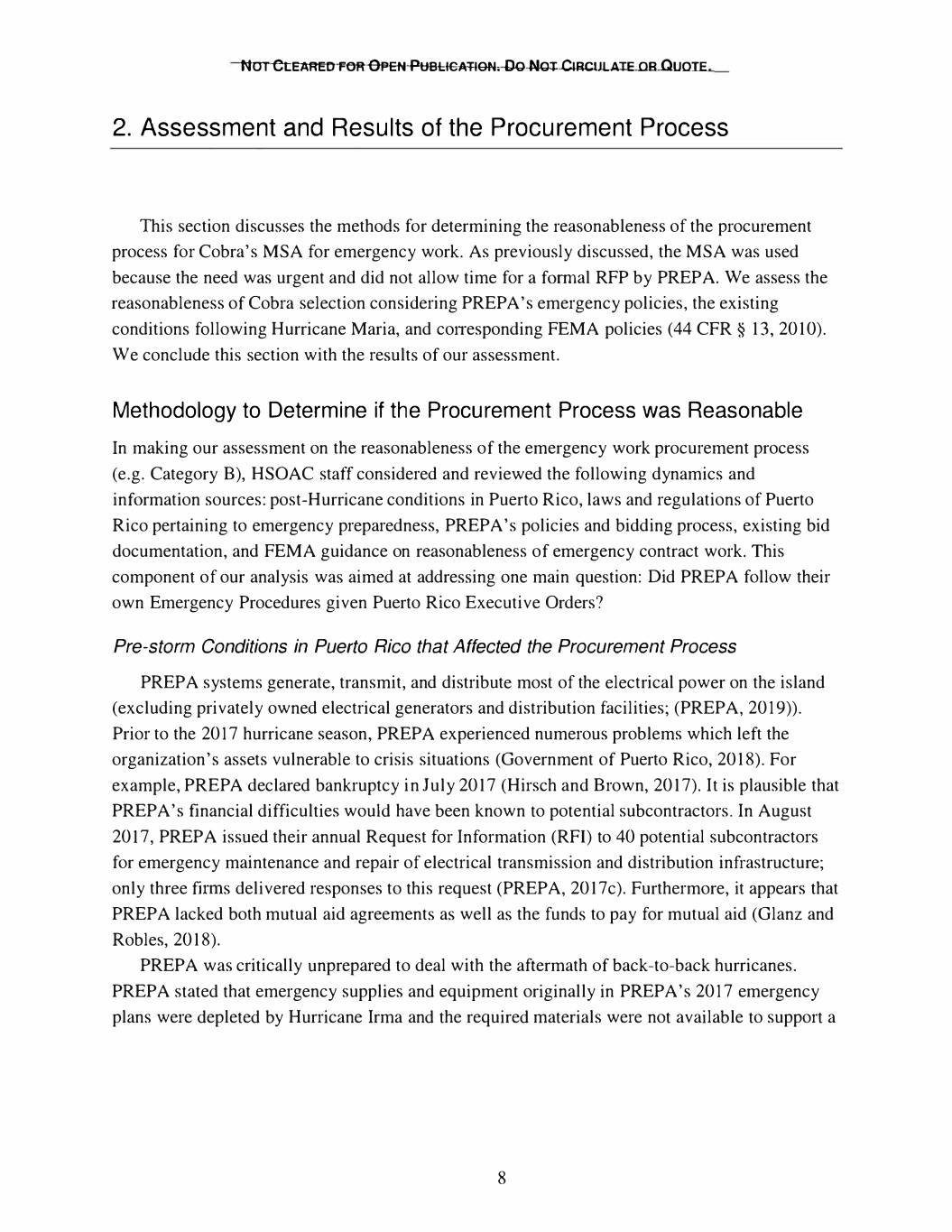
NoI CtEAFIEDFOR OPEN PUBLICATlml. Do NOT CIRCI ILAIE QR QUOTE 2. Assessment and Results of the Procurement Process This section discusses the methods fordetermining the reasonableness of the procurement process forCobra's MSA for emergency work. As previously discussed, the MSA was used because the need was urgent and did not allow time fora fom1al RFP by PREP A. We assess the reasonableness of Cobra selection considering PREPA's emergency policies, the existing conditions following Hurricane Maria, and conesponding FEMA policies (44 CFR § 13, 2010). We conclude this section with the results of our assessment. Methodology to Determine if the Procurement Process was Reasonable In making our assessment on the reasonableness of the emergency work procurement process (e.g. Category B), HSOAC staffconsidered and reviewed the following dynamics and information sources: post-Hurricane conditions in Puerto Rico, laws and regulations of Puerto Rico pertaining to emergency preparedness, PREPA's policies and bidding process, existing bid documentation, and FEMA guidance on reasonableness of emergency contract work. This component of our analysis was aimed at addressing one main question: Did PREPA follow their own Emergency Procedures given Puerto Rico Executive Orders? Pre-storm Conditions in Puerto Rico that Affected the Procurement Process PREPA systems generate, transmit, and distribute most of the electrical power on the island (excluding privately owned electrical generators and distribution facilities; (PREPA, 2019)). Prior to the 2017 hurricane season, PREPA experienced numerous problems which left the organization's assets vulnerable to crisis situations (Government of Puerto Rico, 2018). For example, PREPA declared bankruptcy in July 2017 (Hirsch and Brown, 2017). It is plausible that PREPA's financialdifficulties would have been known to potential subcontractors. In August 2017, PREP A issued their annual Request for Information (RFI) to 40 potential subcontractors foremergency maintenance and repair of electrical transmission and distribution infrastructure; only three films delivered responses to this request (PREPA, 2017c). Furthermore, it appears that PREPA lacked both mutual aid agreements as well as the funds to pay for mutual aid (Glanz and Robles, 2018). PREPA was critically unprepared to deal with the aftermath of back-to-back hurricanes. PREPA stated that emergency supplies and equipment originally in PREPA's 2017 emergency plans were depleted by Hurricane Irma and the required materials were not available to support a 8
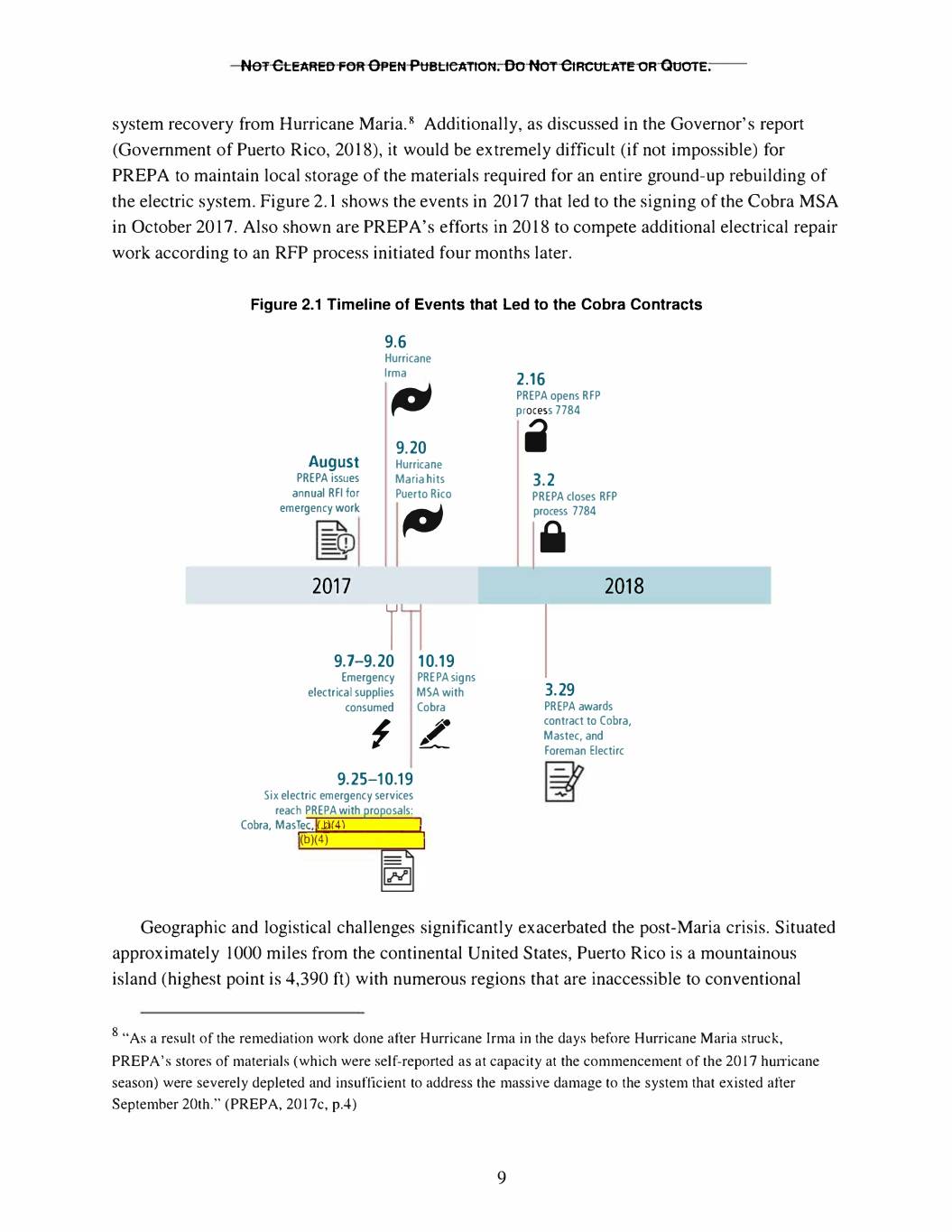
NOT CLEARED FOR OPEN PUBLICATION. Do NOT CIRCULATE OR QUOTE. system recovery from Hurricane Maria. 8 Additionally, as discussed in the Governor's report (Government of Puerto Rico, 2018), it would be extremely difficult (if not impossible) for PREPA to maintain local storage of the materials required for an entire ground-up rebuilding of the electric system. Figure 2.1 shows the events in 2017 that led to the signing of the Cobra MSA in October 2017. Also shown are PREP A's efforts in 2018 to compete additional electTical repair work according to an RFP process initiated four months later. Figure 2.1 Timeline of Events that Led to the Cobra Contracts 9.6 Hurricane Irma 2.16 fOI PREPAopens RFP pr s 7784 9.20 i August Hurricane 3.2 PREPAissues Maria hits annual RFI for Puerto Rico PREPA closes RFP emergency work fOI processi 7784 2017 2018 I 9.7-9.20 10.19 Emergency PRE PAsigns 3.29 electrical supplies MSAwith consumed Cobra PR EPA awards contract to Cobra, � f ,· Mastec, and Foreman Electirc 9.25-10.19 Six electric emergency services reach PREPAwith proposals: Cobra, MasT.ec=, _,lb....l/4 ..... l___ ,.;.(b)(4) ___., Geographic and logistical challenges significantly exacerbated the post-Maria crisis. Situated approximately 1000 miles from the continental United States, Puerto Rico is a mountainous island (highest point is 4,390 ft) with numerous regions that are inaccessible to conventional 8 "As a result of the remediation work done after Hurricane Irma in the days before Hurricane Maria struck, PREP A's stores of materials (which were self-reported as at capacity at the commencement of the 2017 huITicane season) were severely depleted and insufficient to address the massive damage to the system that existed after September 20th." (PREP A, 2017c, p.4) 9
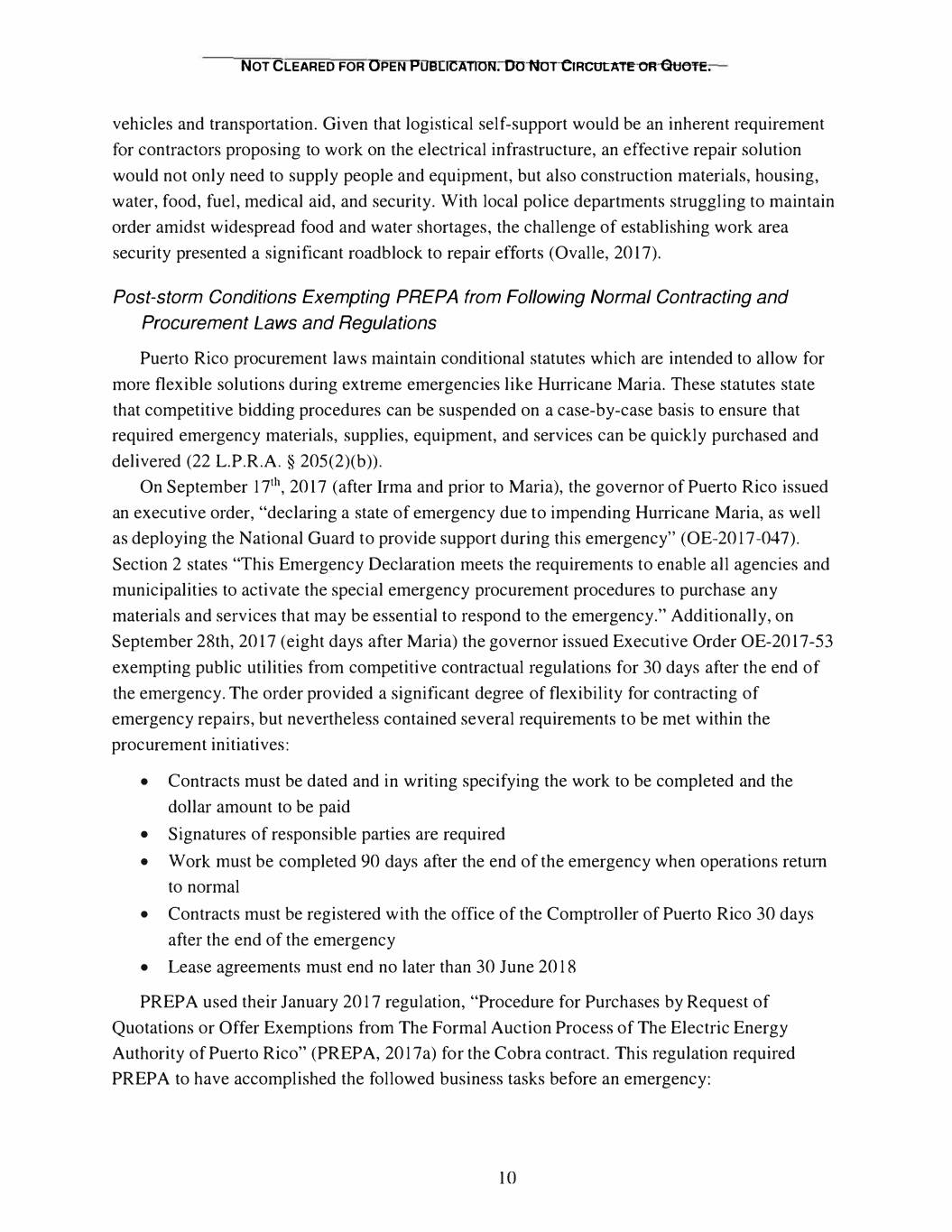
NOT CLEARED FOR OPEN PUBLICATION. Do No I CIRCULATE 0A QUOTE. vehicles and transportation. Given that logistical self-support would be an inherent requirement forcontractors proposing to work on the electrical infrastructure, an effectiverepair solution would not only need to supply people and equipment, but also construction materials, housing, water, food, fuel, medical aid, and security. With local police departments struggling to maintain order amidst widespread foodand water shortages, the challenge of establishing work area security presented a significant roadblock to repair efforts (Ovalle, 2017). Post-storm Conditions Exempting PREPA from Following Normal Contracting and Procurement Laws and Regulations Puerto Rico procurement laws maintain conditional statutes which are intended to allow for more flexible solutions during extreme emergencies like Hurricane Maria. These statutes state that competitive bidding procedures can be suspended on a case-by-case basis to ensure that required emergency materials, supplies, equipment, and services can be quickly purchased and delivered (22 L.P.R.A. § 205(2)(b)). th On September 17 , 2017 (after Irma and prior to Maria), the governor of Puerto Rico issued an executive order, "declaring a state of emergency due to impending Hurricane Maria, as well as deploying the National Guard to provide support during this emergency" (OE-2017-047). Section 2 states 'This Emergency Declaration meets the requirements to enable all agencies and municipalities to activate the special emergency procurement procedures to purchase any materials and services that may be essential to respond to the emergency." Additionally, on September 28th, 2017 (eight days after Maria) the governor issued Executive Order OE-2017-53 exempting public utilities from competitive contractual regulations for 30 days after the end of the emergency. The order provided a significant degree of flexibility for contracting of emergency repairs, but nevertheless contained several requirements to be met within the procurement initiatives: • Contracts must be dated and in writing specifying the work to be completed and the dollar amount to be paid • Signatures of responsible parties are required • Work must be completed 90 days after the end of the emergency when operations return to normal • Contracts must be registered with the office of the Comptroller of Puerto Rico 30 days after the end of the emergency • Lease agreements must end no later than 30 June 2018 PREPA used their January 2017 regulation, "Procedure for Purchases by Request of Quotations or Offer Exemptions fromThe Formal Auction Process of The Electric Energy Authority of Puerto Rico" (PREPA, 2017 a) forthe Cobra contract. This regulation required PREPA to have accomplished the followed business tasks before an emergency: 10
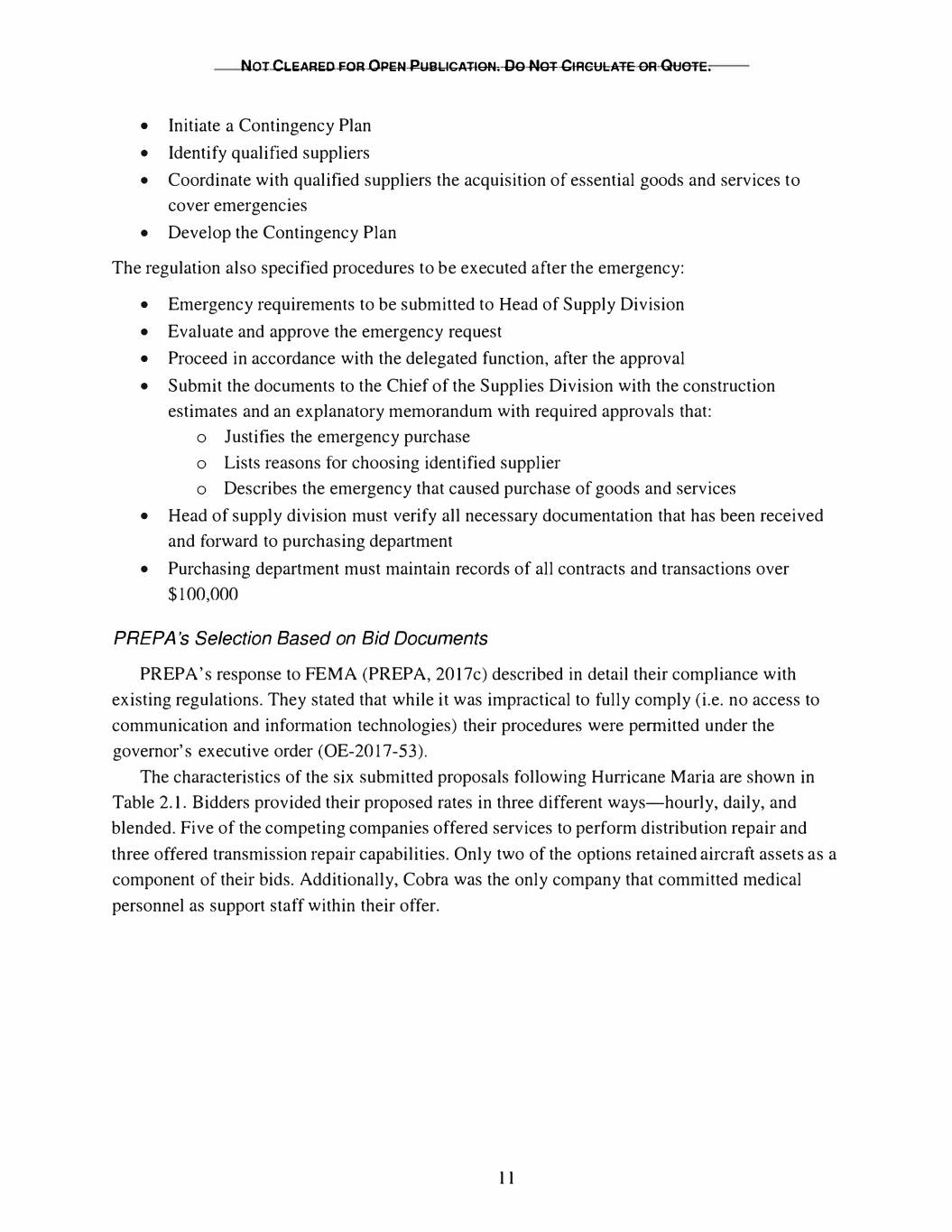
Nor CLEARED FOR OPEN PYElblCATlml. Do NOT CIRCULATEOR QUOTE. • Initiate a Contingency Plan • Identify qualifiedsuppliers • Coordinate with qualified suppliers the acquisition of essential goods and services to cover emergencies • Develop the Contingency Plan The regulation also specified procedures to be executed after the emergency: • Emergency requirements to be submitted to Head of Supply Division • Evaluate and approve the emergency request • Proceed in accordance with the delegated function, after the approval • Submit the documents to the Chief of the Supplies Division with the construction estimates and an explanatory memorandum with required approvals that: o J usti fies the emergency purchase o Lists reasons for choosing identified supplier o Describes the emergency that caused purchase of goods and services • Head of supply division must verify all necessary documentation that has been received and forward to purchasing department • Purchasing department must maintain records of all contracts and transactions over $100,000 PREPA's Selection Based on Bid Documents PREPA's response to FEMA (PREPA, 2017c) described in detail their compliance with existing regulations. They stated that while it was impractical to fully comply (i.e. no access to communication and information technologies) their procedures were pem1itted under the governor's executive order (OE-2017-53). The characteristics of the six submitted proposals following Hurricane Maria are shown in Table 2.1. Bidders provided their proposed rates in three different ways-hourly, daily, and blended. Five of the competing companies offered services to perform distribution repair and three offeredtransmission repair capabilities. Only two of the options retained aircraft assetsas a component of their bids. Additionally, Cobra was the only company that committed medical personnel as support staff within their offer. 11
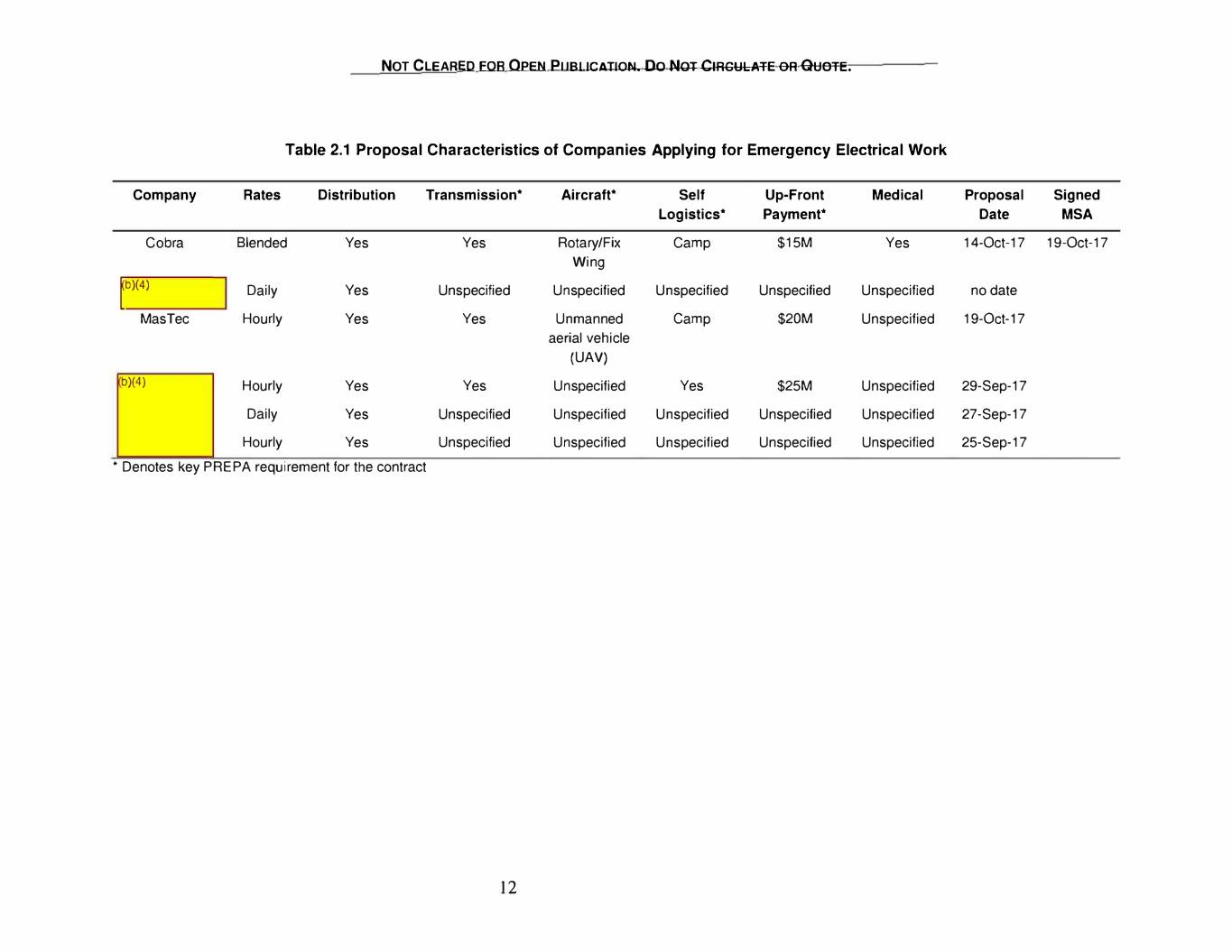
NOT CLEARED FOR OPEN Pl IBI !CATION. Do NOT CIRCULATE OR QUOTE. Table 2.1 Proposal Characteristics of Companies Applying for Emergency Electrical Work Company Rates Distribution Transmission* Aircraft* Self Up-Front Medical Proposal Signed Logistics* Payment* Date MSA Cobra Blended Yes Yes Rotary/Fix Camp $15M Yes 14-Oct-17 19-Oct-17 Wing b)(4) [ Daily Yes Unspecified Unspecified Unspecified Unspecified Unspecified no date MasTec Hourly Yes Yes Unmanned Camp $20M Unspecified 19-Oct-17 aerial vehicle (UAV) b)(4) Hourly Yes Yes Unspecified Yes $25M Unspecified 29-Sep-17 Daily Yes Unspecified Unspecified Unspecified Unspecified Unspecified 27-Sep-17 Hourly Yes Unspecified Unspecified Unspecified Unspecified Unspecified 25-Sep-17 * Denotes key PREPA requirement for the contract 12
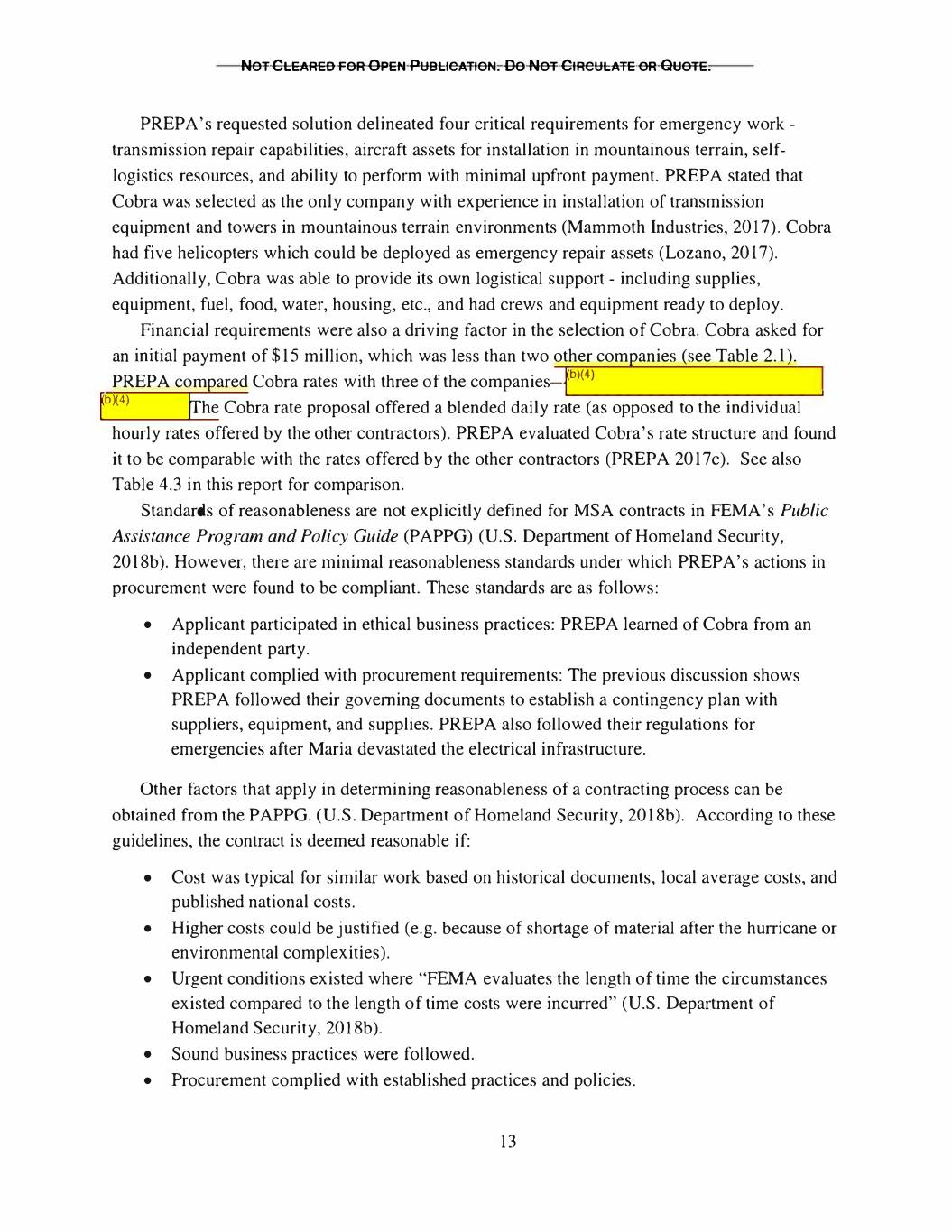
NOT CLEARED FOR OPEN PUBLICATION. 00 NOT CIRCULATE OR QUOTE. PREPA's requested solution delineated four critical requirements for emergency work - transmission repair capabilities, aircraft assets for installation in mountainous terrain, self logistics resources, and ability to perform with minimal upfront payment. PREP A stated that Cobra was selected as the only company with experience in installation of transmission equipment and towers in mountainous terrain environments (Mammoth Industries, 2017). Cobra had five helicopters which could be deployed as emergency repair assets (Lozano, 2017). Additionally, Cobra was able to provide its own logistical support - including supplies, equipment, fuel, food, water, housing, etc., and had crews and equipment ready to deploy. Financial requirements were also a driving factor in the selection of Cobra. Cobra asked for an initial payment of $15 million, which was less than two other companies (see Table 2.1). 4 PREP A compared Cobra rates with three of the companies-fbl( ) 4 fbl( l �he Cobra rate proposal offered a blended daily ra�te-(as_ o_ p_ p_ -os_ed_ _to_ - th_em_ · _ - d-iv- idu- _al_ � hourly rates offered by the other contractors). PREPA evaluated Cobra's rate structure and found it to be comparable with the rates offered by the other contractors (PREPA 2017c). See also Table 4.3 in this report for comparison. Standards of reasonableness are not explicitly defined for MSA contracts in FEMA's Public Assistance Program and Policy Guide (PAPPG) (U.S. Department of Homeland Security, 2018b). However, there are minimal reasonableness standards under which PREPA's actions in procurement were found to be compliant. These standards are as follows: • Applicant participated in ethical business practices: PREPA learned of Cobra from an independent party. • Applicant complied with procurement requirements: The previous discussion shows PREP A followed their governingdocuments to establish a contingency plan with suppliers, equipment, and supplies. PREPA also followed their regulations for emergencies after Maria devastated the electrical infrastructure. Other factors that apply in determining reasonableness of a contracting process can be obtained from the PAPPG. (U.S. Department of Homeland Security, 2018b). According to these guidelines, the contract is deemed reasonable if: • Cost was typical for similar work based on historical documents, local average costs, and published national costs. • Higher costs could be justified (e.g. because of shortage of material after the hurricane or environmental complexities). • Urgent conditions existed where "FEMA evaluates the length of time the circumstances existed compared to the length of time costs were incurred" (U.S. Department of Homeland Security, 2018b). • Sound business practices were followed. • Procurement complied with established practices and policies. 13

NOT CLEARED FOR OPEN PUBLICATION. 00 NOT CIRCULATE OR QUOTE. Results on Reasonableness of the Procurement Process Having examined these aspects regarding the reasonableness of PREPA's emergency procurement process, HSOAC finds that selecting Cobra for the MSA was reasonable considering FEMA policy on emergency situations and existing regulations regarding contracting. PREP A adhered to Puerto Rican legal statutes regarding emergency situations and remained consistent with their own internalpolicies. In consideration of FEMA' s existing requirements on the actions of PREP A, HSOAC noted that FEMA requirements formutual aid agreements9 did not apply at the time the MSA was signed. PREP A explicitly stated they could not rely on these agreements because those organizations required logistical support which PREPA could not supply (PREPA, 2017c). PREPA also noted that the mutual aid agreements after Hurricane Georges in 1998 were of limited value as workers were neither experienced in mountainous repairs nor did they have appropriate assets to conduct related operations (PREPA, 2017c). Thus, PREP A opted for an MSA contract with Cobra. PREP A's selection conforms with the spirit of FEMA' s procurement process standards. Cobra both (1) supplied a labor and equipment forcethat no other competitors offered, and (2) was the lowest upfront cost provider. Because Hurricane Maria did not permit fora delay in response, and in consideration of the standards which were applied in a second round of competitive solicitation, PREPA's actions were consistent with the spilit of FEMA's procurement process standards (U.S. Department of Homeland Security, 2018b). A salient feature ofan MSA is that it establishes the major terms between client and vendor, but with added flexibility to negotiate lesser or other terms, as needed, forindividual work authorizations. As a result, the work is greatly expedited because the client under MSA does not have to go through procurement cycle for every future request. Our Subject Matter Expert (SME) has indicated that MSAs are a standard contracting mechanism used by electric utilities for the conditions under which this Cobra contract was written. 10 Thus, according to this evaluation of the procurement process HSOAC concludes that PREP A engaged in a reasonable procurement process given the circumstances following Hurricane Maria. 9 Mutual aid agreements and assistance agreements are agreements between agencies, organizations, and jurisdictions that provide a mechanism to quickly obtain emergency assistance in the formof personnel, equipment, materials, and other associated services. The primary objective is to facilitaterapid, short-term deployment of emergency support prior to, during, and after an incident. A signed agreement does not obligate the provision or receipt of aid, but rather provides a tool for use should the incident dictate a need. (https://emilms.fema.gov /1S703A/RES0 I 02 l 30text.htm) !email discussion with authors January 2018. 14
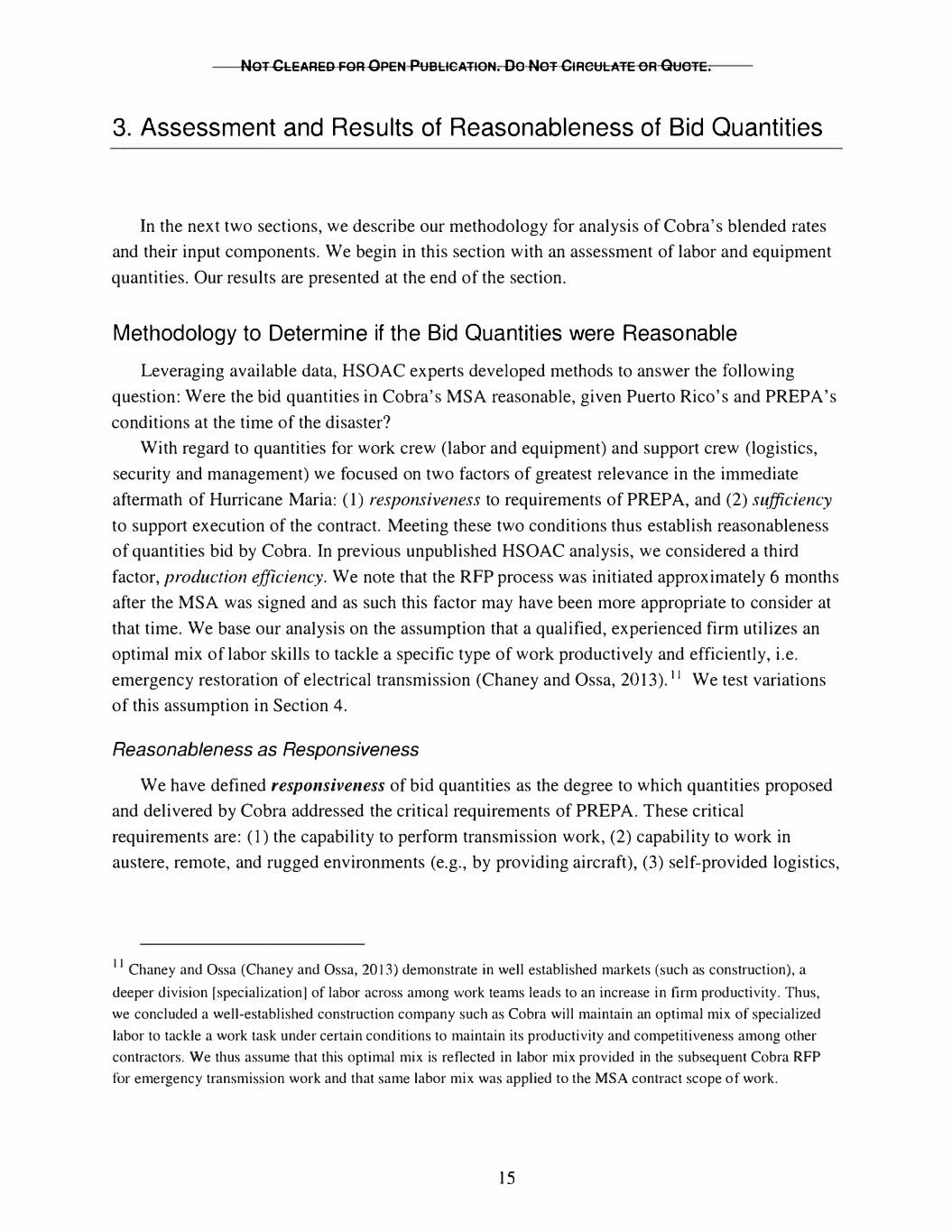
NOT CLEARED FOR OPEN PUBLICATION. 00 NOT CIRCULATE OR QUOTE. 3. Assessment and Results of Reasonableness of Bid Quantities In the next two sections, we describe our methodology for analysis of Cobra's blended rates and their input components. We begin in this section with an assessment of labor and equipment quantities. Our results are presented at the end of the section. Methodology to Determine if the Bid Quantities were Reasonable Leveraging available data, HSOAC experts developed methods to answer the following question: Were the bid quantities in Cobra's MSA reasonable, given Puerto Rico's and PREPA's conditions at the time of the disaster? With regard to quantities for work crew (labor and equipment) and support crew (logistics, security and management) we focused on two factors of greatest relevance in the immediate aftermath of Hurricane Maria: (1) to requirements of PREPA, and (2) to support execution of the contract. Meeting these two conditions thus establish reasonableness responsiveness sufficiency of quantities bid by Cobra. In previous unpublished HSOAC analysis, we considered a third factor, We note that the RFP process was initiated approximately 6 months after the MSA was signed and as such this factor may have been more appropriate to consider at production efficiency. that time. We base our analysis on the assumption that a qualified, experienced firm utilizes an optimal mix of labor skills to tackle a specific type of work productively and efficiently, i.e. emergency restoration of electrical transmission (Chaney and Ossa, 2013). 11 We test variations of this assumption in Section 4. Reasonableness as Responsiveness We have defined responsiveness of bid quantities as the degree to which quantities proposed and delivered by Cobra addressed the critical requirements of PREPA. These critical requirements are: (1) the capability to perform transmission work, (2) capability to work in austere, remote, and rugged environments (e.g., by providing aircraft), (3) self-provided logistics, 11 Chaney and Ossa (Chaney and Ossa, 2013) demonstrate in well established markets (such as construction), a deeper division [specialization] of labor across among work teams leads to an increase in firm productivity. Thus, we concluded a well-established construction company such as Cobra will maintain an optimal mix of specialized labor to tackle a work task under certain conditions to maintain its productivity and competitiveness among other contractors. We thus assume that this optimal mjx is reflected in labor mix provided in the subsequent Cobra RFP for emergency transmission work and that same labor mix was applied to the MSA contract scope of work. 15
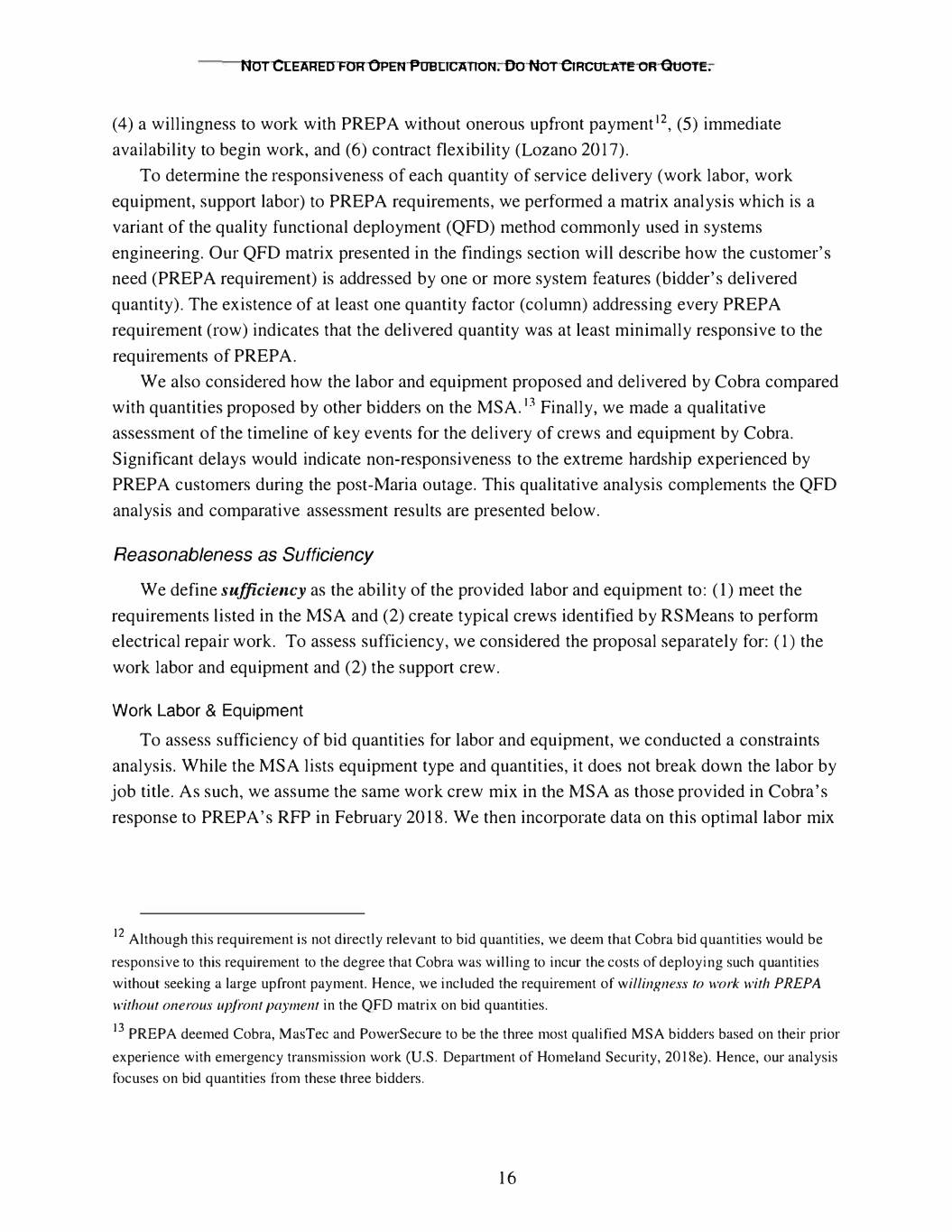
Nor CLEARED FOR OPEN POBLICAIION. DoNOT CIRCULATE OFIQUOTE. 2 (4) a willingness to work with PREPA without onerous upfront payment 1 , (5) immediate availability to begin work, and (6) contract flexibility (Lozano 2017). To determine the responsiveness of each quantity of service delivery (work labor, work equipment, support labor) to PREPA requirements, we performed a matrix analysis which is a variant of the quality functional deployment (QFD) method commonly used in systems engineering. Our QFD matrix presented in the findings section will describe how the customer's need (PREPA requirement) is addressed by one or more system features (bidder's delivered quantity). The existence of at least one quantity factor (column) addressing every PREPA requirement (row) indicates that the delivered quantity was at least minimally responsive to the requirements of PREPA. We also considered how the labor and equipment proposed and delivered by Cobra compared 13 with quantities proposed by other bidders on the MSA. Finally, we made a qualitative assessment of the timeline of key events for the delivery of crews and equipment by Cobra. Significant delays would indicate non-responsiveness to the extreme hardship experienced by PREPA customers during the post-Maria outage. This qualitative analysis complements the QFD analysis and comparative assessment results are presented below. Reasonableness as Sufficiency We define sufficiencyas the ability of the provided labor and equipment to: (1) meet the requirements listed in the MSA and (2) create typical crews identified by RSMeans to perform electrical repair work. To assess sufficiency, we considered the proposal separately for: (1) the work labor and equipment and (2) the support crew. Work Labor & Equipment To assess sufficiency of bid quantities for labor and equipment, we conducted a constraints analysis. While the MSA lists equipment type and quantities, it does not break down the labor by job title. As such, we assume the same work crew mix in the MSA as those provided in Cobra's response to PREPA's RFP in February 2018. We then incorporate data on this optimal labor mix 12 Although this requirement is not directly relevant to bid quantities, we deem that Cobra bid quantities would be responsive to this requirement to the degree that Cobra was willing to incur the costs of deploying such quantities without seeking a large upfront payment. Hence, we included the requirement of willingness to work with PREPA without onerous upfront payment in the QFD matrix on bid quantities. 13 PREPA deemed Cobra, MasTec and PowerSecure to be the three most qualified MSA bidders based on their prior experience with emergency transmission work (U.S. Department of Homeland Security, 20l8e). Hence, our analysis focuses on bid quantities from these three bidders. 16
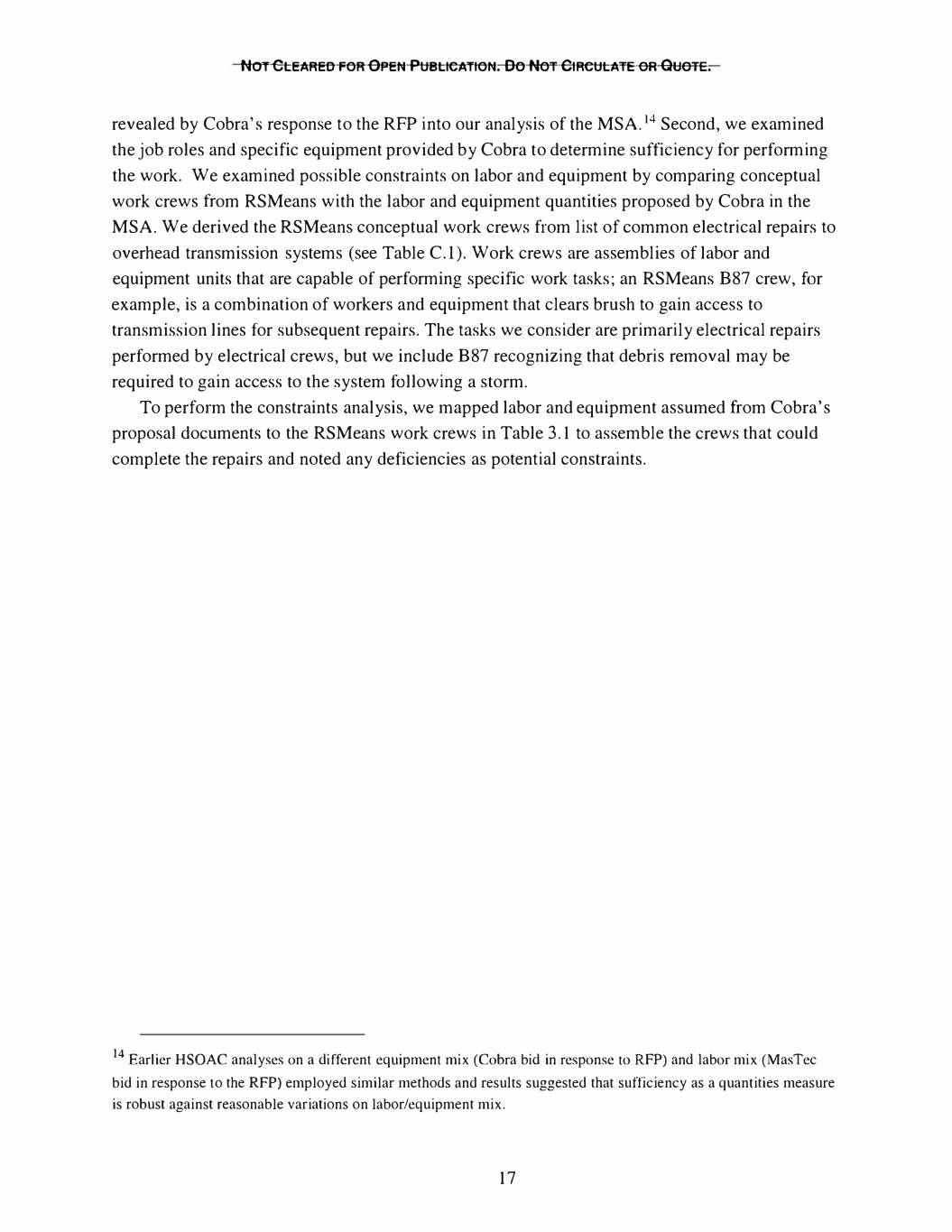
NOT CLEARED FOR OPEN PUBLICATION. 00 NOT CIRCULATE OR QUOTE. revealed by Cobra's response to the RFP into our analysis of the MSA. 14 Second, we examined the job roles and specific equipment provided by Cobra to determine sufficiency for performing the work. We examined possible constraints on labor and equipment by comparing conceptual work crews from RSMeans with the labor and equipment quantities proposed by Cobra in the MSA. We derived the RSMeans conceptual work crews from list of common electrical repairs to overhead transmission systems (see Table C.l). Work crews are assemblies of labor and equipment units that are capable of performing specific work tasks; an RSMeans B87 crew, for example, is a combination of workers and equipment that clears brush to gain access to transmission lines for subsequent repairs. The tasks we consider are primarily electrical repairs performed by electrical crews, but we include B87 recognizing that debris removal may be required to gain access to the system following a storm. To perfo1m the constraints analysis, we mapped labor and equipment assumed fromCobra's proposal documents to the RSMeans work crews in Table 3 .1 to assemble the crews that could complete the repairs and noted any deficiencies as potential constraints. 14 Earlier HSOAC analyses on a different equipment mix (Cobra bid in response to RFP) and labor mix (MasTec bid in response to the RFP) employed similar methods and results suggested that sufficiency as a quantities measure is robust against reasonable variations on labor/equipment mix. 17
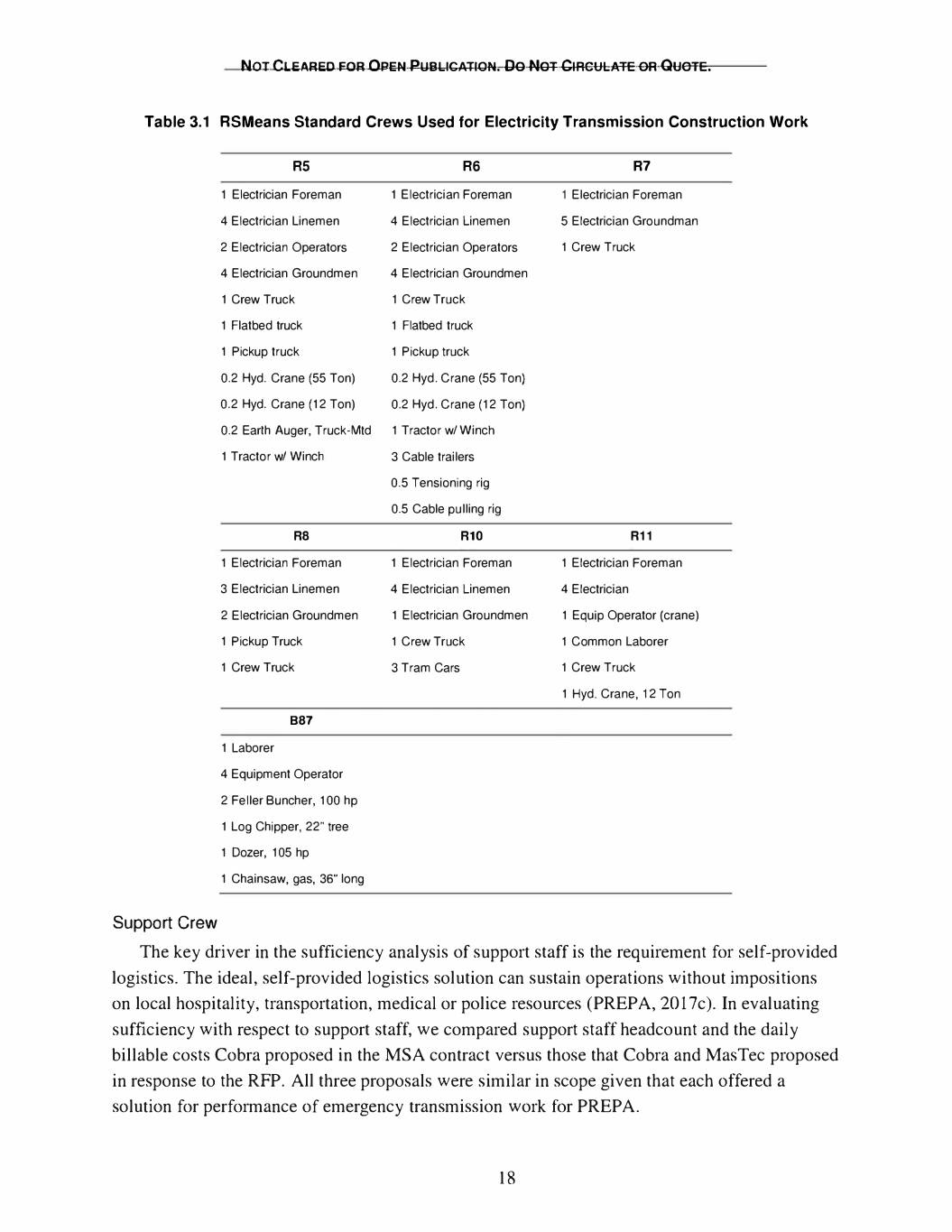
Nor CLE"RED FOR OPEN PYElblCATI0N. Do NOT CIRCULATEOR QUOTE. Table 3.1 RSMeans Standard Crews Used for Electricity Transmission Construction Work RS RG R7 1 Electrician Foreman 1 Electrician Foreman 1 Electrician Foreman 4 Electrician Linemen 4 Electrician Linemen 5 Electrician Groundman 2 Electrician Operators 2 Electrician Operators 1 Crew Truck 4 Electrician Groundmen 4 Electrician Groundmen 1 Crew Truck 1 Crew Truck 1 Flatbed truck 1 Flatbed truck 1 Pickup truck 1 Pickup truck 0.2 Hyd. Crane (55 Ton) 0.2 Hyd. Crane (55 Ton) 0.2 Hyd. Crane (12 Ton) 0.2 Hyd. Crane (12 Ton) 0.2 Earth Auger, Truck-Mid 1 Tractor w/ Winch 1 Tractor w/ Winch 3 Cable trailers 0.5 Tensioning rig 0.5 Cable pulling rig RB R10 R11 1 Electrician Foreman 1 Electrician Foreman 1 Electrician Foreman 3 Electrician Linemen 4 Electrician Linemen 4 Electrician 2 Electrician Groundmen 1 Electrician Groundmen 1 Equip Operator (crane) 1 Pickup Truck 1 Crew Truck 1 Common Laborer 1 Crew Truck 3 Tram Cars 1 Crew Truck 1 Hyd. Crane, 12 Ton B87 1 Laborer 4 Equipment Operator 2 Feller Buncher, 100 hp 1 Log Chipper, 22" tree 1 Dozer, 105 hp 1 Chainsaw, gas, 36" long Support Crew The key driver in the sufficiency analysis of support staff is the requirement for self-provided logistics. The ideal, self-provided logistics solution can sustain operations without impositions on local hospitality, transportation, medical or police resources (PREPA, 2017c). In evaluating sufficiencywith respect to support staff, we compared support staff headcount and the daily billable costs Cobra proposed in the MSA contract versus those that Cobra and MasTec proposed in response to the RFP. All three proposals were similar in scope given that each offered a solution for performance of emergency transmission work for PREPA. 18
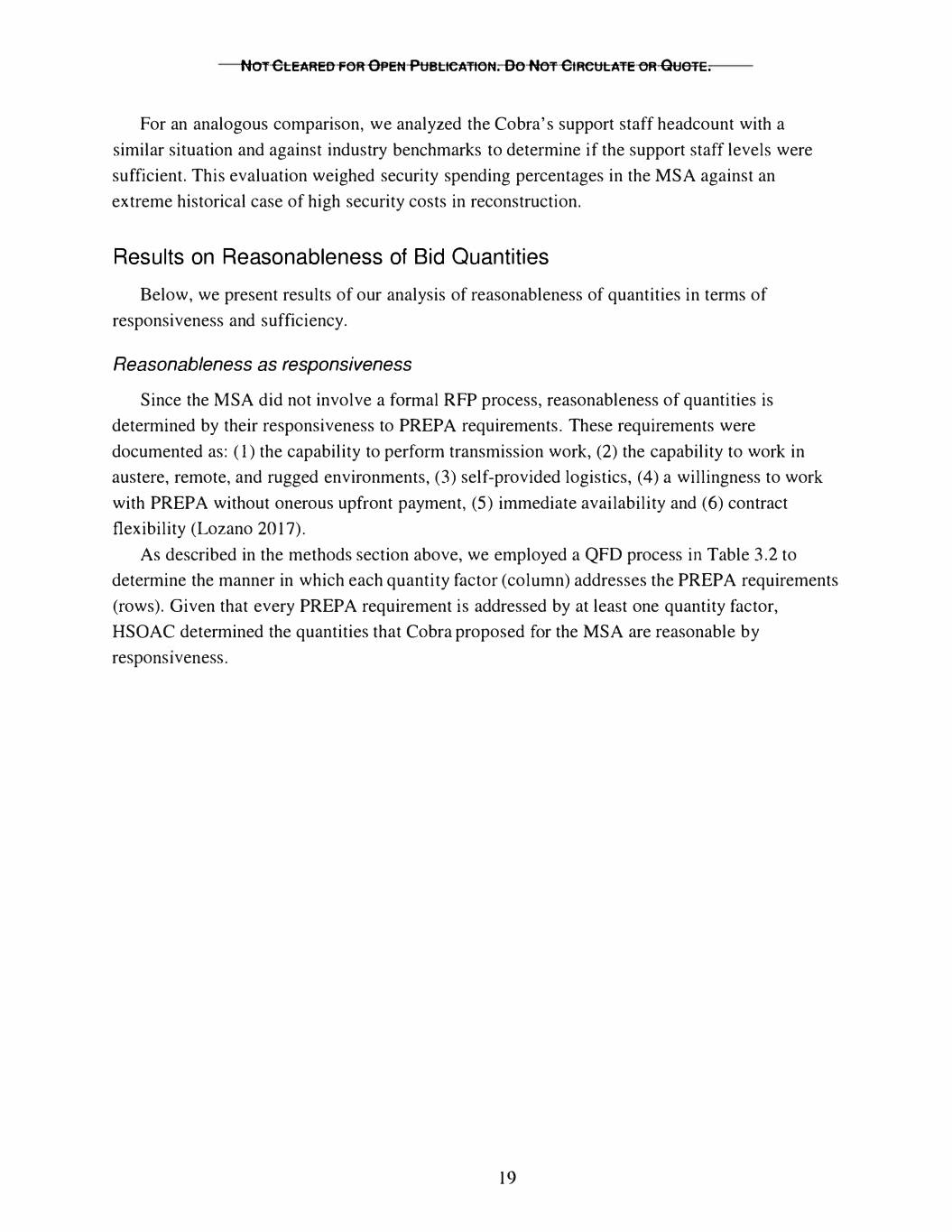
NOT CLEARED FOR OPEN PUBLICATION. 00 NOT CIRCULATE OR QUOTE. For an analogous comparison, we analyzed the Cobra's support staff headcount with a similar situation and against industry benchmarks to determine if the support staff levels were sufficient. This evaluation weighed security spending percentages in the MSA against an extreme historical case of high security costs in reconstruction. Results on Reasonableness of Bid Quantities Below, we present results of our analysis of reasonableness of quantities in terms of responsiveness and sufficiency. Reasonableness as responsiveness Since the MSA did not involve a formal RFP process, reasonableness of quantities is determined by their responsiveness to PREPA requirements. These requirements were documented as: (1) the capability to perform transmission work, (2) the capability to work in austere, remote, and rugged environments, (3) self-provided logistics, (4) a willingness to work with PREPA without onerous upfront payment, (5) immediate availability and (6) contract flexibility (Lozano 2017). As described in the methods section above, we employed a QFD process in Table 3.2 to determine the manner in which each quantity factor(column) addresses the PREPA requirements (rows). Given that every PREPA requirement is addressed by at least one quantity factor, HSOAC determined the quantities that Cobra proposed for the MSA are reasonable by respons1 veness. 19
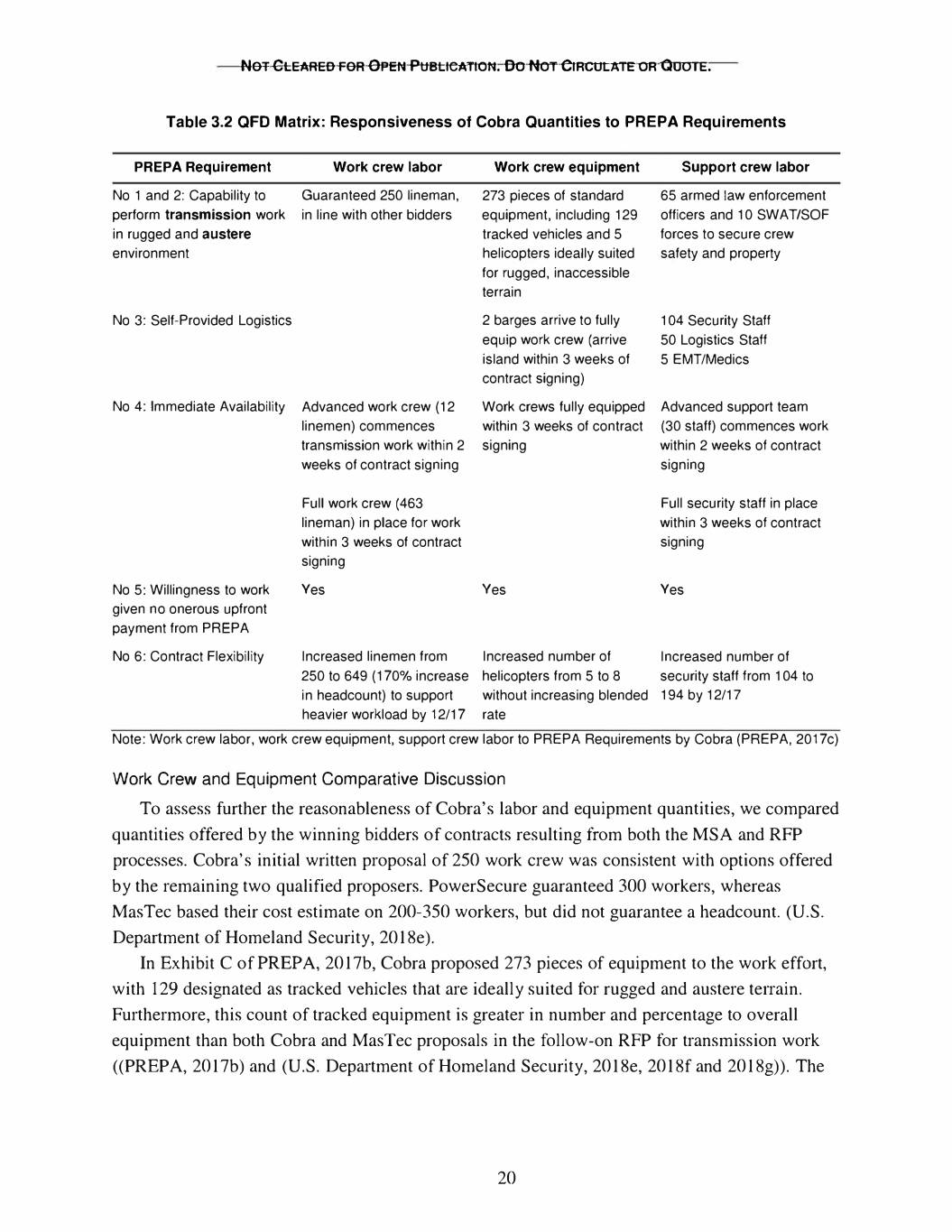
NOT CLEARED FOR OPEN PUBLICATION. Do NOT CIRCULATE OR QuoIE. Table 3.2 QFD Matrix: Responsiveness of Cobra Quantities to PREPA Requirements PREPA Requirement Work crew labor Work crew equipment Support crew labor No 1 and 2: Capability to Guaranteed 250 lineman, 273 pieces of standard 65 armed law enforcement perform transmission work in line with other bidders equipment, including 129 officers and 10 SWAT/SOF in rugged and austere tracked vehicles and 5 forces to secure crew environment helicopters ideally suited safety and property for rugged, inaccessible terrain No 3: Self-Provided Logistics 2 barges arrive to fully 104 Security Staff equip work crew (arrive 50 Logistics Staff island within 3 weeks of 5 EMT/Medics contract signing) No 4: Immediate Availability Advanced work crew (12 Work crews fully equipped Advanced support team linemen) commences within 3 weeks of contract (30 staff) commences work transmission work within 2 signing within 2 weeks of contract weeks of contract signing signing Full work crew (463 Full security staff in place lineman) in place for work within 3 weeks of contract within 3 weeks of contract signing signing No 5: Willingness to work Yes Yes Yes given no onerous upfront payment from PREPA No 6: Contract Flexibility Increased linemen from Increased number of Increased number of 250 to 649 (170% increase helicopters from 5 to 8 security staff from 1 04 to in headcount) to support without increasing blended 194 by 12/17 heavier workload by 12/17 rate Note: Work crew labor, work crew equipment, support crew labor to PREPA Requirements by Cobra (PREPA, 2017c) Work Crew and Equipment Comparative Discussion To assess further the reasonableness of Cobra's labor and equipment quantities, we compared quantities offered by the winning bidders of contracts resulting from both the MSA and RFP processes. Cobra's initial written proposal of 250 work crew was consistent with options offered by the remaining two qualified proposers. PowerSecure guaranteed 300 workers, whereas MasTec based their cost estimate on 200-350 workers, but did not guarantee a headcount. (U.S. Department of Homeland Security, 2018e). In Exhibit C of A, 2017b, Cobra proposed 273 pieces of equipment to the work effort, with 129 designated as tracked vehicles that are ideally suited for rugged and austere te1Tain. PREP Furthermore, this count of tracked equipment is greater in number and percentage to overall equipment than both Cobra and MasTec proposals in the follow-on RFP for transmission work ((PREP A, 2017b) and (U.S. Department of Homeland Security, 2018e, 2018f and 2018g)). The 20
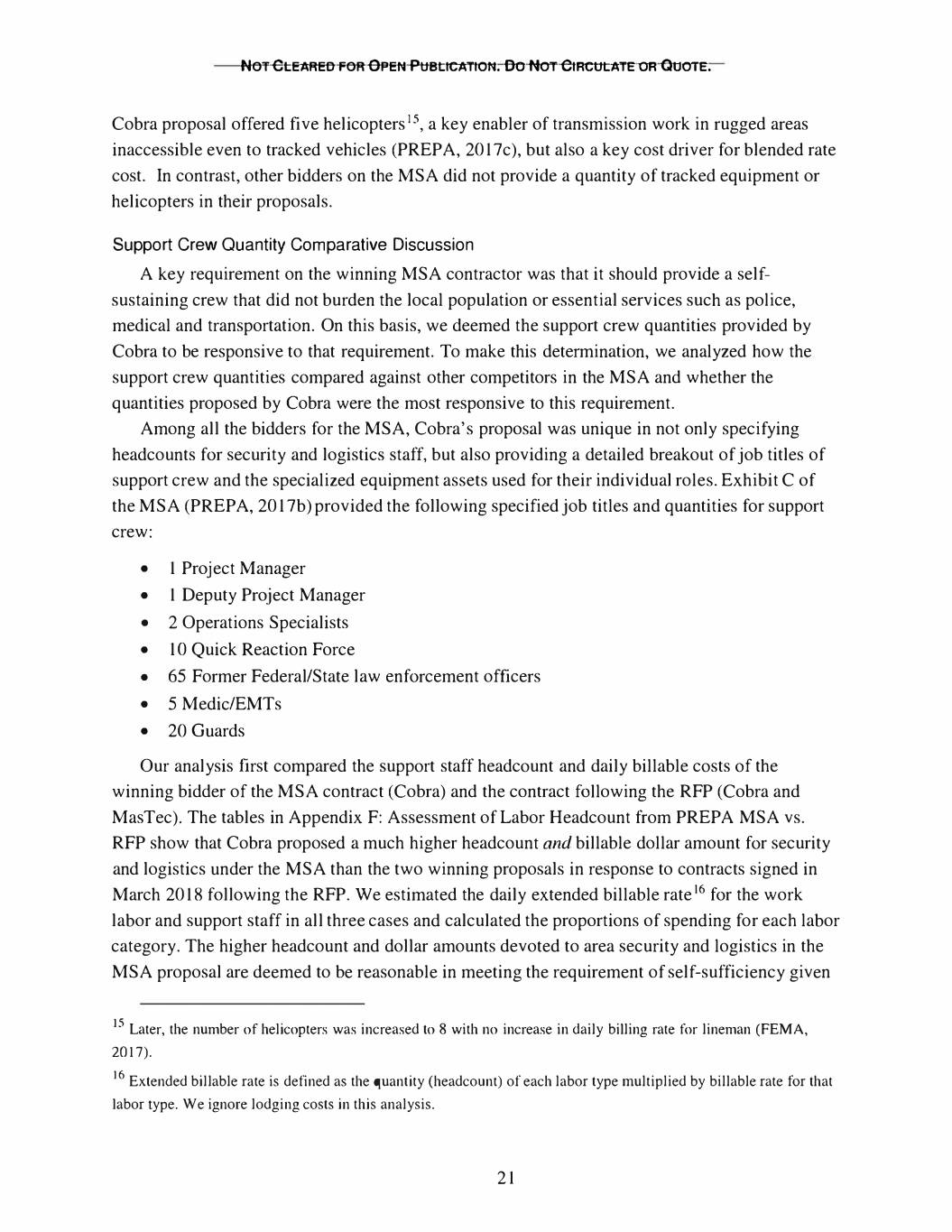
NOT CLEARED FOR OPEN PUBLICATION. Do NOT CIRCULATE OR QUOTE. 15 Cobra proposal offered five helicopters , a key enabler of transmission work in rugged areas inaccessible even to tracked vehicles (PREPA, 2017c), but also a key cost driver forblended rate cost. In contrast, other bidders on the MSA did not provide a quantity of tracked equipment or helicopters in their proposals. Support Crew Quantity Comparative Discussion A key requirement on the winning MSA contractor was that it should provide a self sustaining crew that did not burden the local population or essential services such as police, medical and transportation. On this basis, we deemed the support crew quantities provided by Cobra to be responsive to that requirement. To make this dete1mination, we analyzed how the support crew quantities compared against other competitors in the MSA and whether the quantities proposed by Cobra were the most responsive to this requirement. Among all the bidders forthe MSA, Cobra's proposal was unique in not only specifying headcounts for security and logistics staff, but also providing a detailed breakout of job titles of support crew and the specialized equipment assets used for their individual roles. Exhibit C of the MSA (PREPA, 2017b) provided the followingspecified job titles and quantities forsupport crew: • 1 Project Manager • 1 Deputy Project Manager • 2 Operations Specialists • 10 Quick Reaction Force • 65 Former Federal/State law enforcement officers • 5 Medic/EMTs • 20 Guards Our analysis first compared the support staff headcount and daily billable costs of the winning bidder of the MSA contract (Cobra) and the contract following the RFP (Cobra and MasTec). The tables in Appendix F: Assessment of Labor Headcount from PREPA MSA vs. RFP show that Cobra proposed a much higher headcount and billable dollar amount for security and logistics under the MSA than the two winning proposals in response to contracts signed in March 2018 following the RFP. We estimated the daily extended billable rate for the work labor and support staff in all three cases and calculated the proportions of spending16 foreach labor category. The higher headcount and dollar amounts devoted to area security and logistics in the MSA proposal are deemed to be reasonable in meeting the requirement of self-sufficiencygiven 15 Later, the number of helicopters was increased to 8 with no increase in daily billing rate for lineman (FEMA, 2017). 16 Extended billable rate is defined as the quantity (headcount) of each labor type multiplied by billable rate forthat labor type. We ignore lodging costs in this analysis. 21

NOT CLEARED FOR OPEN PUBLICATION. Do NOT CIRCULATE OFIQUOTE. the tenuous situation and logistical bottlenecks post-Maria. For these reasons, we thus deemed the high support crew quantities proposed in the MSA to be responsive, particularly to the requirement of self-sufficiency Timeliness and flexibility are part of our QFD analysis. We assessed the timeliness in the delivery quantities of labor and equipment as well as the quantities themselves. This timeliness analysis addresses whether quantities delivered were responsive to both immediate availability and contract flexibility requirements. Our focus was on the early stages of the MSA's period of performance, i.e. late 2017. This focus is due to our accessibility to Cobra progress report data during this period as well as the dire humanitarian crisis facing the island at that time. 17 We utilized this progress report data to build a focused timeline of key events surrounding the delivery of crews and equipment in the days immediately following Hurricane Maria (see Table 3.3). Results of our timeliness analysis were also applied to cells within the QFD matrix in Table 3.2. Cobra was uniquely positioned for rapid response to the crisis, deploying heavy equipment to seaports to barge transports on the day after contract signature (10/20/17). Transmission work on the island began on 10/31/17, two weeks after Cobra was awarded the contract. Furthermore, a fully equipped crew of 463 lineman and 200 support staff arrived on the island within 3 weeks of contract signing (11/13/17) (Table 4.3). This fully equipped crew was composed of quantities of linemen and security which greatly exceeded the levels originally proposed in the MSA. This timely delivery of quantities of work and support labor, in excess of the levels initially proposed quickly (three weeks after the MSA was signed), clearly reflects responsiveness to requirements forboth immediate availability and contract flexibility. Table 3.3 is represented graphically in Figure 3 .1 below. 17 The first few weeks were the time of greatest suffering on the island, as only 40% of PREPA customers had power by 11/13 (about two months after landfall) (Ferris, 2018). 22
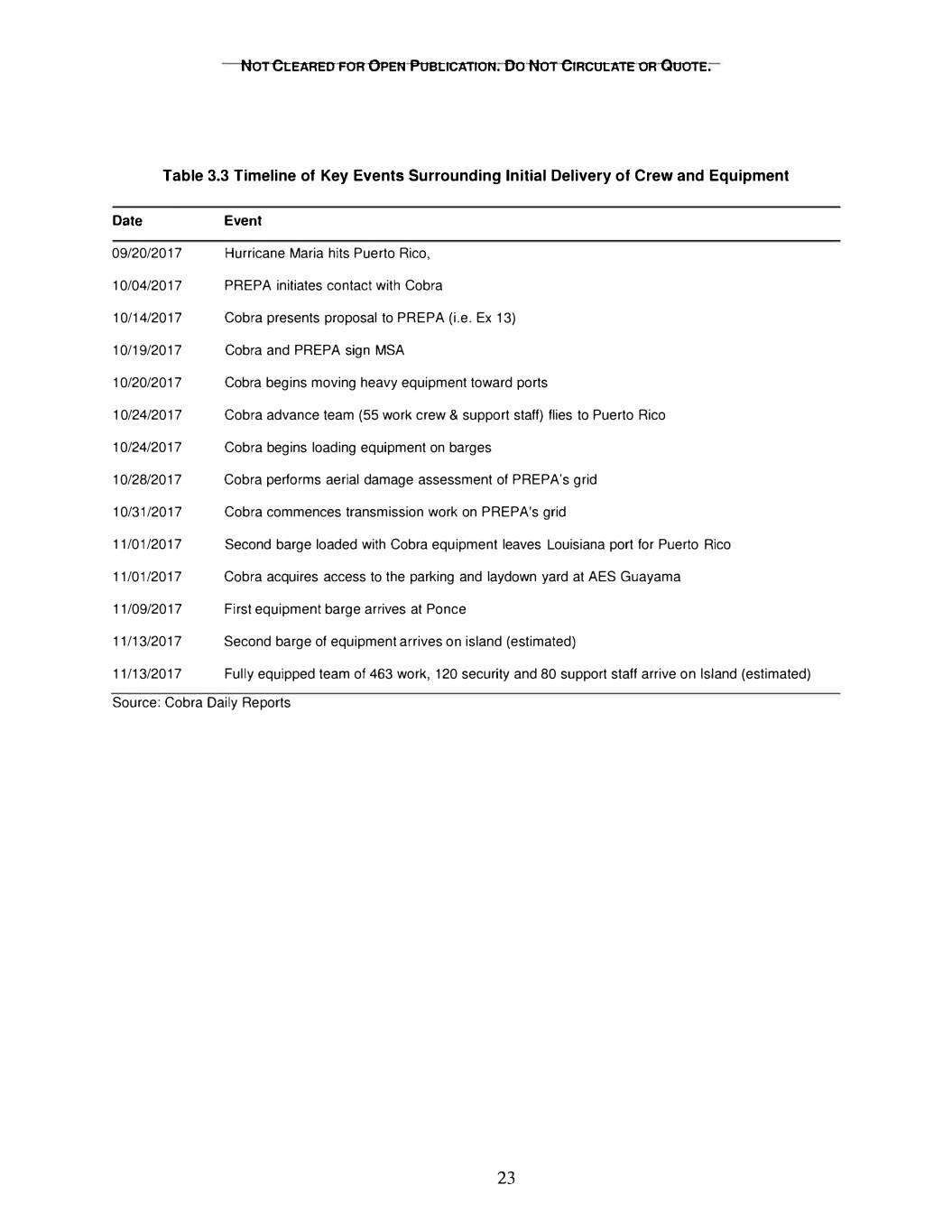
NOT CLEARED FOR OPEN PUBLICATION. Do NOT CIRCULATE OR QUOTE. Table 3.3 Timeline of Key Events Surrounding Initial Delivery of Crew and Equipment Date Event 09/20/2017 Hurricane Maria hits Puerto Rico, 10/04/2017 PREPA initiates contact with Cobra 10/14/2017 Cobra presents proposal to PREPA (i.e. Ex 13) 10/19/2017 Cobra and PREPA sign MSA 10/20/2017 Cobra begins moving heavy equipment toward ports 10/24/2017 Cobra advance team (55 work crew & support staff) flies to Puerto Rico 10/24/2017 Cobra begins loading equipment on barges 10/28/2017 Cobra performs aerial damage assessment of PREPA's grid 10/31/2017 Cobra commences transmission work on PREPA's grid 11/01/2017 Second barge loaded with Cobra equipment leaves Louisiana port for Puerto Rico 11/01/2017 Cobra acquires access to the parking and laydown yard at AES Guayama 11/09/2017 First equipment barge arrives at Ponce 11/13/2017 Second barge of equipment arrives on island (estimated) 11/13/2017 Fully equipped team of 463 work, 120 security and 80 support staff arrive on Island (estimated) Source: Cobra Daily Reports 23

NOT CbEARED FOR OPEN PUBLICATlml. Do NOT CIRCULATEon QUOTE. Figure 3.1 Graphical Timeline of Key Events Surrounding Initial Delivery of Crew and Equipment in 2017 (Source: Cobra Daily Reports) 11.13 10.24 Second barge of equipment Cobra advance team (55 arrives on island (estimated) 10.4 work crew & support staff) flies to Puerto Rico ---. 9.20 PR EPA initiates Fully equipped team of Hurricane Maria contact with hits Puerto Rico Cobra 463 work, 120 security and 80 support staff on Island � 10.19 (estimated) � Cobra and fOI · PREPA sign ��i� MSA Cobra begins loading equipment on barges ��· � &-rfM September October November I 10.14 10.20I 11.09 Cobra presents Cobra First equipment barge proposal to begins arrives at Ponce PREPA (i.e. Ex 13) moving � heavy equipment � toward 11.01 ports Second barge loaded with ___, Cobra equipment leaves Louisiana port for Puerto -� Rico 10.28 Cobra acquires access to I � Cobra performs aerial the parking and laydown • damage assessment of yard at AES Guayama PREPA's grid 10.31 Cobra commences transmission work on PREPA's grid � We also determined whether quantities delivered were responsive to the requirement of contract flexibilitywith the MSA. Such flexibilitywould be demonstrated by the ability of the contractor to change quantities of resources and staff without renegotiation (PREPA, 2017b ). Our delivery timeline demonstrates that Cobra was able to quickly (i.e. less than a month after contract signature) activate many more resources (i.e. labor and equipment), than it originally proposed. Most notably, Cobra increased the headcount of linemen from250 to 649 by early December based on MSA invoices in 2017. Security staff also increased from 104 to 194, 24
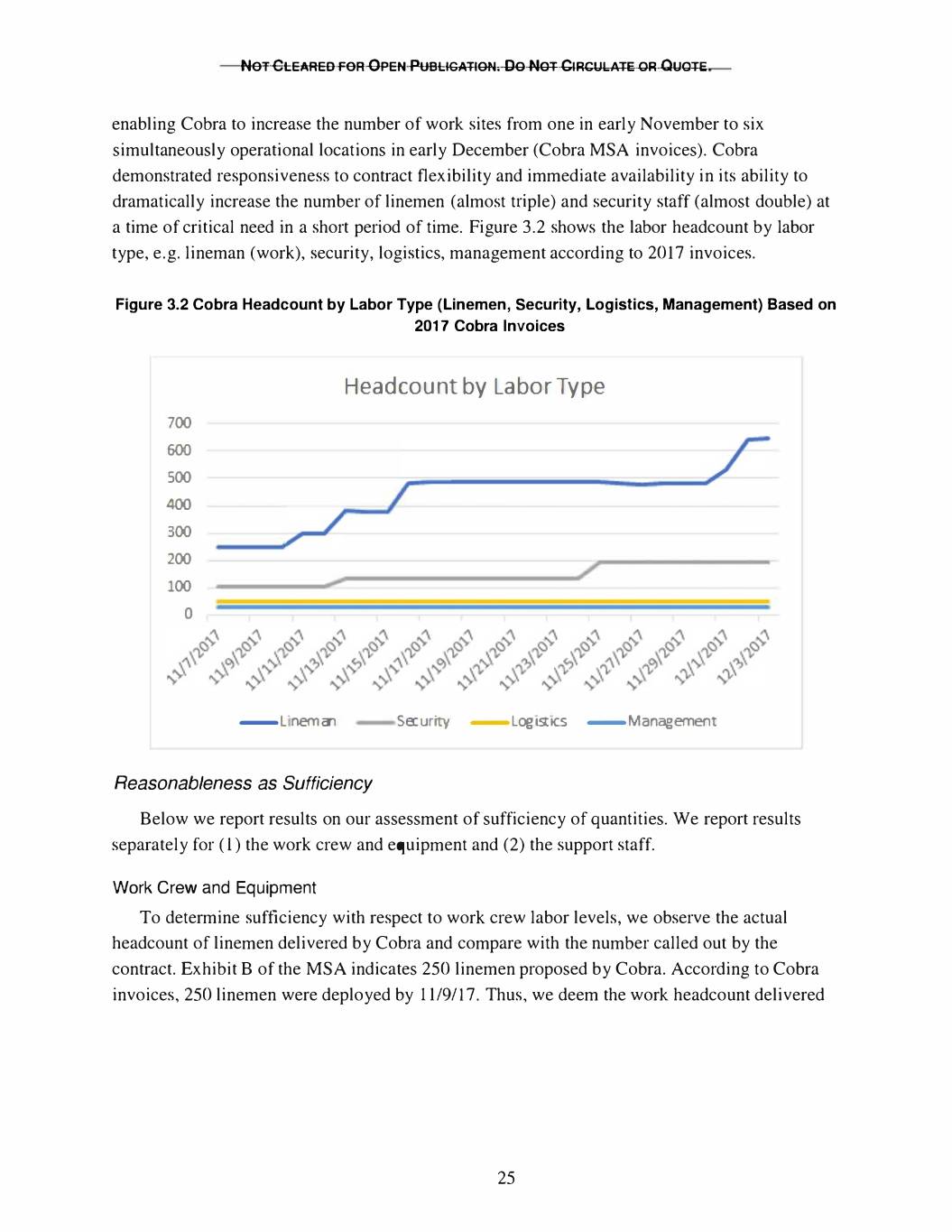
NOT CLEARED FOR OPEN PUBLICATlml. Do NOT CIRCULATE OR OY0TE enabling Cobra to increase the number of work sites fromone in early November to six simultaneously operational locations in early December (Cobra MSA invoices). Cobra demonstrated responsiveness to contract flexibility and immediate availability in its ability to dramatically increase the number of linemen (almost tiiple) and security staff (almost double) at a time of critical need in a short period of time. Figure 3.2 shows the labor headcount by labor type, e.g. lineman (work), security, logistics, management according to 2017 invoices. Figure 3.2 Cobra Headcount by Labor Type (Linemen, Security, Logistics, Management) Based on 2017 Cobra Invoices Headcount by Labor Type 700 600 500 400 300 200 100 0 -L·nema, Security -Log&cs -Management Reasonableness as Sufficiency Below we report results on our assessment of sufficiency of quantities. We report results separately for (1) the work crew and equipment and (2) the support staff. Work Crew and Equipment To determine sufficiency with respect to work crew labor levels, we observe the actual headcount of linemen delivered by Cobra and compare with the number called out by the contract. Exhibit B of the MSA indicates 250 linemen proposed by Cobra. According to Cobra invoices, 250 linemen were deployed by 11/9/17. Thus, we deem the work headcount delivered 25
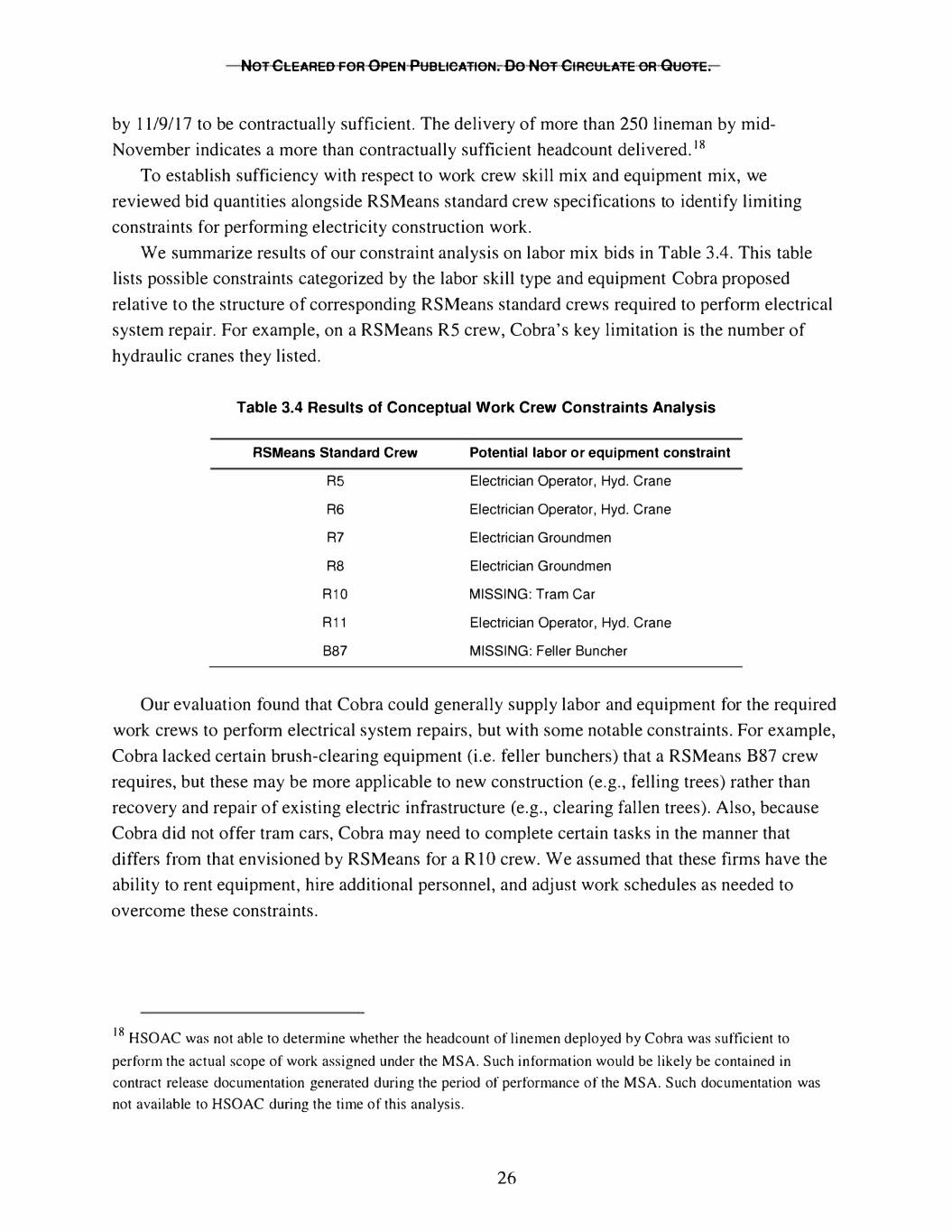
NOT CLEARED FOR OPEN PUBLICATION. 00 NOT CIRCULATE OR QUOTE. f by 11/9/17 to be contractually suficient. The delivery of more than 250 lineman by mid November indicates a more than contractually sufficient headcount delivered. To establish sufficiency with respect to work crew skill mix and equipment18 mix, we reviewed bid quantities alongside RSMeans standard crew specifications to identify limiting constraints for performingelectricity construction work. We summarize results of our constraint analysis on labor mix bids in Table 3.4. This table lists possible constraints categorized by the labor skill type and equipment Cobra proposed relative to the structure of corresponding RSMeans standard crews required to perform electrical system repair. For example, on a RSMeans R5 crew, Cobra's key limitation is the number of hydraulic cranes they listed. Table 3.4 Results of Conceptual Work Crew Constraints Analysis RSMeans Standard Crew Potential labor or equipment constraint R5 Electrician Operator, Hyd. Crane R6 Electrician Operator, Hyd. Crane R7 Electrician Groundmen R8 Electrician Groundmen R10 MISSING: Tram Car R11 Electrician Operator, Hyd. Crane B87 MISSING: Feller Buncher Our evaluation found that Cobra could generally supply labor and equipment for the required work crews to performelectrical system repairs, but with some notable constraints. For example, Cobra lacked certain brush-clearing equipment (i.e. feller bunchers) that a RSMeans B87 crew requires, but these may be more applicable to new construction (e.g., felling trees) rather than recovery and repair of existing electlic infrastructure (e.g., clearing fallen trees). Also, because Cobra did not offer tram cars, Cobra may need to complete certain tasks in the manner that differs from that envisioned by RSMeans for a RIO crew. We assumed that these firmshave the ability to rent equipment, hire additional personnel, and adjust work schedules as needed to overcome these constraints. 18 HSOAC was not able to determine whether the headcount of linemen deployed by Cobra was sufficient to perform the actual scope of work assigned under the MSA. Such information would be likely be contained in contract release documentation generated during the period of performance of the MSA. Such documentation was not available to HSOAC during the time of this analysis. 26
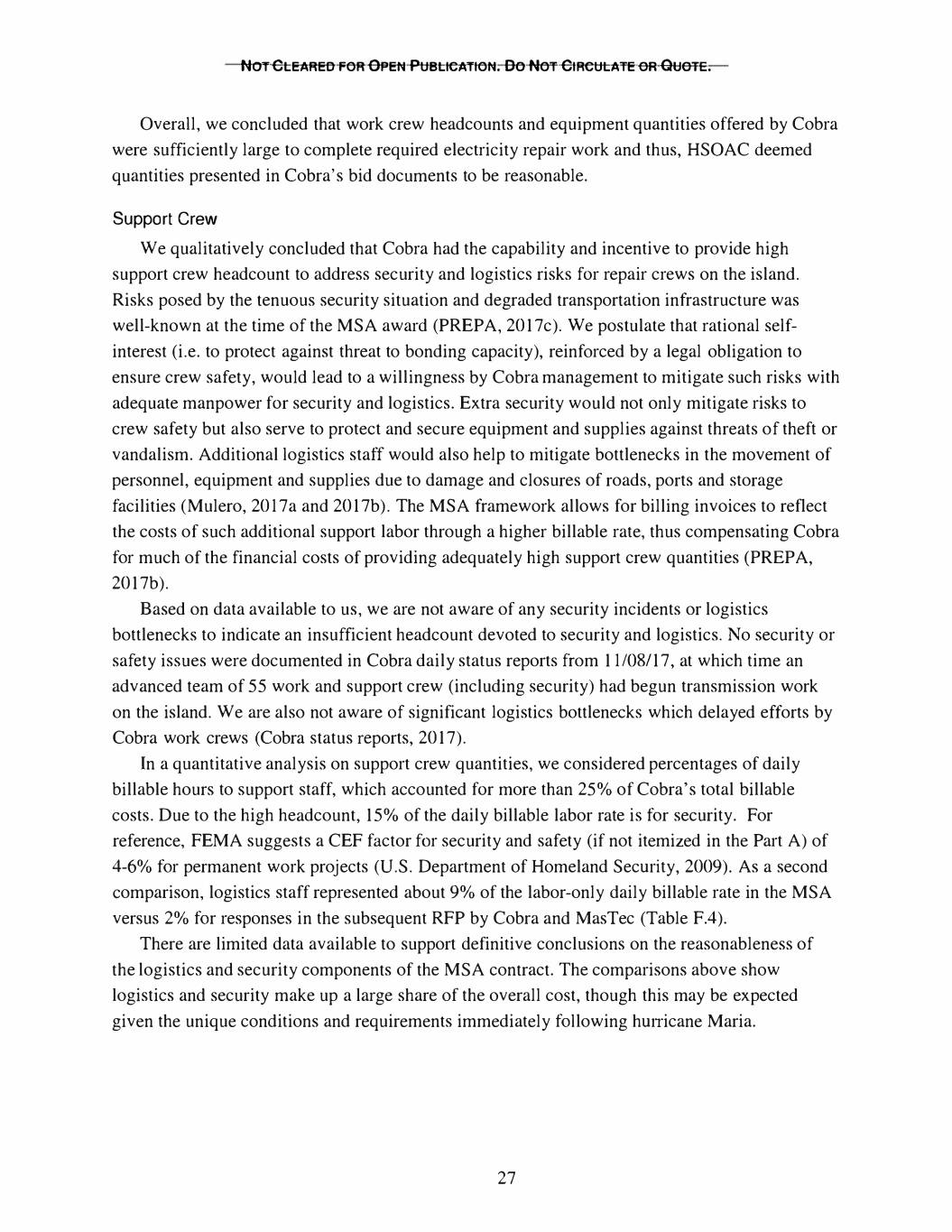
NOT CLEARED FOR OPEN PUBLICATION. 00 NOT CIRCULATE OR QUOTE. Overall, we concluded that work crew headcounts and equipment quantities offered by Cobra were sufficiently large to complete required electricity repair work and thus, HSOAC deemed quantities presented in Cobra's bid documents to be reasonable. Support Crew We qualitatively concluded that Cobra had the capability and incentive to provide high support crew headcount to address security and logistics risks for repair crews on the island. Risks posed by the tenuous security situation and degraded transportation infrastructurewas well-known at the time of the MSA award (PREPA, 2017c). We postulate that rational self interest (i.e. to protect against threat to bonding capacity), reinforced by a legal obligation to ensure crew safety, would lead to a willingness by Cobra management to mitigate such risks with adequate manpower for security and logistics. Extra security would not only mitigate risks to crew safety but also serve to protect and secure equipment and supplies against threats of theft or vandalism. Additional logistics staffwould also help to mitigate bottlenecks in the movement of personnel, equipment and supplies due to damage and closures of roads, ports and storage facilities (Mulero, 2017a and 2017b). The MSA framework allows for billing invoices to reflect the costs of such additional support labor through a higher billable rate, thus compensating Cobra for much of the financial costs of providing adequately high support crew quantities A, 2017b). (PREP Based on data available to us, we are not aware of any security incidents or logistics bottlenecks to indicate an insufficient headcount devoted to security and logistics. No security or safety issues were documented in Cobra daily status reports from 11/08/17, at which time an advanced team of 55 work and support crew (including security) had begun transmission work on the island. We are also not aware of significant logistics bottlenecks which delayed efforts by Cobra work crews (Cobra status reports, 2017). In a quantitative analysis on support crew quantities, we considered percentages of daily billable hours to support staff, which accounted for more than 25% of Cobra's total billable costs. Due to the high headcount, 15% of the daily billable labor rate is forsecurity. For reference, FEMA suggests a CEF factor for security and safety (if not itemized in the Part A) of 4-6% for permanent work projects (U.S. Department of Homeland Secmity, 2009). As a second comparison, logistics staff represented about 9% of the labor-only daily billable rate in the MSA versus 2% forresponses in the subsequent RFP by Cobra and MasTec (Table F.4). There are limited data available to support definitive conclusions on the reasonableness of the logistics and security components of the MSA contract. The comparisons above show logistics and security make up a large share of the overall cost, though this may be expected given the unique conditions and requirements immediately followinghmTicane Maria. 27

NOT CtEAFIEDFOFI OPEN PUBLICATION.Do NOT CIRCULAIE OR QuoIE. 4. Assessment and Results of Reasonableness of Blended Rates The previous section focused attention on the labor and equipment quantities proposed by Cobra under the MSA. In this section, we discuss the HSOAC methodology forbenchmarking labor and equipment rates as well as developing ranges of representative blended rate estimates for comparison to Cobra's billable rates. We considered several blended rate formulationsfor comparison to Cobra's rates: 1. Work crews only (e.g. linemen, equipment operators, laborers and equipment). 2. Support staff only (e.g. management, logistics and security personnel). 3. Work crews plus support staff. We performed several sensitivity tests on labor rates, equipment rates, and labor and equipment quantities, and we computed representative blended rates under varied assumptions relevant to high voltage system repair. Next, we compared Cobra's "Blended Rate, linemen and equipment" and "Total Rate per Blended Lineman" to ranges that span these representative blended rates, judging Cobra's rates to be reasonable when they fall within these ranges. We present results of our assessment of reasonableness of Cobra's rates under the MSA at the end of this section. Methodology for Constructing Representative Blended Rates In addition to labor and equipment quantities, blended rates require labor and equipment base rates and adjustment factors (CCFs) as inputs to the calculation. Below we describe how we benchmarked these additional inputs and combined them to produce representative blended rates for comparison to Cobra's proposed rates. Labor Rate Benchmarks We combined data fromRSMeans and BLS to define ranges of labor base rates forboth work crews and support staff for the time period of the MSA. Given that RSMeans and BLS data points are collected and presented in different manners, we were required to standardize the data to perform comparisons. Our approach foraligning benchmark data followed the techniques which were used in previous unpublished HSOAC analysis of subsequent emergency work contracts awarded by PREP A. For RS Means labor data, we use standard union wage rates (Facilities Cost Book, 2018 Q4 data, national average costs). BLS occupational wage datasets are compiled annually forthe continental U.S. and territories and released approximately 14 months after collection; in this study, we used the latest release, which reflects prevailing wages for late 2017 and early 2018. 28
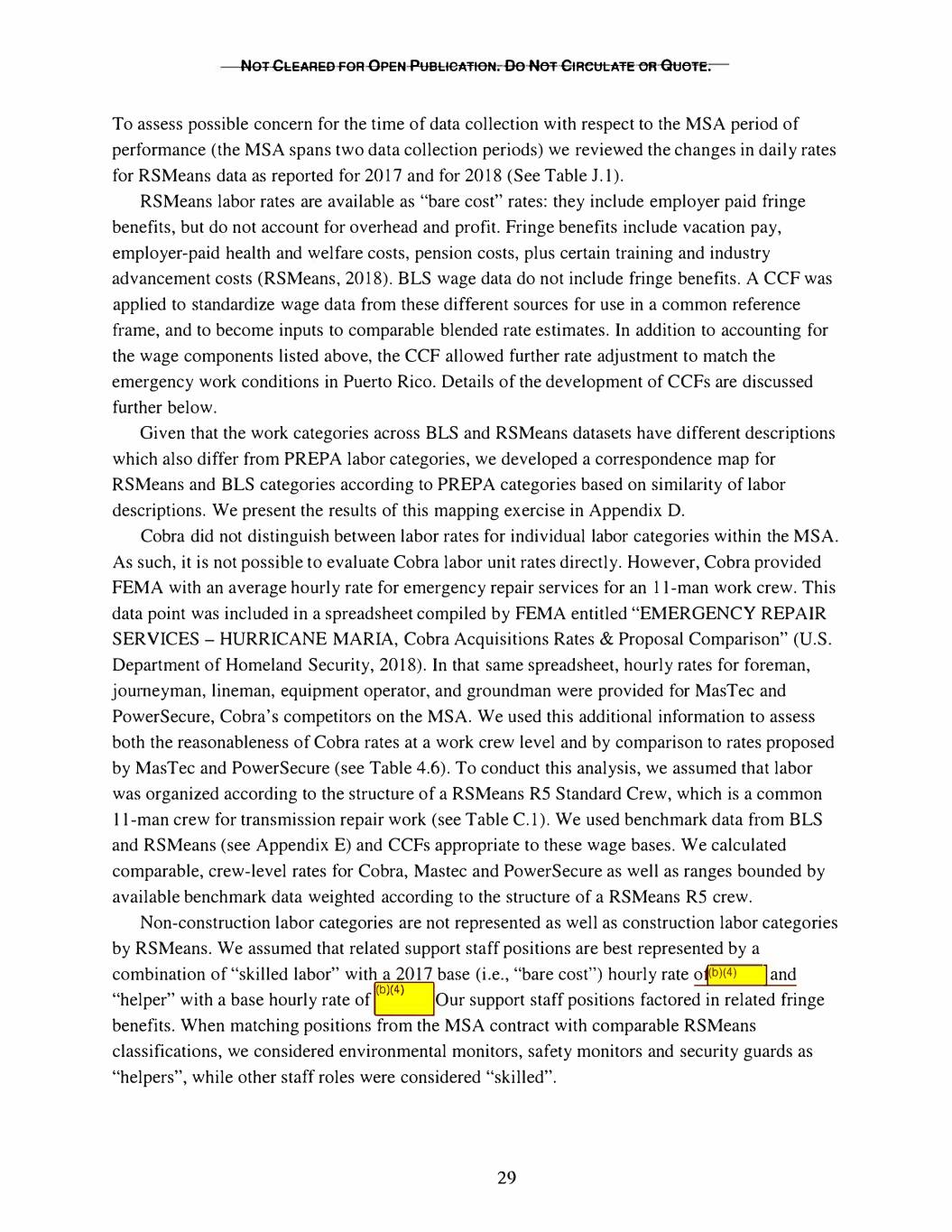
NOT CLEARED FOR OPEN PUBLICATION. 00 NOT CIRCULATE OR QUOTE. To assess possible concern for the time of data collection with respect to the MSA period of performance (the MSA spans two data collection periods) we reviewed the changes in daily rates forRSMeans data as reported for2017 and for 2018 (See Table J.1). RSMeans labor rates are available as "bare cost" rates: they include employer paid fringe benefits, but do not account for overhead and profit. Fringe benefits include vacation pay, employer-paid health and welfare costs, pension costs, plus certain training and industry advancement costs (RSMeans, 2018). BLS wage data do not include fringe benefits. A CCF was applied to standardize wage data from these differentsources for use in a common reference frame, and to become inputs to comparable blended rate estimates. In addition to accounting for the wage components listed above, the CCF allowed further rate adjustment to match the emergency work conditions in Puerto Rico. Details of the development of CCFs are discussed further below. Given that the work categories across BLS and RSMeans datasets have different descriptions which also differfrom PREP A labor categories, we developed a correspondence map for RSMeans and BLS categories according to PREPA categories based on similarity of labor descriptions. We present the results of this mapping exercise in Appendix D. Cobra did not distinguish between labor rates for individual labor categories within the MSA. As such, it is not possible to evaluate Cobra labor unit rates directly. However, Cobra provided FEMA with an average hourly rate for emergency repair services foran 11-man work crew. This data point was included in a spreadsheet compiled by FEMA entitled "EMERGENCY REPAIR SERVICES - HURRICANE MARIA, Cobra Acquisitions Rates & Proposal Comparison" (U.S. Department of Homeland Security, 2018). In that same spreadsheet, hourly rates for foreman, journeyman, lineman, equipment operator, and groundman were provided for MasTec and PowerSecure, Cobra's competitors on the MSA. We used this additional information to assess both the reasonableness of Cobra rates at a work crew level and by comparison to rates proposed by MasTec and PowerSecure (see Table 4.6). To conduct this analysis, we assumed that labor was organized according to the structure of a RSMeans R5 Standard Crew, which is a common 11-man crew fortransmission repair work (see Table C.l). We used benchmark data from BLS and RSMeans (see Appendix E) and CCFs appropriate to these wage bases. We calculated comparable, crew-level rates for Cobra, Mastec and PowerSecure as well as ranges bounded by available benchmark data weighted according to the structure of a RSMeans R5 crew. Non-construction labor categories are not represented as well as construction labor categories by RSMeans. We assumed that related support staff positions are best represented by a combination of "skilled labor" with a 2017 base (i.e., "bare cost") hourly rate o1(bl(4l land "helper" with a base hourly rate of�Our support staff positions factored in related fringe benefits.When matching positions fromthe MSA contract with comparable RSMeans classifications, we considered environmental monitors, safetymonitors and security guards as "helpers", while other staffroles were considered "skilled". 29
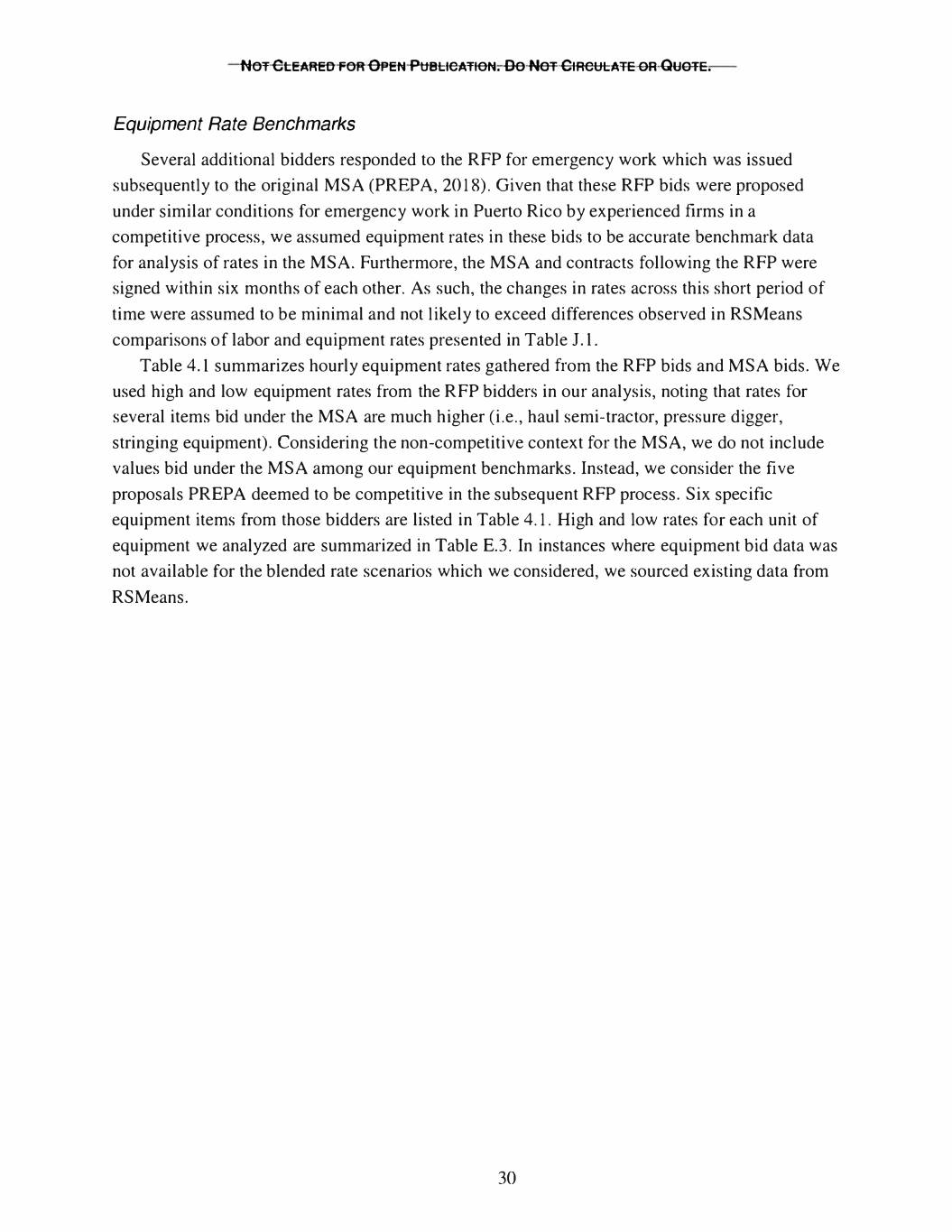
NOT CLEARED FOR OPEN PUBLICATION. 00 NOT CIRCULATE OR QUOTE. Equipment Rate Benchmarks Several additional bidders responded to the RFP for emergency work which was issued subsequently to the original MSA (PREPA, 2018). Given that these RFP bids were proposed under similar conditions for emergency work in Puerto Rico by experienced firmsin a competitive process, we assumed equipment rates in these bids to be accurate benchmark data foranalysis of rates in the MSA. Furthermore, the MSA and contracts following the RFP were signed within six months of each other. As such, the changes in rates across this short period of time were assumed to be minimal and not likely to exceed differencesobserved in RSMeans comparisons of labor and equipment rates presented in Table J.1. Table 4.1 summarizes hourly equipment rates gathered fromthe RFP bids and MSA bids. We used high and low equipment rates from the RFP bidders in our analysis, noting that rates for several items bid under the MSA are much higher (i.e., haul semi-tractor, pressure digger, stringing equipment). Considering the non-competitive context forthe MSA, we do not include values bid under the MSA among our equipment benchmarks. Instead, we consider the five proposals PREPA deemed to be competitive in the subsequent RFP process. Six specific equipment items fromthose bidders a.re listed in Table 4.1. High and low rates foreach unit of equipment we analyzed are summarized in Table E.3. In instances where equipment bid data was not available for the blended rate scenarios which we considered, we sourced existing data from RSMeans. 30

NOT CLEARED FOR OPEN PUBLICATION. Do NOT CIRCULAIE OR QuoIE. Table 4.1 Equipment Bids for Transmission Construction under Emergency Conditions for MSA and RFP RFP MSA Equipment ARC Cobra Fluor Foreman19 MasTec Power Southern Description (Hourly) (Hourly) (Hourly) (Hourly) (Hourly) Secure 20 Electric (Hourly) (Hourly) Haul Semi Tractor (b)(4) Kb)(4) l(b)(4) I !(b)(4) I fb)(4) I l I � Aircraft MD 500 fb)(4) I� Kb)(4) I fb)(4) 55' - 60' 4x2 / )(4) fb)(41 �b I !(b)(4) ! !(b)(4) ! l�b)(4 I tracked 100' - 105' 6x6 / [b)(4) i(b)(4) � tracked 60T Truck Crane !(b)(4) � i(b)(4)I � Pressure Diggers !(b)(4) EJ Our analysis of rates in the MSA does not consider additional costs of mobilization and demobilization, nor does it account for materials costs. Cobra's MSA contract identifies these resources as separate, reimbursable expenses. Additionally, we assume that equipment costs for support staffare built into their labor rates. While Cobra's MSA contract also identifies fuel costs as separate reimbursable costs, some documents provided to HSOAC by FEMA suggest that fuel costs were included in the blended rates that Cobra proposed. In these documents, we observed that fuel costs contributed to approximately 1.3% of total extended daily costs. We explored the possible impact that fuel costs have on blended rates in Section 4 of this report. Construction Cost Factors (CCFs) PREPA established standard base rates for labor and equipment in a subsequent RFP (PREPA, 2018) to the Cobra MSA and required respondents to bid in terms of multipliers to these rates. These multipliers, the CCFs, account for the differencebetween PREPA base rates and the contractor's unit costs. We use these CCFs to align labor data from BLS, RSMeans, and PREP A equipment bids to produce estimates that produce a representative range of blended rates. Our approach to developing accurate CCFs and combining them with benchmark data is detailed in Appendix Band summarized below. 19 Data for Foreman were scaled to an hourly rate. zo Data for PowerSecure were bid without fuel. 31

NOT CLEARED FOR OPEN PUBLICATION. Do No I CiRCULAIE OR QUOTE. For development of the CCFs, we began with a base rate of 1, then we sequentiaJly accounted for appropriate burdens, as in the CEF for Large Projects (U.S. Department of Homeland Security, 2009), including factors such as overhead and profit, contingencies and risk, and indirect costs not defined in the MSA or RFP foremergency work. Given that the percentage value of each component can vary, we developed a range of values for CCFs based on high and low assumptions for each cost component (see Appendix I). Our labor calculations accounted for overtime as appropriate (40 hours straight time, 72 hours overtime, allowing for double-time Sundays for the high values). In accordance with the assumptions for emergency work specified in both the MSA and subsequent RFP, we estimated that CCFs are to be considered within an operations framework of 16-hour days in a 7-day week with no loss in productivity. With regard to equipment assets, we accounted for differential costs that arise fromextended use in the fieldrelative to standard time cost conventions. Unlike the RFP bids which accounted forthe cost of fuel, we consider possibilities that equipment rates for the MSA were made with and without associated fuel costs. Furthermore, in seeking to accommodate benchmark datasets from a variety of sources, we developed CCFs for three cost bases to facilitate comparison in a common frame: BLS, RSMeans, and PREPA rates. These rates differed because BLS wage rates do not include fringe benefits while RSMeans rates do include fringe benefits, and because PREPA standard rates do not necessarily reflect market prices. We also factoredin two further considerations for calculation of labor CCFs. First, we allowed for possible cost savings which could be obtained from local labor. Second, bidders may offer location bonuses in consideration for the remoteness of work locations. These considerations are applicable regardless of whether labor is from Puerto Rico or the continental U.S., as even local labor standards may require additional compensation forthe inconvenience of working several days at a time in the mountains, or on adjacentislands of Vieques or Culebra. Blended Rates Formulations and Assessment As presented in Table 1.1, Cobra refers to two primary categorizations in the calculation of blended rates ("Blended Rate, skiJled linemen and equipment" and "Total Rate per Blended Lineman"). For both categories, we developed comparable blended rate estimates built from labor costs which were computed using BLS and RSMeans wage rates and multiplied by the appropriate labor CCFs. Equipment cost ranges were computed using a combination of bid data and equipment costs from RSMeans, further adjusted by the appropriate equipment CCFs. We separately computed representative blended rates forthe formulations above - some to reflect the costs of work crews for construction repair work alone, others to reflect costs for support staff, and also to combine costs for both work crews and support staff. To account for contradictory information on whether equipment was bid with or without fuelas a separately reimbursable expenses, we computed blended rates forboth interpretations. For the ranges of representative rates for each of these formulations, we test quantity assumptions forthe blended rate 32

NOT CLEARED FOR OPEN PUBLICATION. Do NOT CIRCULATE on QUOTE. calculations as further described below. In instances where Cobra's proposed rate falls within the range, we judge their rate to be reasonable under the assumptions and inputs used in computation of these parameters. The method which we applied to manipulate data forthis analysis is found Appendix M. The Roster-Basis of Blended Rates As discussed in the previous section, reasonableness of quantities is judged primarily on basis of responsiveness and sufficiency with regards to the MSA requirements. Accordingly, we computed a range of blended rate estimates for "Blended Rate, skilled linemen and equipment" based on the entire list of labor and equipment offered by Cobra under the MSA. We call this the "roster-based" blended rate range, as the quantities reflect all labor and equipment assets offered by Cobra. The analogy is to a roster of players and equipment fora sports team, which includes backup players and additional equipment items that are not always in use. We assert that a large roster of linemen and repair equipment may be judged to be approptiately responsive and sufficientin the face of uncertainty and risk following disaster, just as a sports team with a "deep bench" will be better prepared fora challenging contest than one without backup players and surplus gear. Owing to its size and open structure, the roster basis of quantities is expected to generate a wide range of blended rate estimates covering the varied conditions, uncertainty and risk Cobra facedin the immediate aftermath of Hurricane Maria. We computed different roster-based ranges of blended rates using quantities given in the Cobra MSA. Additionally, we analyzed similarly sized workforces but with labor mixes proportional to Cobra and MasTec contracts awarded under the subsequent RFP. Given that the number of Cobra's linemen grew from 250 in early November 2017 to 649 in early December 2017, we also calculated a roster-based blended rate range that reflects the enhanced work crew Cobra provided at that time. While Cobra did not offera crew of 649 linemen in the MSA, we include this scenario for compmison. The Players-on-the-Field Basis of Blended Rates We tested the sensitivity of a blended rate based on Cobra's MSA roster to the addition of one of each individual labor and equipment unit (results are presented in Appendix H). High-cost items (e.g. helicopters) disproportionately influence the blended rate result, introducing the possibility that the roster formulation may not approptiately account forvariation in cost for these items according to work requirements on a given day. In our sports team analogy, the roster includes all players that are on the roster, even if they may be on the bench duting a game along with equipment that is not in use. While this formulation may be acceptable to a sporst franchise, it may not align with FEMA policy. Given the potential influence of some expensive but potentially idle equipment, the roster-basis could generate an unreasonably high blended rate, especially when the work itself is not considered. While the MSA prioritized responsiveness and sufficiency of quantities in the immediate aftermath of Maria, we considered the potential 33
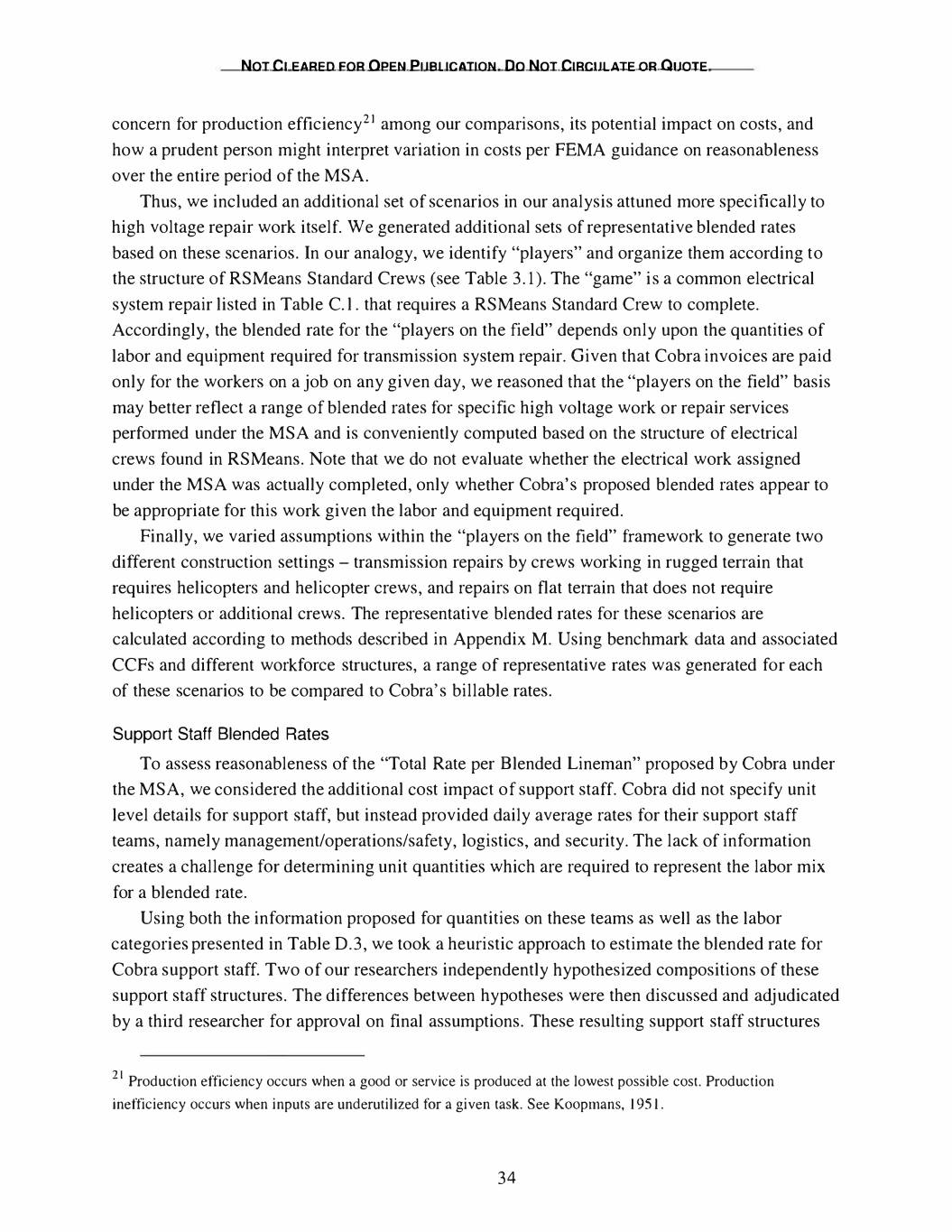
NOT c, EARED FOR 0PEN Pl 181 ICAIIQN Da NOT CIRCI !LATE QR a, IQIE concern for production efficiency among our comparisons, its potential impact on costs, and how a prudent person might interpret21 variation in costs per FEMA guidance on reasonableness over the entire period of the MSA. Thus, we included an additional set of scenarios in our analysis attuned more specifically to high voltage repair work itself. We generated additional sets of representative blended rates based on these scenarios. In our analogy, we identify "players" and organize them according to the structure of RSMeans Standard Crews (see Table 3.1). The "game" is a common electrical system repair listed in Table C. l. that requires a RSMeans Standard Crew to complete. Accordingly, the blended rate for the "players on the field" depends only upon the quantities of labor and equipment required fortransmission system repair. Given that Cobra invoices are paid only for the workers on a job on any given day, we reasoned that the "players on the field" basis may better reflect a range of blended rates for specific high voltage work or repair services performed under the MSA and is conveniently computed based on the structure of electrical crews found in RSMeans. Note that we do not evaluate whether the electrical work assigned under the MSA was actually completed, only whether Cobra's proposed blended rates appear to be appropriate for this work given the labor and equipment required. Finally, we varied assumptions within the "players on the field" framework to generate two different construction settings - transmission repairs by crews working in rugged terrain that requires helicopters and helicopter crews, and repairs on flat terrain that does not require helicopters or additional crews. The representative blended rates for these scenarios are calculated according to methods described in Appendix M. Using benchmark data and associated CCFs and different workforce structures, a range of representative rates was generated foreach of these scenarios to be compared to Cobra's billable rates. Support Staff Blended Rates To assess reasonableness of the "Total Rate per Blended Lineman" proposed by Cobra under the MSA, we considered the additional cost impact of support staff. Cobra did not specify unit level details forsupport staff, but instead provided daily average rates for their support staff teams, namely management/operations/safety, logistics, and security. The lack of information creates a challenge fordetermining unit quantities which are required to represent the labor mix for a blended rate. Using both the informationproposed for quantities on these teams as well as the labor categories presented in Table D.3, we took a heuristic approach to estimate the blended rate for Cobra support staff. Two of our researchers independently hypothesized compositions of these support staff structures. The differences between hypotheses were then discussed and adjudicated by a third researcher for approval on final assumptions. These resulting support staff structures 21 Production efficiency occurs when a good or service is produced at the lowest possible cost. Production inefficiency occurs when inputs are underutilized for a given task. See Koopmans, 1951. 34

NOT CLEARED FOR OPEN PUBLICATION. 00 NOT CIRCULATE OR QUOTE. were combined with available benchmark data for labor to compute representative blended rate ranges for support staff. In all, we have several perspectives fromwhich to assess Cobra's blended rates. To assess blended rates along quantity metrics of responsiveness and sufficiency, we have representative "roster based" blended rates, both with and without support staff. To account for possible concerns for production efficiency of transmission repair work we have representative "players on the field" blended rates, also with and without support staff. Representative blended rates generated under each perspective allow for comparison of Cobra's rate schedule according to different quantities metrics appropriate to conditions covered by the MSA. In the immediate aftermath of the disaster, forexample, a blended rate may be judged reasonable if it is enclosed by a range of representative blended rates computed on the roster basis, as this range implies responsiveness and sufficiency in the faceof greater uncertainty and risk. This blended rate may reflect substantially higher number of support staff, advanced equipment assets (i.e. helicopters) and ad-hoc work crews that are not well-described by RSMeans for post-disaster electrical repairs. Contrastingly, as the recovery initiatives progress and conditions become more predictable and secure, a representative range of blended rates that reflects more efficient and task-defined "players on the field" scenarios with smaller support staff requirements may be more suited to assessment of Cobra's rates. Results on Reasonableness of Blended Rates This section presents results of our assessment of reasonableness of Cobra's "Blended Rate, skilled linemen and equipment" and "Total Rate per Blended Lineman". We present results of labor and equipment rate benchmarking and CCF development, and finally fortheir composition as blended rates according to alternative scenarios for high voltage repair work performed under post-disaster conditions in Puerto Rico. We present results for both "roster" and "players on the field" formulations of blended rates, with and without support staff. We compare Cobra's billable blended rates to these representative blended rates to assess reasonableness of the rates Cobra proposed under the MSA. Summaryof Benchmarks and CCFs Labor Rate Benchmarks Appendix E presents high and low values used to bound ranges forlabor wages. In our analysis, we assumed that labor arriving to support recovery efforts were from the continental U.S. Following the approach of previous unpublished HSOAC analysis, we organized results according to the labor categories A used to request proposals from bidders. These categories included Foreman, Transmission Lineman, Heavy Equipment Operator, Winch Truck PREP Operator, Groundman and Diggers (Common Labor). 35
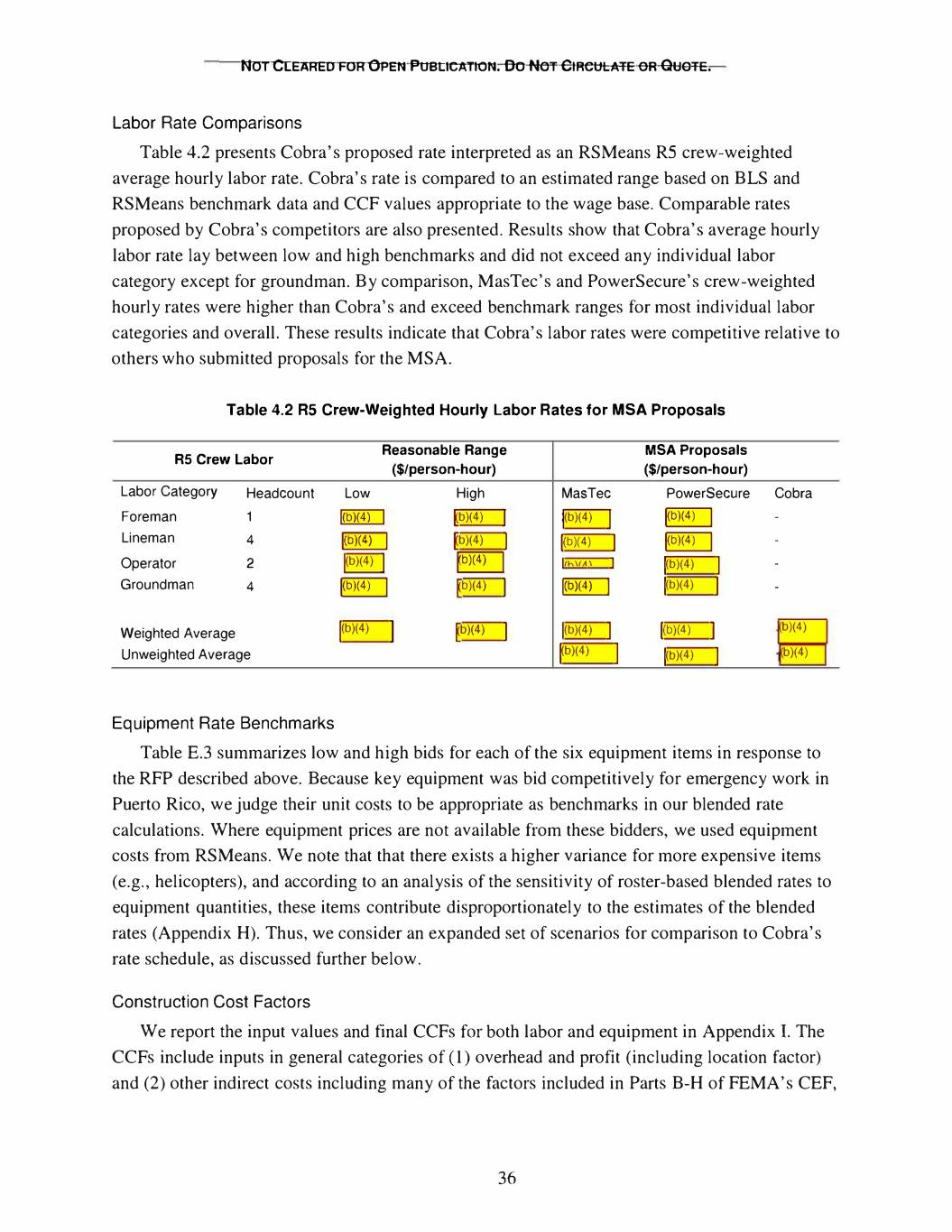
Nor CLEARED FOR OPEN PUBLICATION. Do NOT CIRCULATE OR QUOTE. Labor Rate Comparisons Table 4.2 presents Cobra's proposed rate interpreted as an RSMeans RS crew-weighted average hourly labor rate. Cobra's rate is compared to an estimated range based on BLS and RSMeans benchmark data and CCF values appropriate to the wage base. Comparable rates proposed by Cobra's competitors are also presented. Results show that Cobra's average hourly labor rate lay between low and high benchmarks and did not exceed any individual labor category except for groundman. By comparison, MasTec's and PowerSecure's crew-weighted hourly rates were higher than Cobra's and exceed benchmark ranges for most individual labor categories and overall. These results indicate that Cobra's labor rates were competitive relative to others who submitted proposals for the MSA. Table 4.2 RS Crew-Weighted Hourly Labor Rates for MSA Proposals Reasonable Range MSA Proposals RS Crew Labor ($/person-hour) ($/person-hour) Labor Category Headcount Low High MasTec PowerSecure Cobra - Foreman 1 lililliD �b)(4) I j(b)(4) I � Lineman 4 - � �b)(4) I l<b)(4) I � Operator 2 lrn\lA 1 I - l(b)(4) I � l<b)(4) I Groundman - 4 � [b)(4) I � l<b)(4) I Weighted Average l<b)(4) b)(4) I [b)(4) I l<b)(4) I l<b)(4) I Unweighted Average l<b)(4) I l<b)(4) I b)(4) Equipment Rate Benchmarks Table E.3 summarizes low and high bids for each of the six equipment items in response to the RFP described above. Because key equipment was bid competitively foremergency work in Puerto Rico, we judge their unit costs to be appropriate as benchmarks in our blended rate calculations. Where equipment prices are not available from these bidders, we used equipment costs from RSMeans. We note that that there exists a higher variance formore expensive items (e.g., helicopters), and according to an analysis of the sensitivity of roster-based blended rates to equipment quantities, these items contribute disproportionately to the estimates of the blended rates (Appendix H). Thus, we consider an expanded set of scenarios forcomparison to Cobra's rate schedule, as discussed further below. Construction Cost Factors We report the input values and final CCFs for both labor and equipment in Appendix I. The CCFs include inputs in general categories of (1) overhead and profit (including location factor) and (2) other indirect costs including many of the factors included in Parts B-H of FEMA's CEF, 36
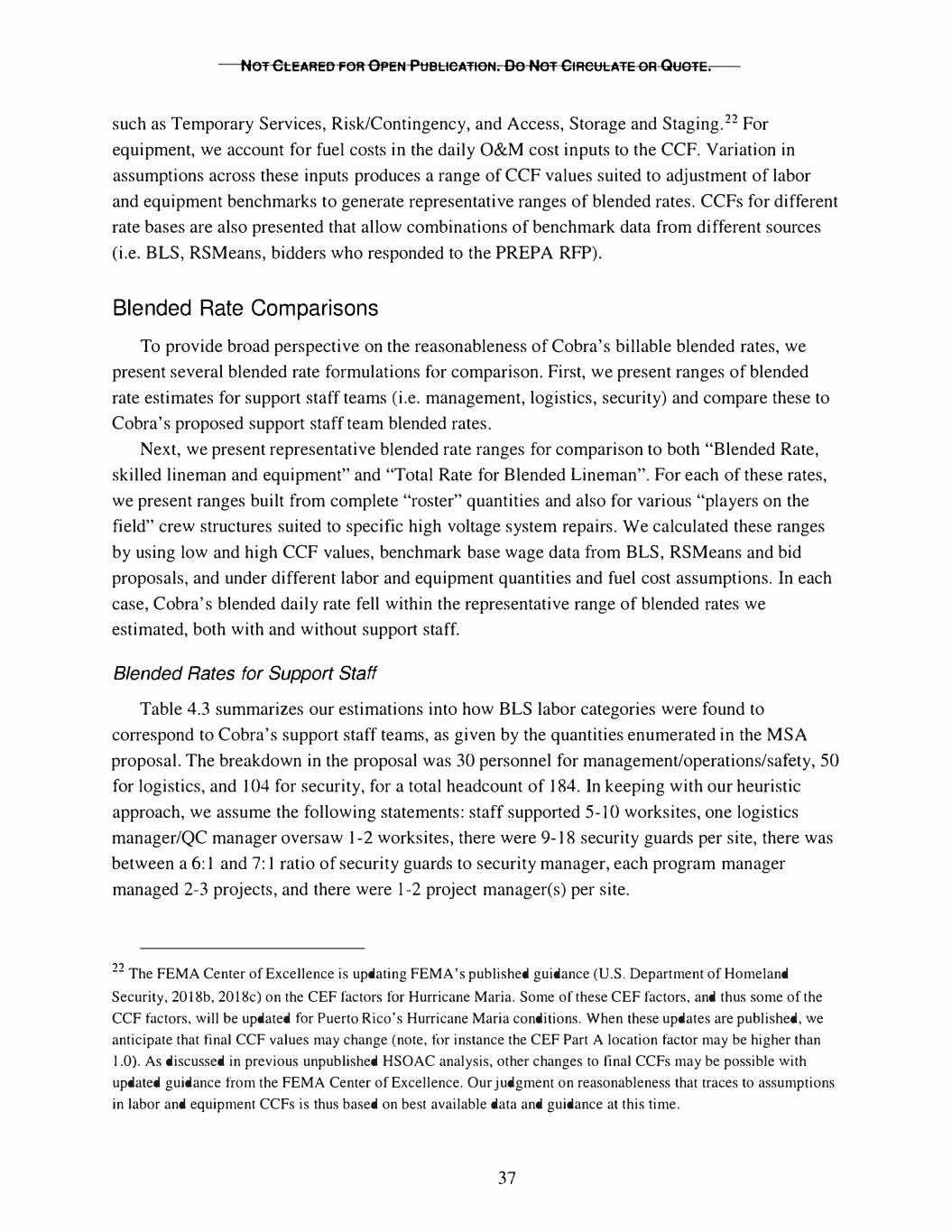
NOT CLEARED FOR OPEN PUBLICATION. 00 NOT CIRCULATE OR QUOTE. 22 such as Temporary Services, Risk/Contingency, and Access, Storage and Staging. For equipment, we account forfuel costs in the daily O&M cost inputs to the CCF. Variation in assumptions across these inputs produces a range of CCF values suited to adjustment of labor and equipment benchmarks to generate representative ranges of blended rates. CCFs fordifferent rate bases are also presented that allow combinations of benchmark data from different sources (i.e. BLS, RSMeans, bidders who responded to the PREPA RFP). Blended Rate Comparisons To provide broad perspective on the reasonableness of Cobra's billable blended rates, we present several blended rate formulations forcomparison. First, we present ranges of blended rate estimates forsupport staffteams (i.e. management, logistics, security) and compare these to Cobra's proposed support staff team blended rates. Next, we present representative blended rate ranges for comparison to both "Blended Rate, skilled lineman and equipment" and "Total Rate for Blended Lineman". For each of these rates, we present ranges built from complete "roster" quantities and also for various "players on the field" crew structures suited to specific high voltage system repairs. We calculated these ranges by using low and high CCF values, benchmark base wage data from BLS, RSMeans and bid proposals, and under different labor and equipment quantities and fuel cost assumptions. In each case, Cobra's blended daily rate fell within the representative range of blended rates we estimated,Blended Rates both with for andSupport without Staff support staff. Table 4.3 summarizes our estimations into how BLS labor categories were found to correspond to Cobra's support staffteams, as given by the quantities enumerated in the MSA proposal. The breakdown in the proposal was 30 personnel formanagement/operations/safety, 50 for logistics, and 104 forsecurity, fora total headcount of 184. In keeping with our heuristic approach, we assume the following statements: staff supported 5-10 worksites, one logistics manager/QC manager oversaw 1-2 worksites, there were 9-18 security guards per site, there was between a 6: 1 and 7: 1 ratio of security guards to security manager, each program manager managed 2-3 projects, and there were 1-2 project manager(s) per site. 22 The FEMA Center of Excellence is updating FEMA's published guidance (U.S. Department of Homeland Security, 2018b, 2018c) on the CEF factors forHurricane Maria. Some of these CEF factors, and thus some of the CCF factors, will be updated for Puerto Rico's Hurricane Maria conditions. When these updates are published, we anticipate that final CCF values may change (note, for instance the CEF Part A location factor may be higher than l.0). As discussed in previous unpublished HSOAC analysis, other changes to final CCFs may be possible with updated guidance from the FEMA Center of Excellence. Our judgment on reasonableness that traces to assumptions in labor and equipment CCFs is thus based on best available data and guidance at this time. 37
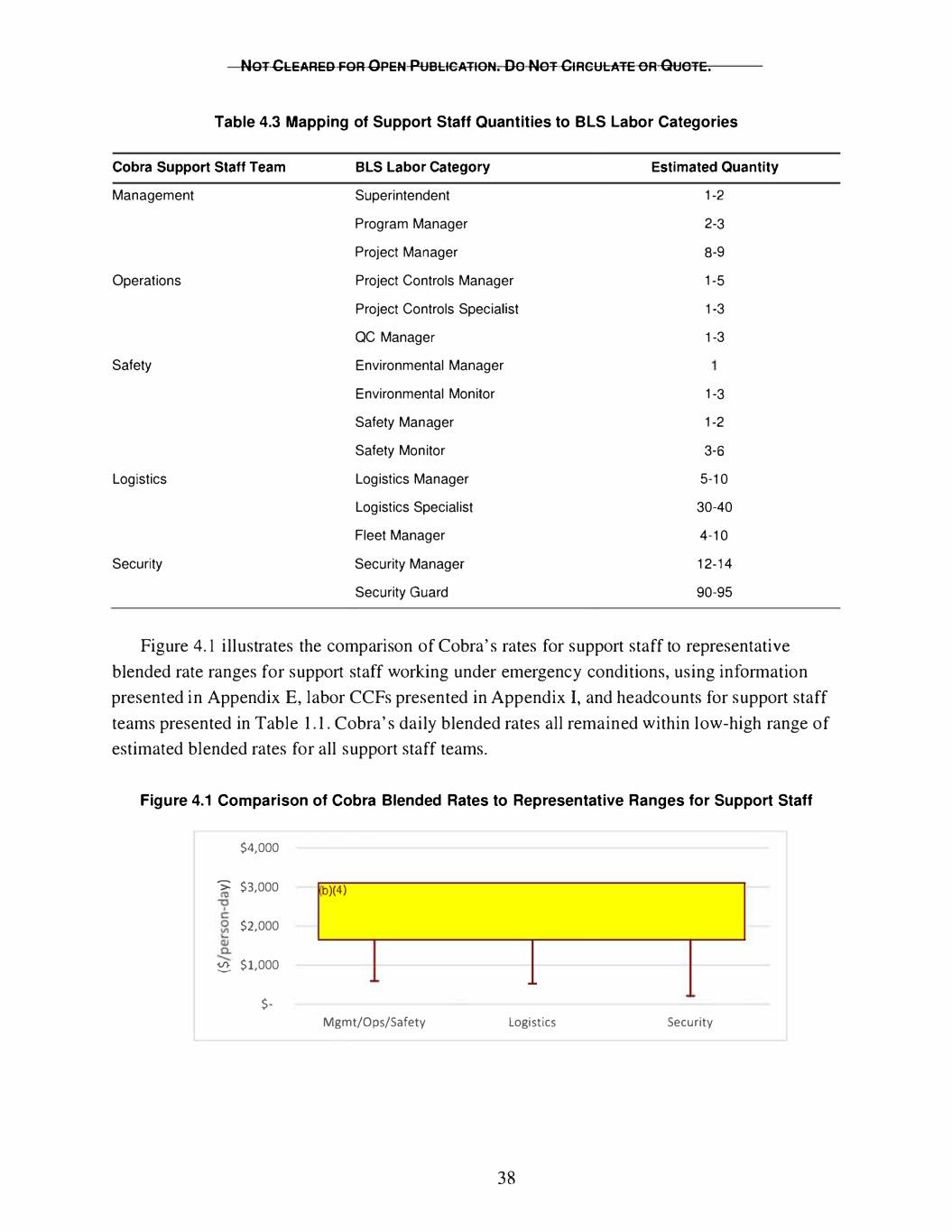
NOT CLEARED FOR OPE�I PUBLICATION. 00 NOT CIRCULATE OR QUOTE. Table 4.3 Mapping of Support Staff Quantities to BLS Labor Categories Cobra Support StaffTeam BLS Labor Category Estimated Quantity Management Superintendent 1-2 Program Manager 2-3 Project Manager 8-9 Operations Project Controls Manager 1-5 Project Controls Specialist 1-3 QC Manager 1-3 Safety Environmental Manager Environmental Monitor 1-3 Safety Manager 1-2 Safety Monitor 3-6 Logistics Logistics Manager 5-10 Logistics Specialist 30-40 Fleet Manager 4-10 Security Security Manager 12-14 Security Guard 90-95 Figure 4.1 illustrates the comparison of Cobra's rates for support staff to representative blended rate ranges for support staff working under emergency conditions, using information presented in Appendix E, labor CCFs presented in Appendix I, and headcounts for support staff teams presented in Table 1.1. Cobra's daily blended rates all remained within low-high range of estimated blended rates forall support staff teams. Figure 4.1 Comparison of Cobra Blended Rates to Representative Ranges for Support Staff $4,000 > $3,000 b)(4) $2,000 � $1,000 $- Mgmt/Ops/Safety Logistics Security 38
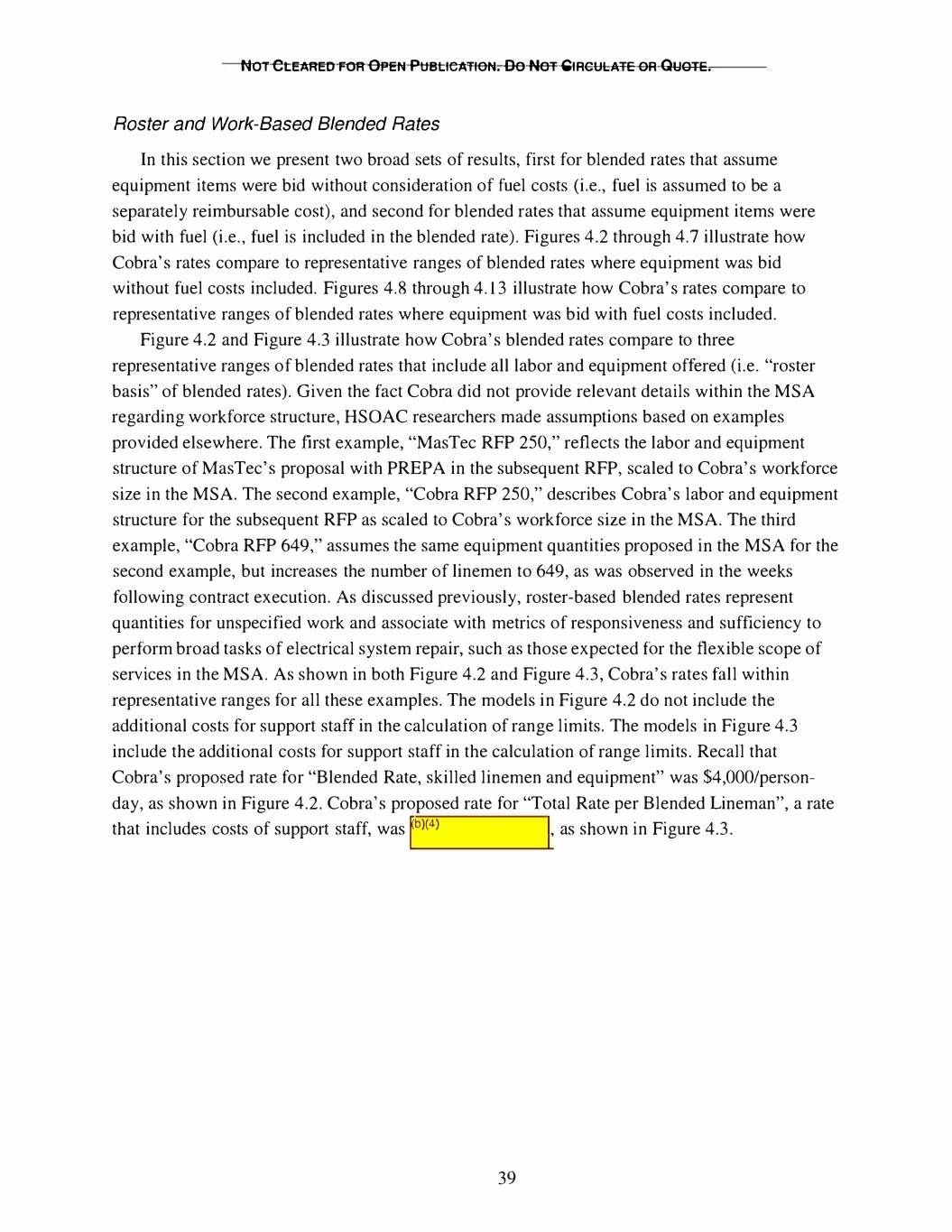
NOT CtEAFIEDF0Ft OPEN PUBLICATION. Do NOT CIRCULATE OR QUOTE. Roster and Work-Based Blended Rates In this section we present two broad sets of results, first for blended rates that assume equipment items were bid without consideration of fuel costs (i.e., fuel is assumed to be a separately reimbursable cost), and second forblended rates that assume equipment items were bid with fuel (i.e., fuel is included in the blended rate). Figures 4.2 through 4.7 illustrate how Cobra's rates compare to representative ranges of blended rates where equipment was bid without fuel costs included. Figures 4.8 through 4.13 illustrate how Cobra's rates compare to representative ranges of blended rates where equipment was bid with fuel costs included. Figure 4.2 and Figure 4.3 illustrate how Cobra's blended rates compare to three representative ranges of blended rates that include all labor and equipment offered (i.e. "roster basis" of blended rates). Given the factCobra did not provide relevant details within the MSA regarding workforce structure, HSOAC researchers made assumptions based on examples provided elsewhere. The firstexample, "MasTec RFP 250," reflectsthe labor and equipment structure of MasTec's proposal with PREPA in the subsequent RFP, scaled to Cobra's workforce size in the MSA. The second example, "Cobra RFP 250," describes Cobra's labor and equipment structure for the subsequent RFP as scaled to Cobra's workforcesize in the MSA. The third example, "Cobra RFP 649," assumes the same equipment quantities proposed in the MSA forthe second example, but increases the number of linemen to 649, as was observed in the weeks following contract execution. As discussed previously, roster-based blended rates represent quantities for unspecified work and associate with metrics of responsiveness and sufficiency to perform broad tasks of electrical system repair, such as those expected for the flexiblescope of services in the MSA. As shown in both Figure 4.2 and Figure 4.3, Cobra's rates fall within representative ranges forall these examples. The models in Figure 4.2 do not include the additional costs for support staffin the calculation of range limits. The models in Figure 4.3 include the additional costs for support staff in the calculation of range limits. Recall that Cobra's proposed rate for"Blended Rate, skilled linemen and equipment" was $4,000/person day, as shown in Figure 4.2. Cobra's proposed rate for"Total Rate per Blended Lineman", a rate that includes costs of support staff, was 4 as shown in Figure 4.3. fb)( ) ,, 39
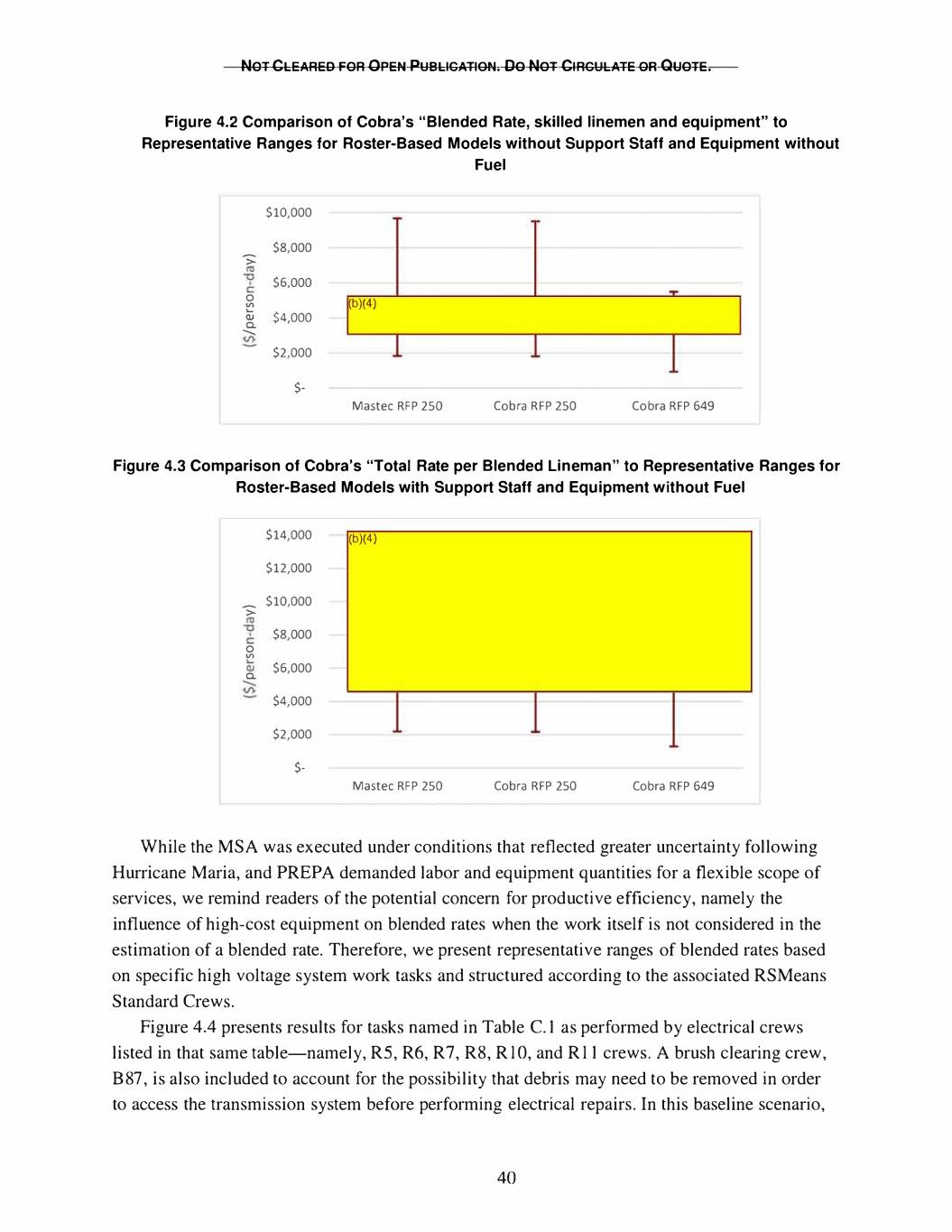
NOT CLEARED FOR OPEN PUBLICATlml. Do NOT CIRCULATE OR QUOTE. Figure 4.2 Comparison of Cobra's "Blended Rate, skilled linemen and equipment" to Representative Ranges for Roster-Based Models without Support Staff and Equipment without Fuel $10,000 > $8,000 $6,000 0 v> (b)(4) Q) $4,000 ......a. $2,000 $- Mastec RFP 250 Cobra RFP 250 Cobra RFP 649 Figure 4.3 Comparison of Cobra's "Total Rate per Blended Lineman" to Representative Ranges for Roster-Based Models with Support Staff and Equipment without Fuel $14,000 (b)(4) $12,000 > $10,000 $8,000 0 v> $6,000 a. $4,000 $2,000 $- Mastec RFP 250 Cobra RFP 250 Cobra RFP 649 While the MSA was executed under conditions that reflected greater uncertainty following Hurricane Maria, and PREP A demanded labor and equipment quantities fora flexible scope of services, we remind readers of the potential concern for productive efficiency, namely the influence of high-cost equipment on blended rates when the work itself is not considered in the estimation of a blended rate. Therefore, we present representative ranges of blended rates based on specific high voltage system work tasks and structured according to the associated RSMeans Standard Crews. Figure 4.4 presents results fortasks named in Table C.1 as performedby electrical crews listed in that same table-namely, R5, R6, R7, R8, RlO, and Rl 1 crews. A brush clearing crew, B87, is also included to account for the possibility that debris may need to be removed in order to access the transmission system before performing electrical repairs. In this baseline scenario, 40

NOT CLEARED FOR OPEN PUBLICATION. Do No I CiRCULAIE OR QUOTE. work is completed on flatterrain without support staff. Cobra's "Blended Rate, skilled linemen and equipment" appears at the top of the range for nearly all work crews under these assumptions. Figure 4.4 Comparison of Cobra's "Blended Rate, skilled lineman and equipment" to Representative Ranges for High Voltage System Repairs on Flat Terrain without Support Staff and Equipment without Fuel $8,000 � $6,000 -0 l f°"'1 Pl����-e=:)� II � �1('1 · '-T" l l l l l l RS R6 R7 R8 RlO Rll 887 Figure 4.5 shows results for the same electrical repairs performed on flat, accessible terrain with support staff. That is, Cobra's "Total Rate per Blended Lineman" is compared to representative ranges of work performed according to RSMeans electrical crew structures with support staff costs added to the estimates. Under these assumptions, Cobra's proposed rate from the perspective of only the RSMeans R7 crew-a materials handling and disposal crew-is at the upper limits of a representative range of blended rates under these assumptions. Figure 4.5 Comparison of Cobra's "Total Rate per Blended Lineman" to Representative Ranges for High Voltage System Repairs on Flat Terrain with Support Staff and Equipment without Fuel $12,000 $10,000 > $8,000 T -0 b)(4) T - $6,000 � $4,000 $2,000 .. $- RS R6 R7 R8 RlO Rll 887 41
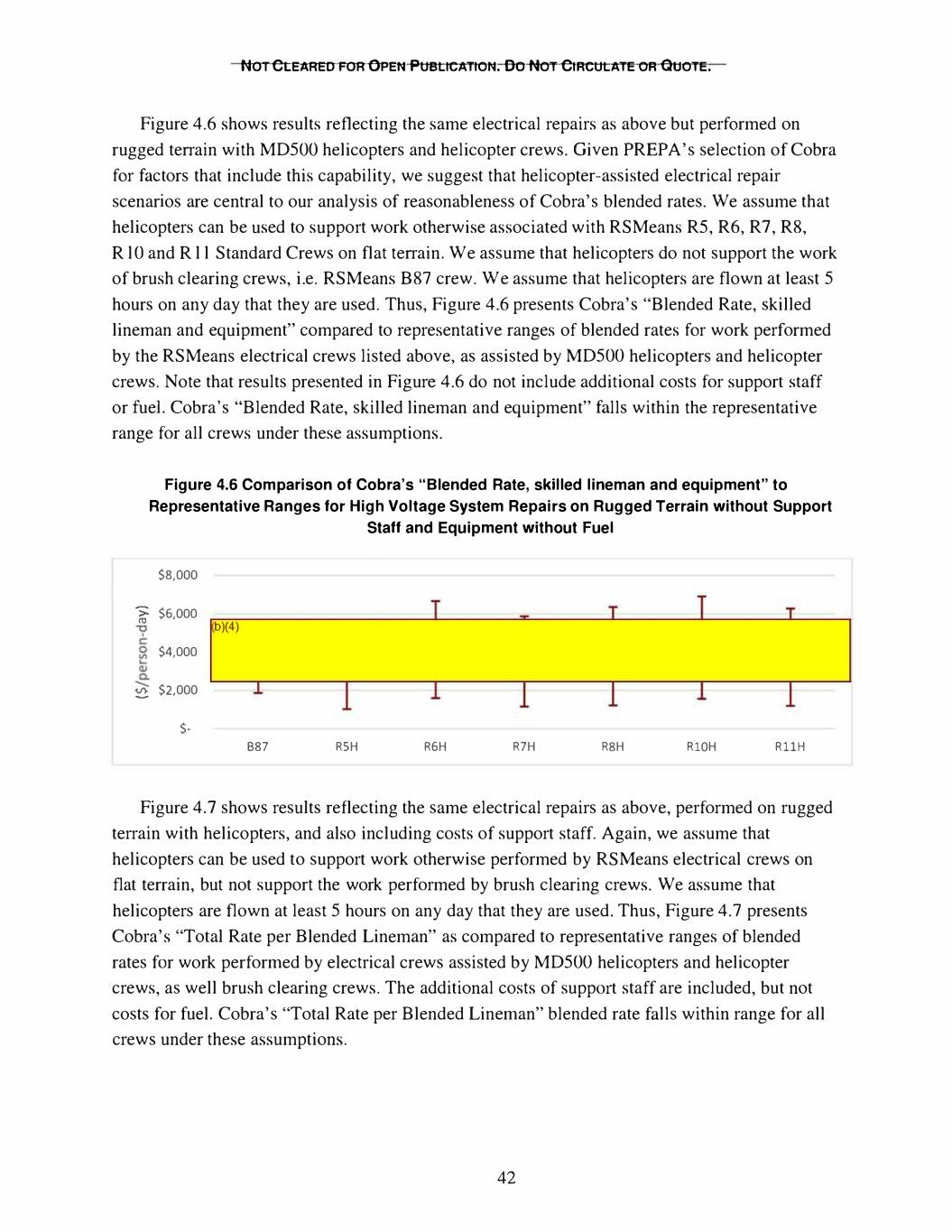
NOT CLEARED FOR OPEN PUBLICATION. Do NOT CIRCULATE OR QUOTE. Figure 4.6 shows results reflecting the same electrical repairs as above but performed on rugged tenain with MD500 helicopters and helicopter crews. Given PREPA's selection of Cobra for factors that include this capability, we suggest that helicopter-assisted electrical repair scenarios are central to our analysis of reasonableness of Cobra's blended rates. We assume that helicopters can be used to support work otherwise associated with RSMeans RS, R6, R7, R8, RlO and Rll Standard Crews on flat tenain. We assume that helicopters do not support the work of brush clearing crews, i.e. RSMeans B87 crew. We assume that helicopters are flown at least 5 hours on any day that they are used. Thus, Figure 4.6 presents Cobra's "Blended Rate, skilled lineman and equipment" compared to representative ranges of blended rates for work performed by the RSMeans electrical crews listed above, as assisted by MD500 helicopters and helicopter crews. Note that results presented in Figure 4.6 do not include additional costs for support staff or fuel. Cobra's "Blended Rate, skilled lineman and equipment" falls within the representative range for all crews under these assumptions. Figure 4.6 Comparison of Cobra's "Blended Rate, skilled lineman and equipment" to Representative Ranges for High Voltage System Repairs on Rugged Terrain without Support Staff and Equipment without Fuel $8,000 > $6,000 ro b)(4) $4,000 � $2,000 $- 887 RSH R6H R7H R8H Rl0H RllH Figure 4.7 shows results reflecting the same electrical repairs as above, performed on rugged terrain with helicopters, and also including costs of support staff. Again, we assume that helicopters can be used to support work otherwise performed by RSMeans electrical crews on flat terrain, but not support the work performed by brush clearing crews. We assume that helicopters are flown at least 5 hours on any day that they are used. Thus, Figure 4. 7 presents Cobra's "Total Rate per Blended Lineman" as compared to representative ranges of blended rates for work performed by electrical crews assisted by MD500 helicopters and helicopter crews, as well brush clearing crews. The additional costs of supp01t staff are included, but not costs for fuel. Cobra's "Total Rate per Blended Lineman" blended rate fallswithin range for all crews under these assumptions. 42
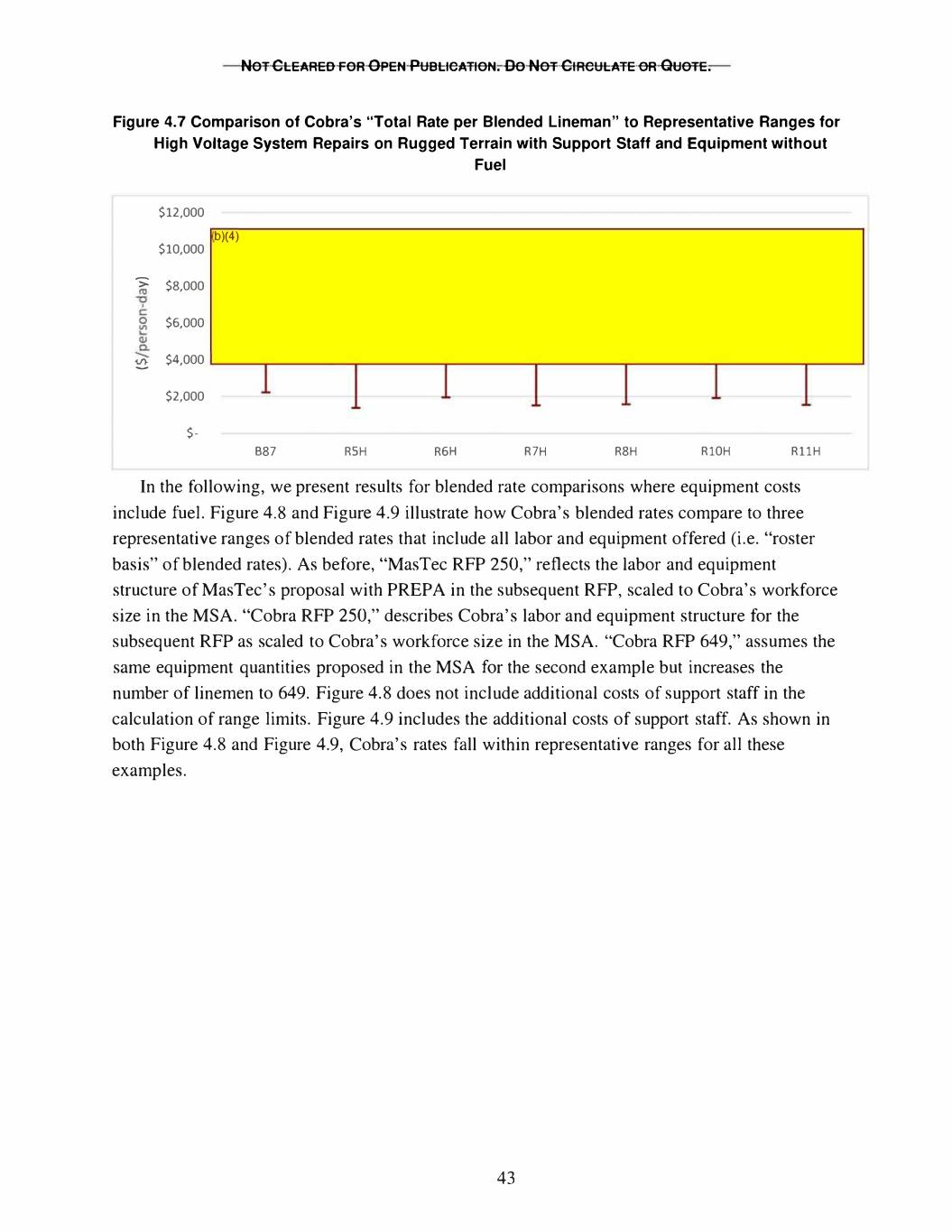
NOT CLEARED FOR OPEN PUBLICATION. 00 NOT CIRCULATE OR QUOTE. Figure 4.7 Comparison of Cobra's "Total Rate per Blended Lineman" to Representative Ranges for High Voltage System Repairs on Rugged Terrain with Support Staff and Equipment without Fuel $12,000 b)(4) $10,000 > $8,000 $6,000 � $4,000 $2,000 $- B87 R5H R6H R7H R8H Rl0H RllH In the following, we present results for blended rate comparisons where equipment costs include fuel. Figure 4.8 and Figure 4.9 illustrate how Cobra's blended rates compare to three representative ranges of blended rates that include all labor and equipment offered (i.e. "roster basis" of blended rates). As before, "MasTec RFP 250," reflectsthe labor and equipment structure of MasTec's proposal with PREPA in the subsequent RFP, scaled to Cobra's workforce size in the MSA. "Cobra RFP 250," describes Cobra's labor and equipment structure for the subsequent RFP as scaled to Cobra's workforce size in the MSA. "Cobra RFP 649," assumes the same equipment quantities proposed in the MSA for the second example but increases the number of linemen to 649. Figure 4.8 does not include additional costs of support staff in the calculation of range limits. Figure 4.9 includes the additional costs of support staff. As shown in both Figure 4.8 and Figure 4.9, Cobra's rates fall within representative ranges for all these examples. 43

Nor CLEA.REDFOR OPEN PUElblCATION. Do NOT CIRCULATEOR QUOTE. Figure 4.8 Comparison of Cobra's "Blended Rate, skilled linemen and equipment" to Representative Ranges for Roster-Based Models without Support Staff and Equipment with Fuel $12,000 (b)(4) $10,000 > $8,000 $6,000 <I). $4,000 $2,000 $- Mastec RFP 250 Cobra RFP 250 Cobra RFP 649 Figure 4.9 Comparison of Cobra's "Total Rate per Blended Lineman" to Representative Ranges for Roster-Based Models with Support Staff and Equipment with Fuel $16,000 b)(4) $14,000 $12,000 > $10,000 $8,000 � $6,000 $4,000 $2,000 $- Mastec RFP 250 Cobra RFP 250 Cobra RFP 649 Again, we present representative ranges of blended rates based on specific high voltage system work tasks and structured according to the associated RSMeans Standard Crews. In Figure 4.10 through Figure 4.13, results reflect blended rate ranges where equipment costs include fuel costs. Figure 4.10 presents results for tasks named in Table C. l as performed by electrical crews listed in that same table-namely, B87, RS, R6, R7, RS, RIO, and Rl 1 crews. In this baseline scenario, work is completed on flat terrain without support staff, but equipment is assumed to be bid with fuel costs included. Cobra's "Blended Rate, skilled linemen and equipment" appears at the top of the range for nearly all work crews under these assumptions. 44
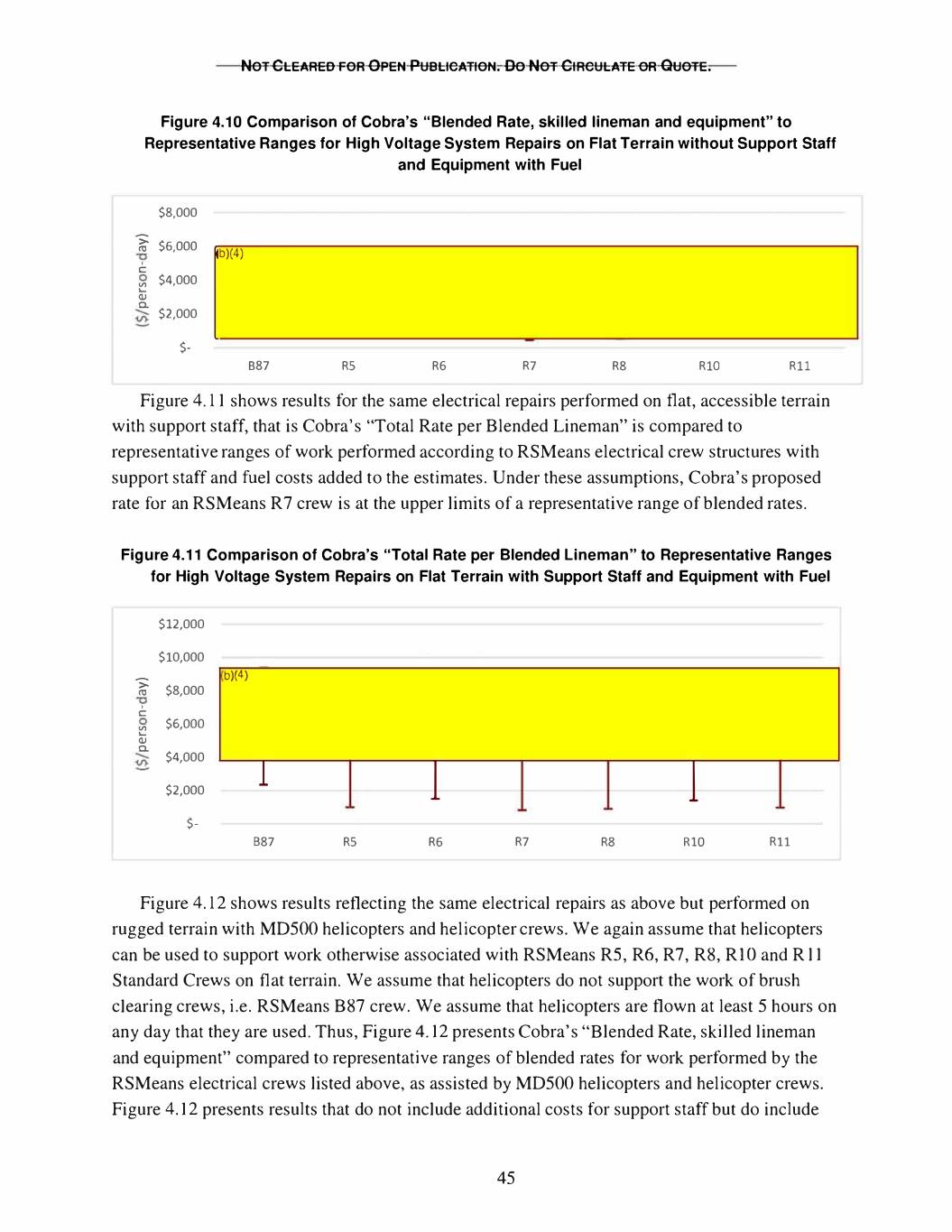
NOT CLEARED FOR OPEN PUBLICATION. 00 NOT CIRCULATE OR QUOTE. Figure 4.10 Comparison of Cobra's "Blended Rate, skilled lineman and equipment" to Representative Ranges for High Voltage System Repairs on Flat Terrain without Support Staff and Equipment with Fuel $8,000 >ro $6,000 c V> $4,000 L. OJ a. $2,000 lb)(4) $- 887 RS RG R7 R8 RlO Rll Figure 4.11 shows results for the same electrical repairs performed on flat, accessible terrain with support staff,that is Cobra's "Total Rate per Blended Lineman" is compared to representative ranges of work performedaccording to RSMeans electrical crew structures with support staff and fuelcosts added to the estimates. Under these assumptions, Cobra's proposed rate for an RSMeans R7 crew is at the upper limits of a representative range of blended rates. Figure 4.11 Comparison of Cobra's "Total Rate per Blended Lineman" to Representative Ranges for High Voltage System Repairs on Flat Terrain with Support Staff and Equipment with Fuel $12,000 $10,000 b)(4) >ro $8,000 c V> $6,000 L. OJ a. $4,000 1 $2,000 l l $- B87 RS RG R7 RS RlO Rll Figure 4.12 shows results reflecting the same electrical repairs as above but performedon rugged terrain with MD500 helicopters and helicopter crews. We again assume that helicopters can be used to support work otherwise associated with RSMeans RS, R6, R7, R8, RIO and Rl1 Standard Crews on flat terrain. We assume that helicopters do not support the work of brush clearing crews, i.e. RSMeans B87 crew. We assume that helicopters are flownat least 5 hours on any day that they are used. Thus, Figure 4.12 presents Cobra's "Blended Rate, skilled lineman and equipment" compared to representative ranges of blended rates forwork performedby the RSMeans electrical crews listed above, as assisted by MD500 helicopters and helicopter crews. Figure 4.12 presents results that do not include additional costs for support staff but do include 45
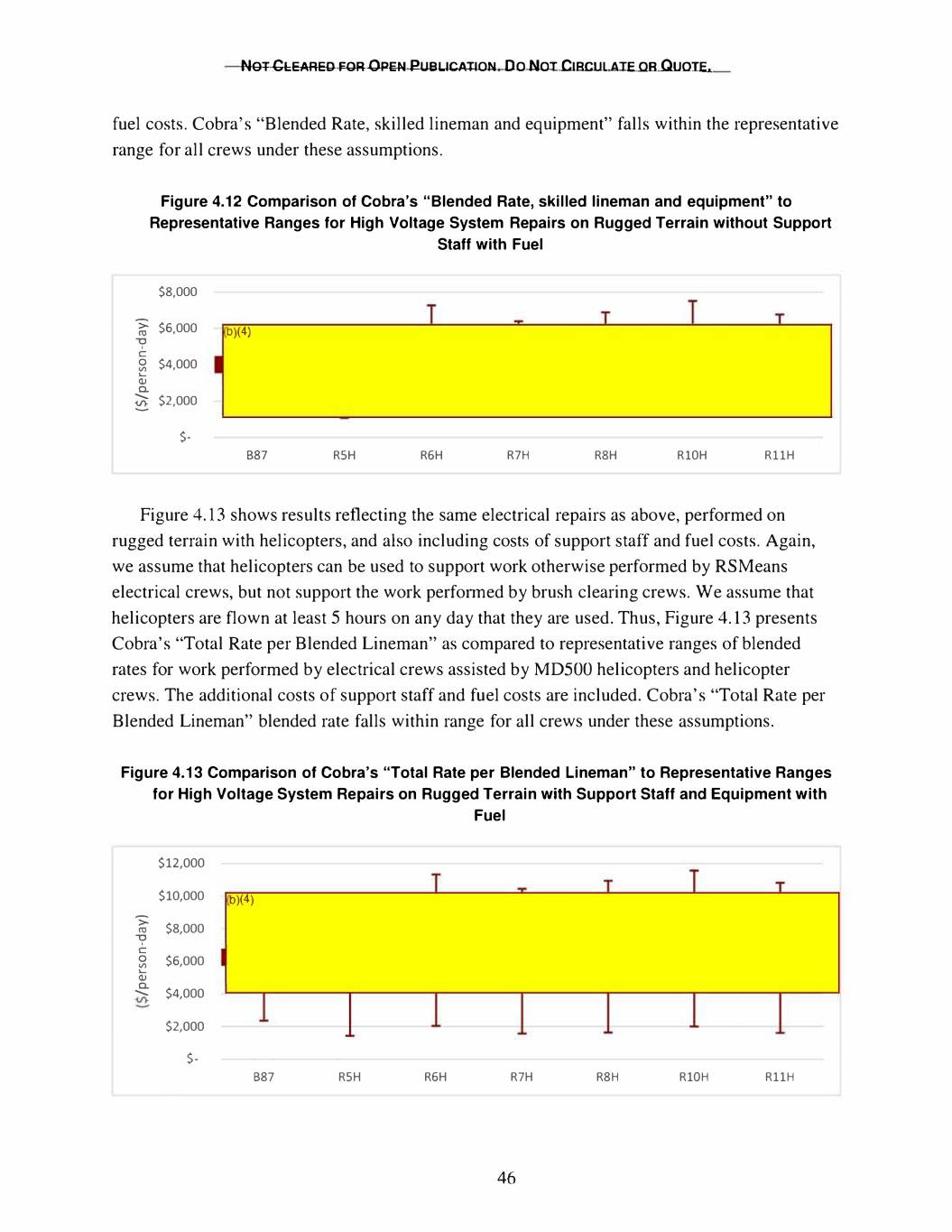
NOT CLEARED FOR OPEN PUSLICATION Do Nor CIBCIII ATE OR OUOTF. fuel costs. Cobra's "Blended Rate, skilled lineman and equipment" falls within the representative range forall crews under these assumptions. Figure 4.12 Comparison of Cobra's "Blended Rate, skilled lineman and equipment" to Representative Ranges for High Voltage System Repairs on Rugged Terrain without Support Staff with Fuel $8,000 > $6,000 "' b)(4) "O 0c V) $4,000 L. (II ---a. � $2,000 $- 887 RSH RGH R7H R8H Rl0H RllH Figure 4.13 shows results reflectingthe same electrical repairs as above, performedon rugged terrain with helicopters, and also including costs of support staff and fuel costs. Again, we assume that helicopters can be used to support work otherwise performed by RSMeans electrical crews, but not support the work performed by brush clearing crews. We assume that helicopters are flown at least 5 hours on any day that they are used. Thus, Figure 4.13 presents Cobra's "Total Rate per Blended Lineman" as compared to representative ranges of blended rates for work performedby electrical crews assisted by MDSOO helicopters and helicopter crews. The additional costs of support staff and fuel costs are included. Cobra's "Total Rate per Blended Lineman" blended rate falls within range forall crews under these assumptions. Figure 4.13 Comparison of Cobra's "Total Rate per Blended Lineman" to Representative Ranges for High Voltage System Repairs on Rugged Terrain with Support Staff and Equipment with Fuel $12,000 $10,000 b)(4) > $8,000 "O"' 0c V) $6,000 L. (II a. --- $4,000 $2,000 $- B87 RSH RGH R7H R8H RlOH RllH 46

NOT CtEAFIEDFOR OPEN PUBLICATION. Do NOT CIRCULATE OR QUOTE. Together, then, Cobra's proposed blended rates were assessed in consideration of the situational uncertainty which prevailed in the days immediately followingMaria, as well as conditions when repairs may have allowed formore precise cost estimation and against industry standard comparisons for productive work, and forvaried work conditions and contradictory information. Cobra's blended rates fall within estimated ranges in all scenarios we considered. We conclude that Cobra's blended rates fall within representative ranges for high voltage emergency repair work. This conclusion is delivered from analytical investigation which combined knowledge of work conditions, assumptions into wage burdens, evaluation of the equipment quantities and workforcestructures, different assumptions about fuel costs, and inclusion of the best benchmark data and current adjustment factorsavailable at this time. 47
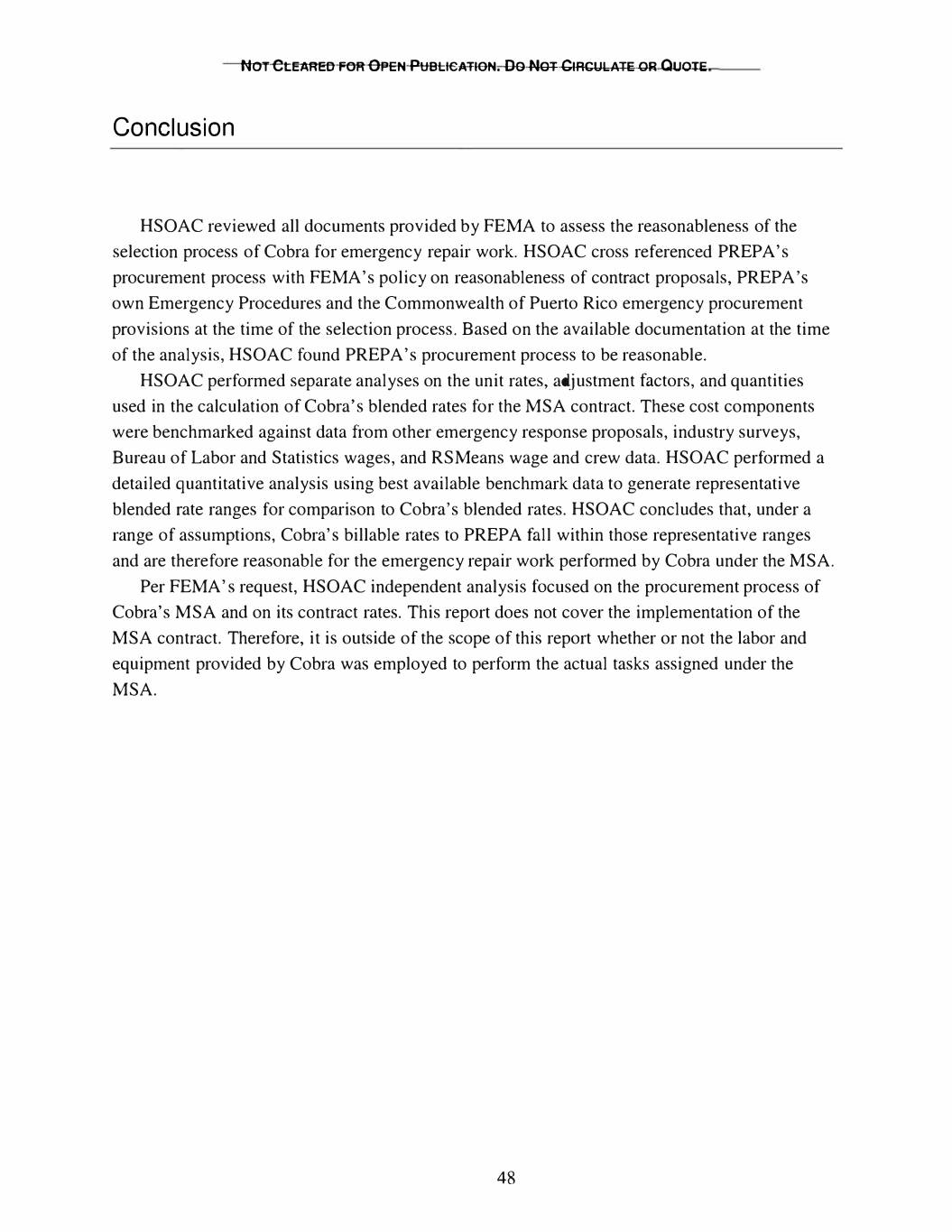
NOT CtEAFIEDFOR OPEN PUBLICATION. 00 NOT CIRCULATE OR QUOTE Conclusion HSOAC reviewed all documents provided by FEMA to assess the reasonableness of the selection process of Cobra for emergency repair work. HSOAC cross referenced PREPA's procurement process with FEMA's policy on reasonableness of contract proposals, PREPA's own Emergency Procedures and the Commonwealth of Puerto Rico emergency procurement provisions at the time of the selection process. Based on the available documentation at the time of the analysis, HSOAC found PREPA's procurement process to be reasonable. HSOAC performedseparate analyses on the unit rates, adjustment factors, and quantities used in the calculation of Cobra's blended rates forthe MSA contract. These cost components were benchmarked against data from other emergency response proposals, industry surveys, Bureau of Labor and Statistics wages, and RSMeans wage and crew data. HSOAC performed a detailed quantitative analysis using best available benchmark data to generate representative blended rate ranges for comparison to Cobra's blended rates. HSOAC concludes that, under a range of assumptions, Cobra's billable rates to PREPA fall within those representative ranges and are thereforereasonable for the emergency repair work performed by Cobra under the MSA. Per FEMA' s request, HSOAC independent analysis focused on the procurement process of Cobra's MSA and on its contract rates. This report does not cover the implementation of the MSA contract. Therefore, it is outside of the scope of this report whether or not the labor and equipment provided by Cobra was employed to perform the actual tasks assigned under the MSA. 48
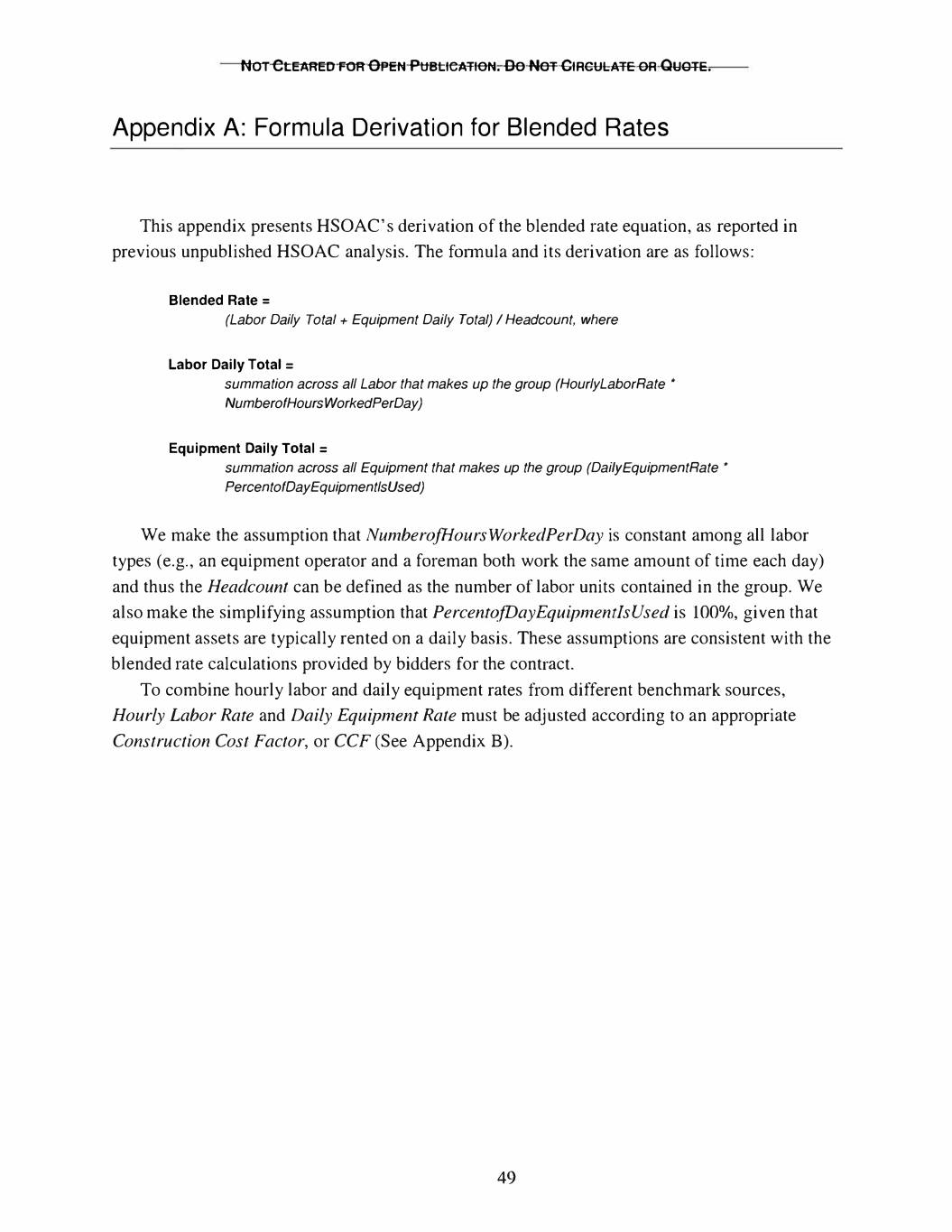
NOT CtEAFIEDF0Ft OPEN PUBLICATION. Do NOT CIRCULATE OR QUOTE. Appendix A: Formula Derivation for Blended Rates This appendix presents HSOAC' s derivation of the blended rate equation, as reported in previous unpublished HSOAC analysis. The formula and its derivation are as follows: Blended Rate = (Labor Daily Total+ Equipment Daily Total) I Headcount, where Labor Daily Total = summation across all Labor that makes up the group (HourlyLaborRate • NumberofHoursWorkedPerDay) Equipment Daily Total = summation across all Equipment that makes up the group (DailyEquipmentRate • PercentofDayEquipmentlsUsed) We make the assumption that NumberofHoursWorkedPerDay is constant among all labor types (e.g., an equipment operator and a foreman both work the same amount of time each day) and thus the Headcount can be defined as the number of labor units contained in the group. We also make the simplifying assumption that PercentojDayEquipmentlsUsedis 100%, given that equipment assets are typically rented on a daily basis. These assumptions are consistent with the blended rate calculations provided by bidders for the contract. To combine hourly labor and daily equipment rates fromdifferent benchmark sources, Hourly Labor Rate and Daily Equipment Rate must be adjusted according to an appropriate Construction Cost Factor, or CCF (See Appendix B). 49
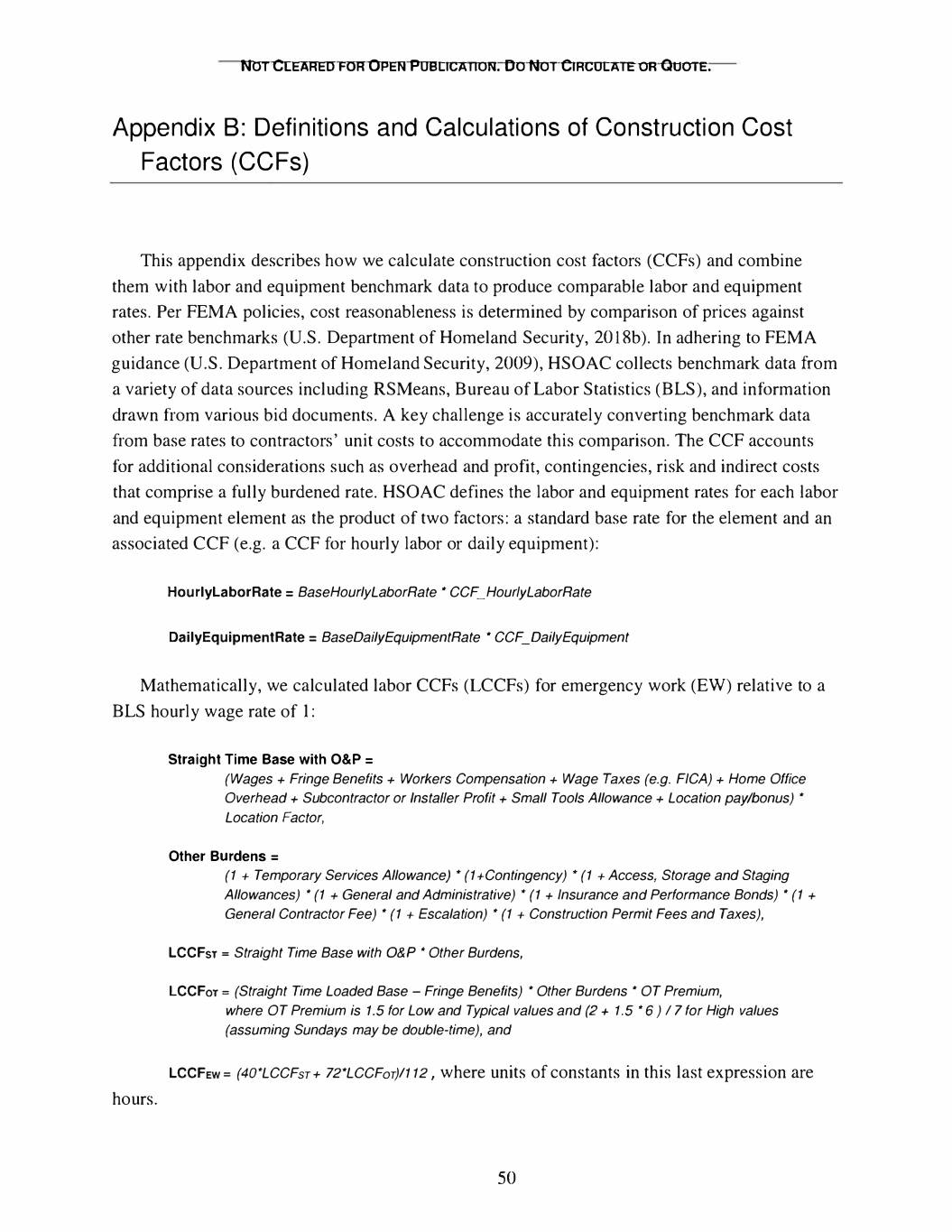
Nor CLEARED FOR OPEN PUBLICAIION. Do No, CiRCOLAIE OR OU0TE. Appendix B: Definitions and Calculations of Construction Cost Factors (CCFs) This appendix describes how we calculate construction cost factors (CCFs) and combine them with labor and equipment benchmark data to produce comparable labor and equipment rates. Per FEMA policies, cost reasonableness is determined by comparison of prices against other rate benchmarks (U.S. Department of Homeland Security, 2018b). In adhering to FEMA guidance (U.S. Department of Homeland Security, 2009), HSOAC collects benchmark data from a variety of data sources including RSMeans, Bureau of Labor Statistics (BLS), and information drawn from various bid documents. A key challenge is accurately converting benchmark data from base rates to contractors' unit costs to accommodate this comparison. The CCF accounts for additional considerations such as overhead and profit, contingencies, risk and indirect costs that comprise a fullyburdened rate. HSOAC defines the labor and equipment rates for each labor and equipment element as the product of two factors: a standard base rate for the element and an associatedHourlylaborRate CCF (e.g. a CCFBaseHourlyLaborRate for hourly labor • orCCF_Hour/yLaborRate daily equipment): = DailyEquipmentRate = BaseDailyEquipmentRate • CCF_DailyEquipment Mathematically, we calculated labor CCFs (LCCFs) for emergency work (EW) relative to a BLS hourlyStraight wage Time rate Base of with1: O&P = (Wages + Fringe Benefits + Workers Compensation + Wage Taxes (e.g. FICA) + Home Office Overhead+ Subcontractor or Installer Profit+ Small Tools Allowance + Location pay/bonus) • Location Factor, Other Burdens = (1 + Temporary Services Allowance) * (1 +Contingency) * (1 + Access, Storage and Staging Allowances) • (1 + General and Administrative) * (1 + Insurance and Performance Bonds) • (1 + General Contractor Fee) • (1 + Escalation) • (1 + Construction Permit Fees and Taxes), LCCFST = Straight Time Base with O&P • Other Burdens, LCCFor = (Straight Time Loaded Base - Fringe Benefits) • Other Burdens • OT Premium, where OT Premium is 1.5 for Low and Typical values and (2+ 1.5 • 6) I 7 for High values (assuming Sundays may be double-time), and LCCFEw= (40'LCCFsr+ 72*LCCFor)l112, where units of constants in this last expression are hours. 50
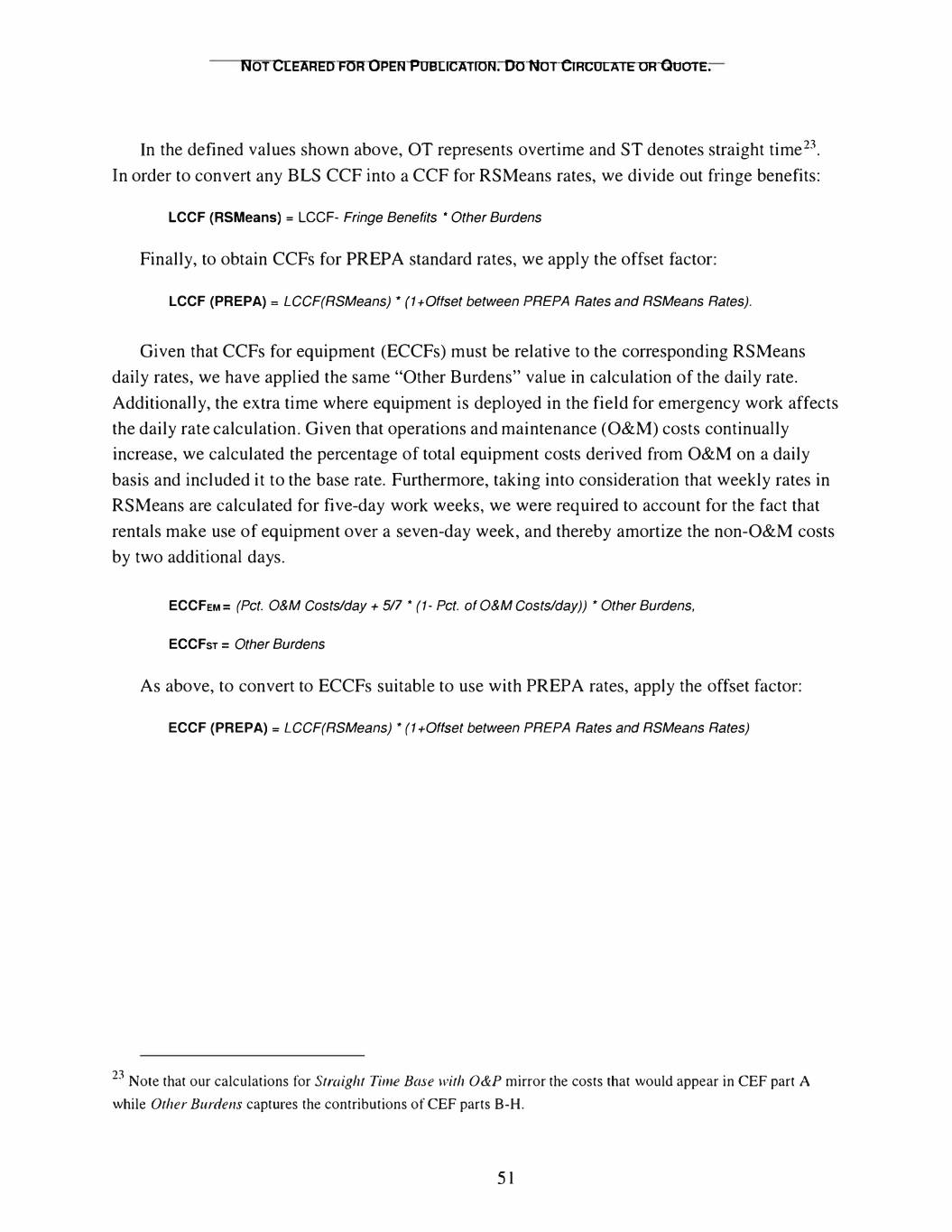
NOT CLEARED FOR OPEN PUBLICATION. Do No I CiRCULAIE OR QUOTE. 23 In the defined values shown above, OT represents overtime and ST denotes straight time . In order to convert any BLS CCF into a CCF for RSMeans rates, we divide out fringe benefits: LCCF (RSMeans) = LCCF- Fringe Benefits • Other Burdens Finally, to obtain CCFs for PREPA standard rates, we apply the offset factor: LCCF (PREPA) = LCCF(RSMeans) * {1+0ffset between PREPA Rates and RSMeans Rates). Given that CCFs for equipment (ECCFs) must be relative to the corresponding RSMeans daily rates, we have applied the same "Other Burdens" value in calculation of the daily rate. Additionally, the extra time where equipment is deployed in the field foremergency work affects the daily rate calculation. Given that operations and maintenance (O&M) costs continually increase, we calculated the percentage of total equipment costs derived fromO&M on a daily basis and included it to the base rate. Furthermore, taking into consideration that weekly rates in RSMeans are calculated forfive-day work weeks, we were required to account for the fact that rentals make use of equipment over a seven-day week, and thereby amortize the non-O&M costs by two additional days. ECCFeM = (Pct. O&M Costs/day+ 517 • (1- Pct. of O&M Costs/day)) • Other Burdens, ECCFsT = Other Burdens As above, to convert to ECCFs suitable to use with PREP A rates, apply the offset factor: ECCF (PREPA) = LCCF(RSMeans) * (1+0ffset between PREPA Rates and RSMeans Rates) 23 Note that our calculations for Straight Time Base with O&P mirror the costs that would appear in CEF part A while Other Burdens captures the contributions of CEF parts B-H. 51
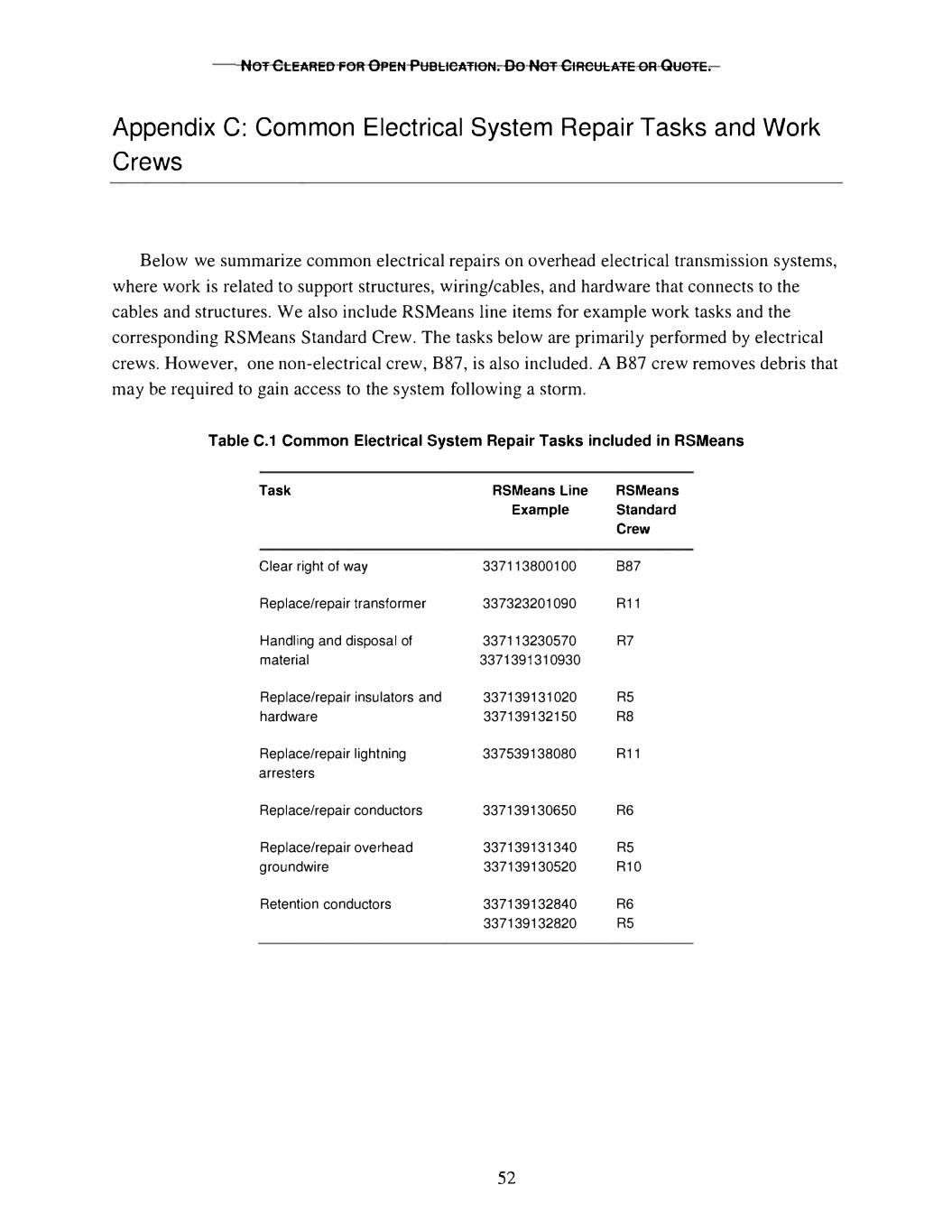
NOT CLEARED FOR OPEN PUBLICATION. 00 NOT CIRCULATE OR QUOTE. Appendix C: Common Electrical System Repair Tasks and Work Crews Below we summarize common electrical repairs on overhead electrical transmission systems, where work is related to support structures, wiring/cables, and hardware that connects to the cables and structures. We also include RSMeans line items for example work tasks and the corresponding RSMeans Standard Crew. The tasks below are primarily performed by electrical crews. However, one non-electrical crew, B87, is also included. A B87 crew removes debris that may be required to gain access to the system following a storm. Table C.1 Common Electrical System Repair Tasks included in RSMeans Task RSMeans Line RSMeans Example Standard Crew Clear right of way 337113800100 887 Replace/repair transformer 337323201090 R11 Handling and disposal of 337113230570 R7 material 3371391310930 Replace/repair insulators and 337139131020 R5 hardware 337139132150 RB Replace/repair lightning 337539138080 R11 arresters Replace/repair conductors 337139130650 R6 Replace/repair overhead 337139131340 R5 groundwire 337139130520 R10 Retention conductors 337139132840 R6 337139132820 R5 52
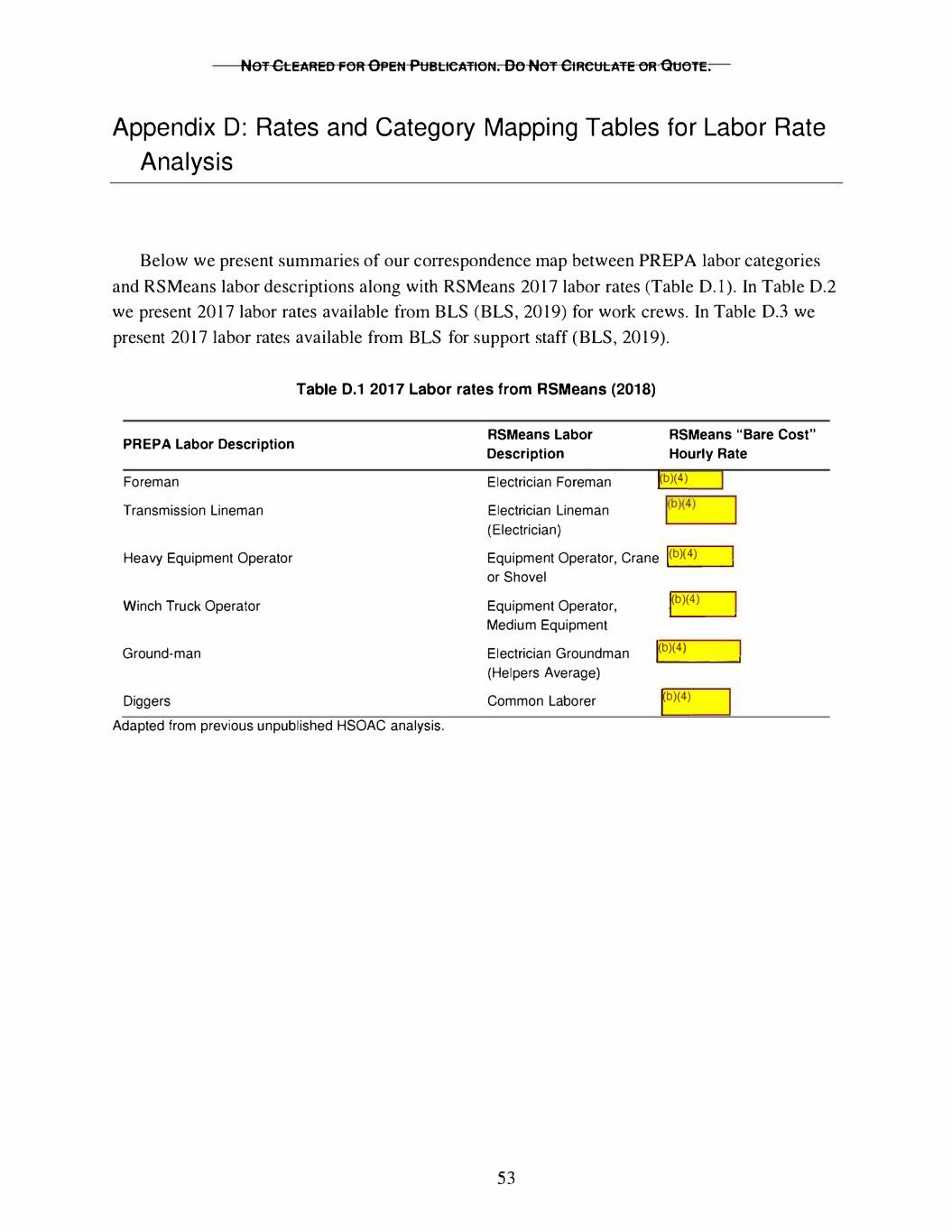
NOT CLEARED FOR OPEN PUBLICATION. 00 NOT CIRCULATE OR QUOTE. Appendix D: Rates and Category Mapping Tables for Labor Rate Analysis Below we present summaries of our correspondence map between A labor categories and RSMeans labor descriptions along with RSMeans 2017 labor rates (Table D.l). In Table D.2 PREP we present 2017 labor rates available fromBLS (BLS, 2019) for work crews. In Table D.3 we present 2017 labor rates available from BLS for support staff (BLS, 2019). Table D.1 2017 Labor rates from RSMeans (2018) RSMeans Labor RSMeans "Bare Cost" PREPA Labor Description Description Hourly Rate Foreman Electrician Foreman l(b)(4) Transmission Lineman Electrician Lineman (Electrician) 4 Heavy Equipment Operator Equipment Operator, Crane ._l(b_)< _ )_ _. or Shovel j(b)<4 ) Winch Truck Operator Equipment Operator, � _ _ -� Medium Equipment (bl )<4l Ground-man Electrician Groundman ._ _ _ ___. (Helpers Average) Diggers Common Laborer l(b)(4 ) Adapted from previous unpublished HSOAC analysis. 53
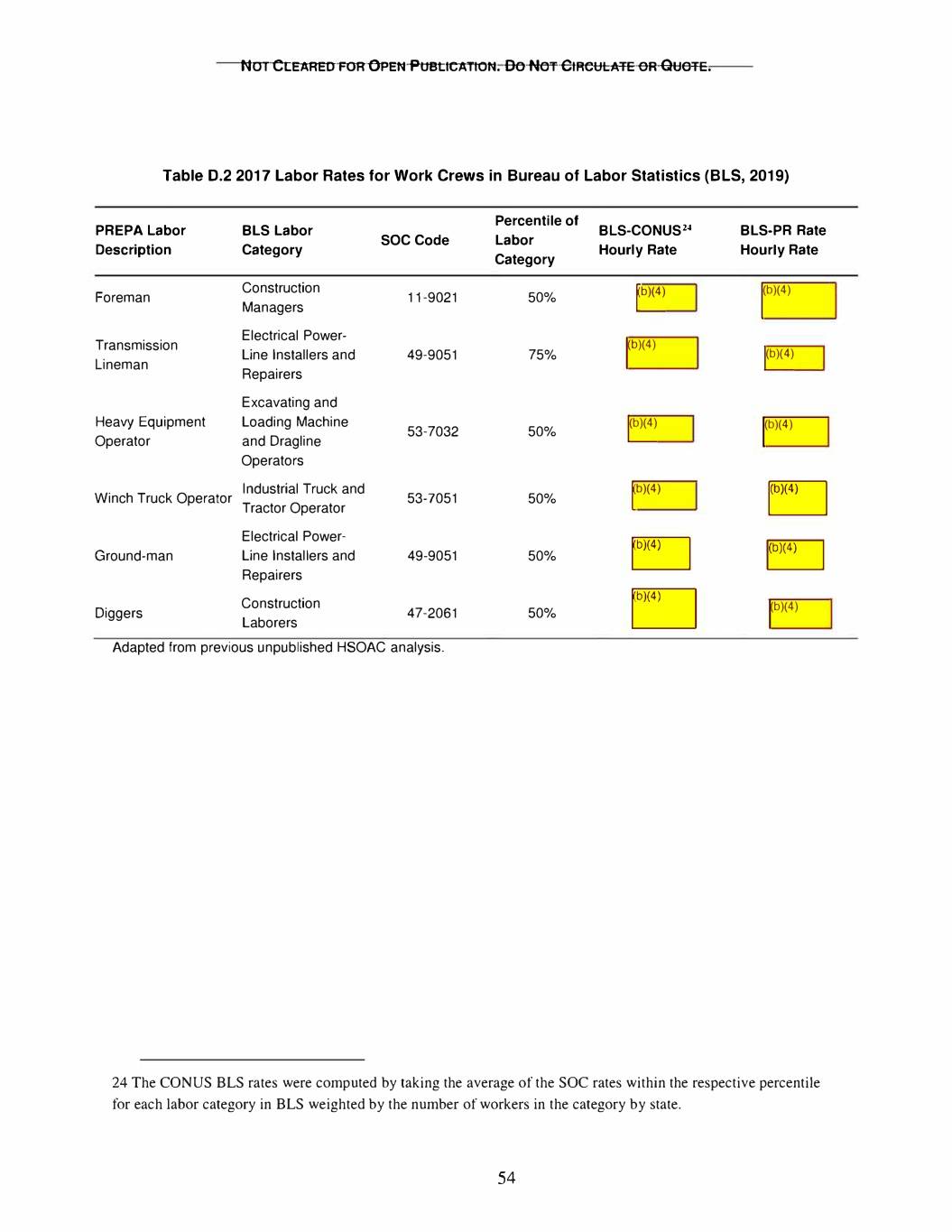
NoI CLEARED FOR OPEN PUBLICATION. Do NOT CIRCULATE OR QUOTE. Table D.2 2017 Labor Rates for Work Crews in Bureau of Labor Statistics (BLS, 2019) Percentile of PREPA Labor BLS Labor BLS-CONUS24 BLS-PR Rate SOC Code Labor Description Category Hourly Rate Hourly Rate Category Construction Foreman 11-9021 50% Managers b)(4) (b)(4) r l Electrical Power- Transmission Line Installers and 49-9051 75% (b)(4) Lineman l(b)(4) Repairers l Excavating and Heavy Equipment Loading Machine 53-7032 50% Operator and Dragline (b)(4) (b)(4) l l Operators Industrial Truck and Winch Truck Operator 53-7051 50% Tractor Operator b)(4) � r Electrical Power- Ground-man Line Installers and 49-9051 50% � Repairers EJ Construction Diggers 47-2061 50% Laborers LJ l(b)(4) Adapted from previous unpublished HSOAC analysis. 24 The CO NUS BLS rates were computed by taking the average of the SOC rates within the respective percentile for each labor category in BLS weighted by the number of workers in the category by state. 54
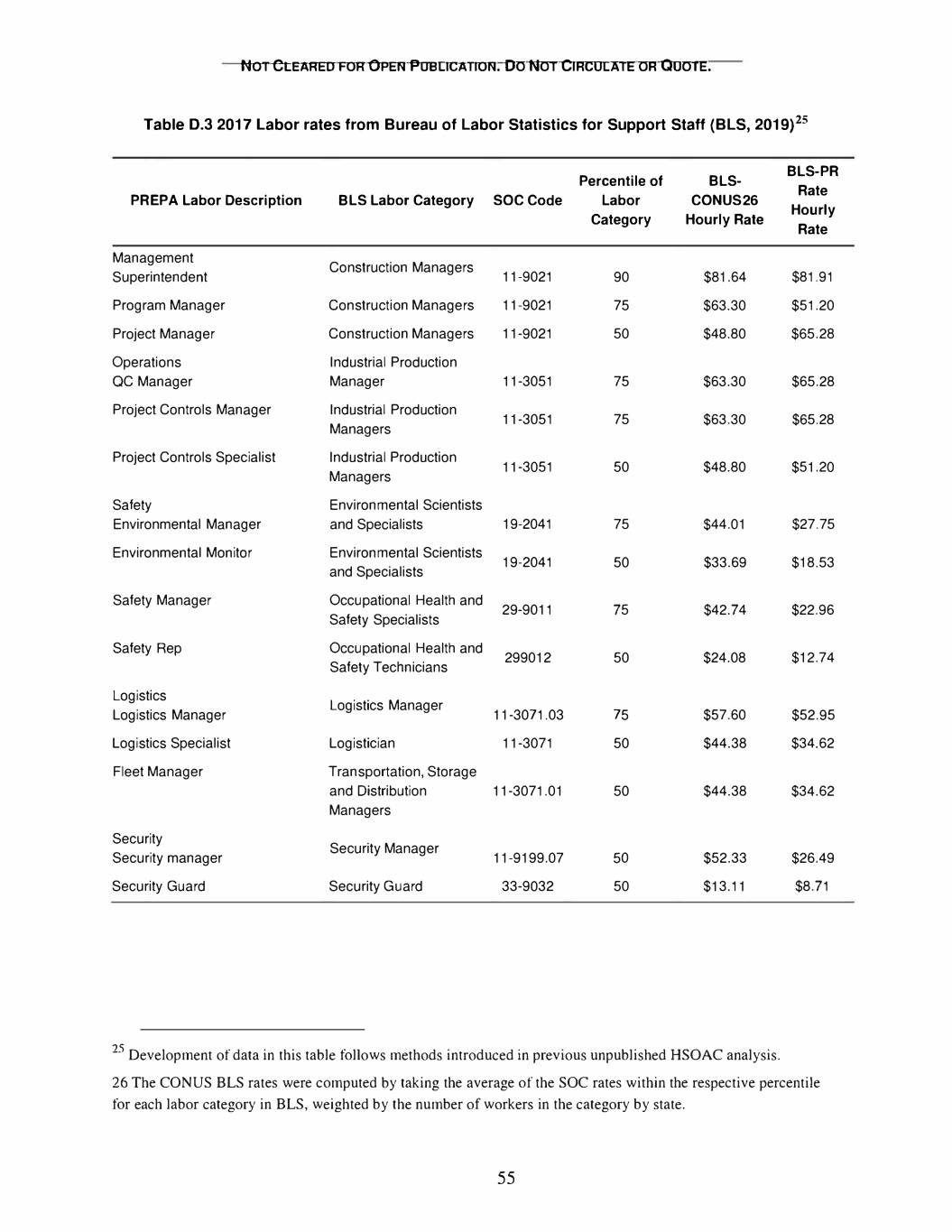
NOT CLEARED FOR OPEN POBLICAI ION. Do Nor CIRCULATE OR OUOTE. Table 0.3 2017 Labor rates from Bureau of Labor Statistics for Support Staff (BLS, 2019)25 BLS-PR Percentile of BLS- Rate PREPA Labor Description BLS Labor Category SOC Code Labor CONUS26 Hourly Category Hourly Rate Rate Management Construction Managers Superintendent 11-9021 90 $81.64 $81.91 Program Manager Construction Managers 11-9021 75 $63.30 $51.20 Project Manager Construction Managers 11-9021 50 $48.80 $65.28 Operations Industrial Production QC Manager Manager 11-3051 75 $63.30 $65.28 Project Controls Manager Industrial Production 11-3051 75 $63.30 $65.28 Managers Project Controls Specialist Industrial Production 11-3051 50 $48.80 $51.20 Managers Safety Environmental Scientists Environmental Manager and Specialists 19-2041 75 $44.01 $27.75 Environmental Monitor Environmental Scientists 19-2041 50 $33.69 $18.53 and Specialists Safety Manager Occupational Health and 29-9011 75 $42.74 $22.96 Safety Specialists Safety Rep Occupational Health and 299012 50 $24.08 $12.74 Safety Technicians Logistics Logistics Manager Logistics Manager 11-3071.03 75 $57.60 $52.95 Logistics Specialist Logistician 11-3071 50 $44.38 $34.62 Fleet Manager Transportation, Storage and Distribution 11-3071.01 50 $44.38 $34.62 Managers Security Security Manager Security manager 11-9199.07 50 $52.33 $26.49 Security Guard Security Guard 33-9032 50 $13.11 $8.71 25 Development of data in this table followsmethods introduced in previous unpublished HSOAC analysis. 26 The CO NUS BLS rates were computed by taking the average of the SOC rates within the respective percentile for each labor category in BLS, weighted by the number of workers in the category by state. 55

NoI CLEARED FOR OPEN PUBLICATION. Do NOT CIRCULATE OR QUOTE. Appendix E: Summary of Labor and Equipment Rate Ranges This appendix includes summary tables for labor and equipment rate benchmarks used to identify reasonable ranges, as adapted from previous unpublished HSOAC analysis. The BLS labor rates are often lower because they exclude fringebenefits while the RSMeans rates include these in their "bare cost" rates. Also, BLS compiles rates for all labor, both union and non-union, whereas standard union rates for RSMeans data benchmarks are to be used per FEMA guidance on the CEF. 27 Table E.1 2017 Hourly Labor Rate Ranges from BLS and RSMeans for Work Crews PREPA Labor Category Low Rate 28 High Rate29 Foreman $44.21 $58.70 Transmission Lineman $40.38 $58.20 Heavy Equipment Operator $21.33 $56.10 Winch Truck Operator $16.22 $53.75 Ground-man $34.15 $37.80 Diggers $17.33 $39.85 27 We reviewed the change of RSMeans rates over the 2017-2018 period for labor categories relevant to transmission construction. We note that costs published by RSMeans are national averages that can be adjusted by location factors. Gordian is cun-ently updating location factors for Puerto Rico. Updated location factors are expected to affect "bare cost" values for Puerto Rico, and thus labor rates and calculations that depend on them. Results presented in this report are based on best available information at this time. 28 BLS (2019) 29 Standard Union from RSMeans (2018) 56
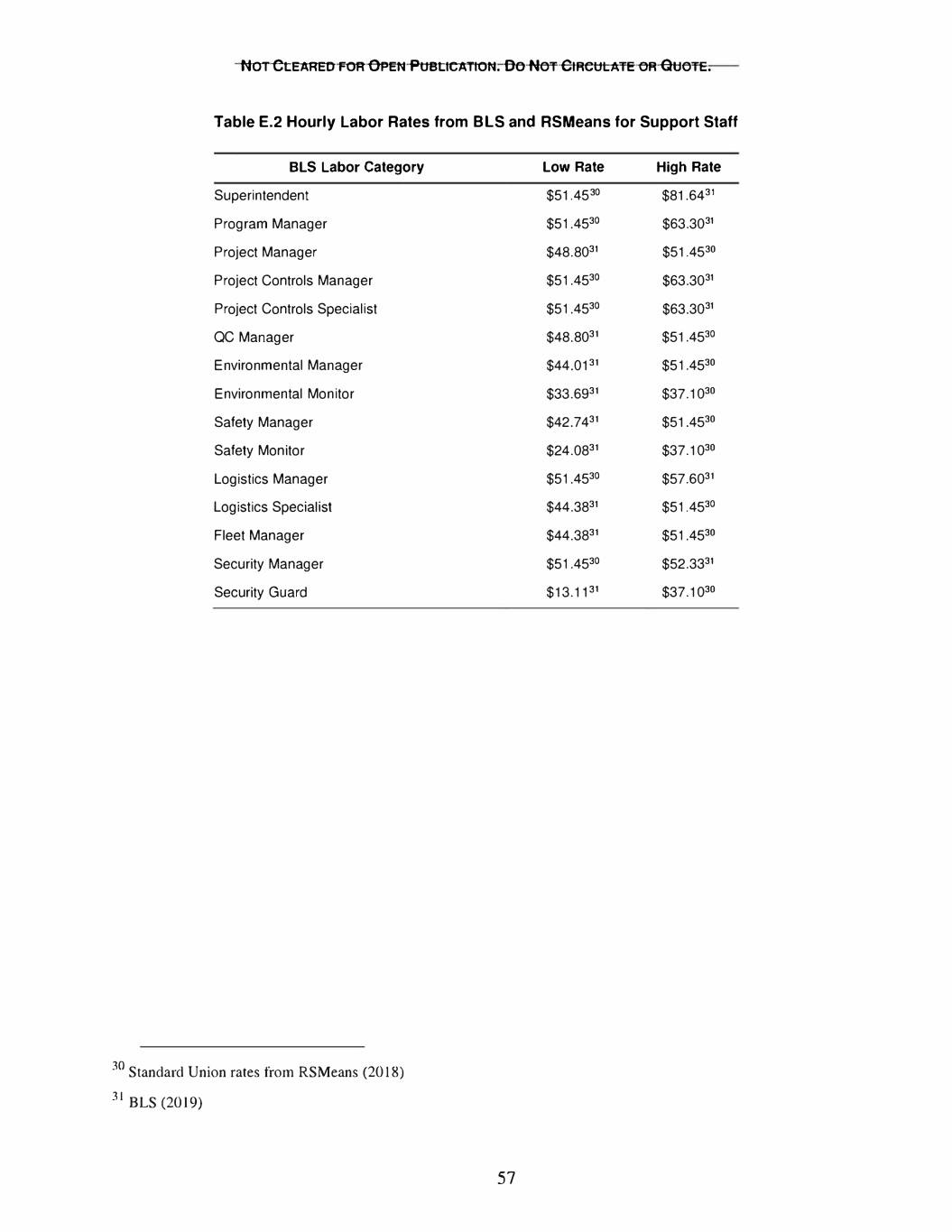
NOT CLEARED FOR OPEN PUBLICATION. Do NOT CIRCULATE OR QUOTE. Table E.2 Hourly Labor Rates from BLS and RSMeans for Support Staff BLS Labor Category Low Rate High Rate Superintendent $51.45 $81.64 30 31 Program Manager $51.45 $63.30 30 31 Project Manager $48.80 $51.45 31 30 Project Controls Manager $51.45 $63.30 30 31 Project Controls Specialist $51.45 $63.30 30 31 QC Manager $48.80 $51.45 31 30 Environmental Manager $44.01 $51.45 31 30 Environmental Monitor $33.69 $37.10 31 30 Safety Manager $42.74 $51.45 31 30 Safety Monitor $24.08 $37.10 31 30 Logistics Manager $51.45 $57.60 30 31 Logistics Specialist $44.38 $51.45 31 30 Fleet Manager $44.38 $51.45 31 30 Security Manager $51.45 $52.33 30 31 Security Guard $13.1 P $37.10 1 30 30 Standard Union rates from RSMeans (2018) 31 BLS (2019) 57
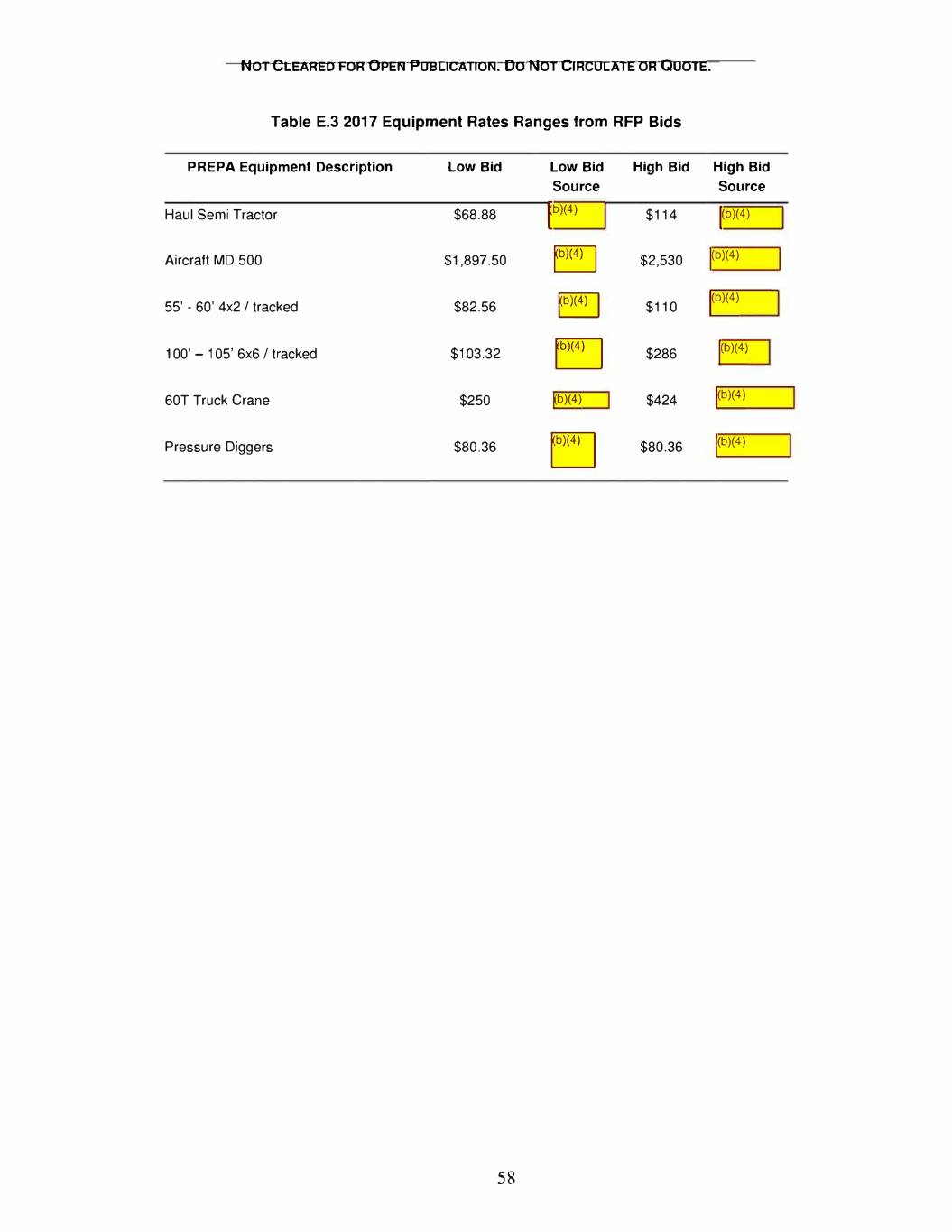
NOT CLEARED FOR OPEN POBLICAI ION. Do Nor CIRCULATE OR QUOTE. Table E.3 2017 Equipment Rates Ranges from RFP Bids PREPA Equipment Description Low Bid Low Bid High Bid High Bid Source Source Haul Semi Tractor $68.88 b)(4) $114 (b)(4) [ l Aircraft MD 500 $1,897.50 � $2,530 l(b)(4) (b)(4) 55' - 60' 4x2 / tracked $82.56 � $110 l 100' - 105' 6x6 / tracked $103.32 $286 (b)(4) � l 60T Truck Crane $250 $424 l(b)(4) Kb)(4) Pressure Diggers $80.36 E:J $80.36 l(b)(4) 58
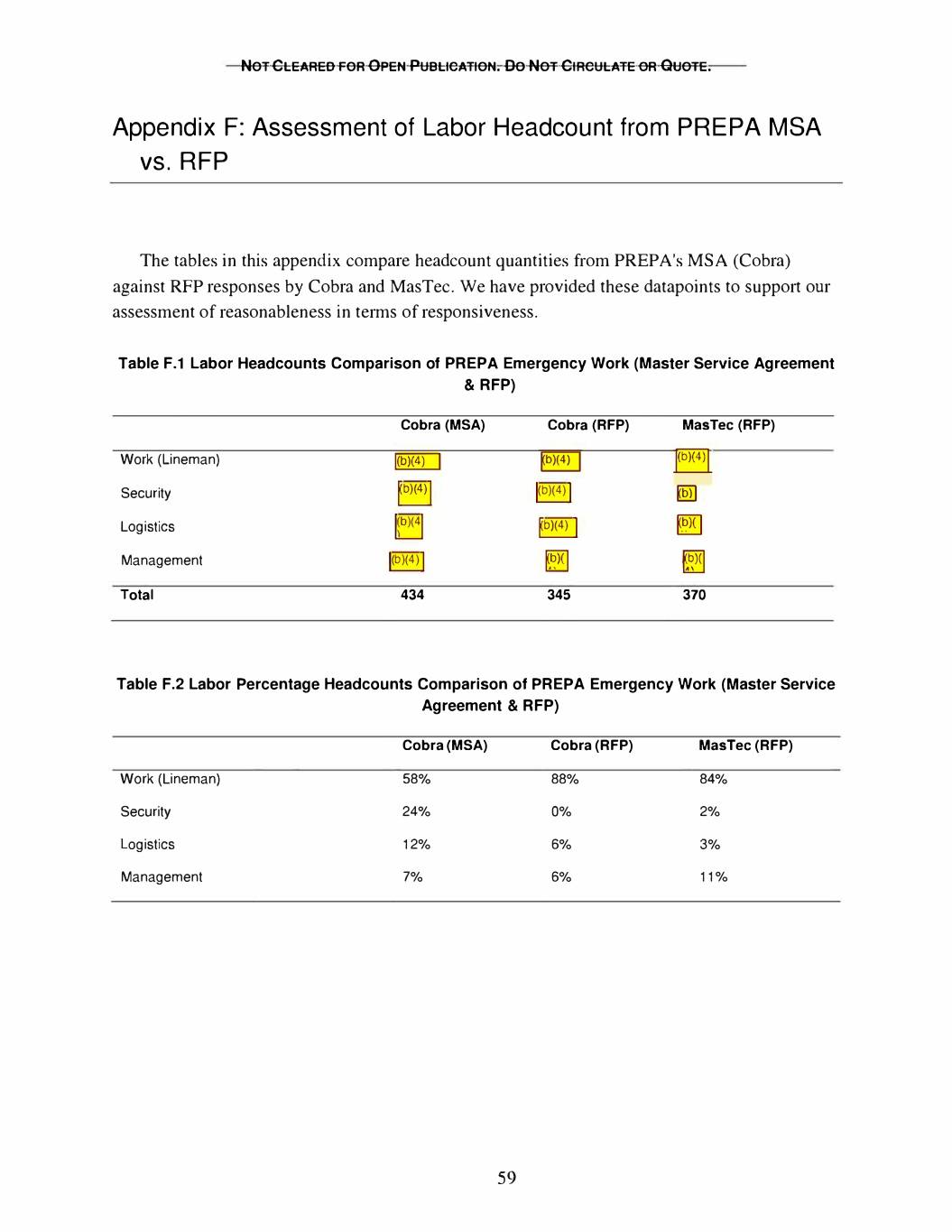
NOT CLEARED FOR OPEN PUBLICATION. 00 NOT CIRCULATE OR QUOTE. Appendix F: Assessment of Labor Headcount from PREPA MSA vs. RFP The tables in this appendix compare headcount quantities fromPREP A's MSA (Cobra) against RFP responses by Cobra and MasTec. We have provided these datapoints to support our assessment of reasonableness in terms of responsiveness. Table F.1 Labor Headcounts Comparison of PREPA Emergency Work (Master Service Agreement & RFP) Cobra (MSA) Cobra (RFP) MasTec (RFP) Work (Lineman) � � � Security rb)(4)i l(b)(4) I Kfill Logistics ) � l\b (41 fbl(4) I Management l I (b)(4) � � Total 434 345 370 Table F.2 Labor Percentage Headcounts Comparison of PREPA Emergency Work (Master Service Agreement & RFP) Cobra (MSA) Cobra (RFP) MasTec (RFP) Work (Lineman) 58% 88% 84% Security 24% 0% 2% Logistics 12% 6% 3% Management 7% 6% 11% 59

NOT CLEARED FOR OPEN PUBLICATION. 00 NOT CIRCULATE OFIQUOTE. Table F.3 Labor Only Extended Daily Billable Amounts32 comparison of PREPA emergency work (Master Service Agreement & RFP) Cobra (MSA) Cobra (RFP) MasTec (RFP) Work (Lineman) l(b)( ) (b)(4) (b)(4) 4 l l Security )(4) l( )(4) l( )(4) rb b I b Logistics l( )(4) (b)(4) Kb)(4) b I l I Management )( ) l(b)(4) (b)(4) fb 4 I l I Total $1,408,000 $1,171,267 $1,400,924 Table F.4 Percentage of Labor Only Extended Daily Billable Amounts Comparison of PREPA Emergency Work (Master Service Agreement & RFP) Cobra (MSA) Cobra (RFP) MasTec (RFP) Work (Lineman) 71% 91% 90% Security 15% 0.1% 1% Logistics 9% 2% 2% Management 5% 7% 6% 32 Extended Daily Billable rate is the daily billable rate for a labor type (Lineman, Security, Logistics, Management) multiplied by the headcount for that labor type. We excluded lodging cost in the calculations to focus on labor comparisons only. 60
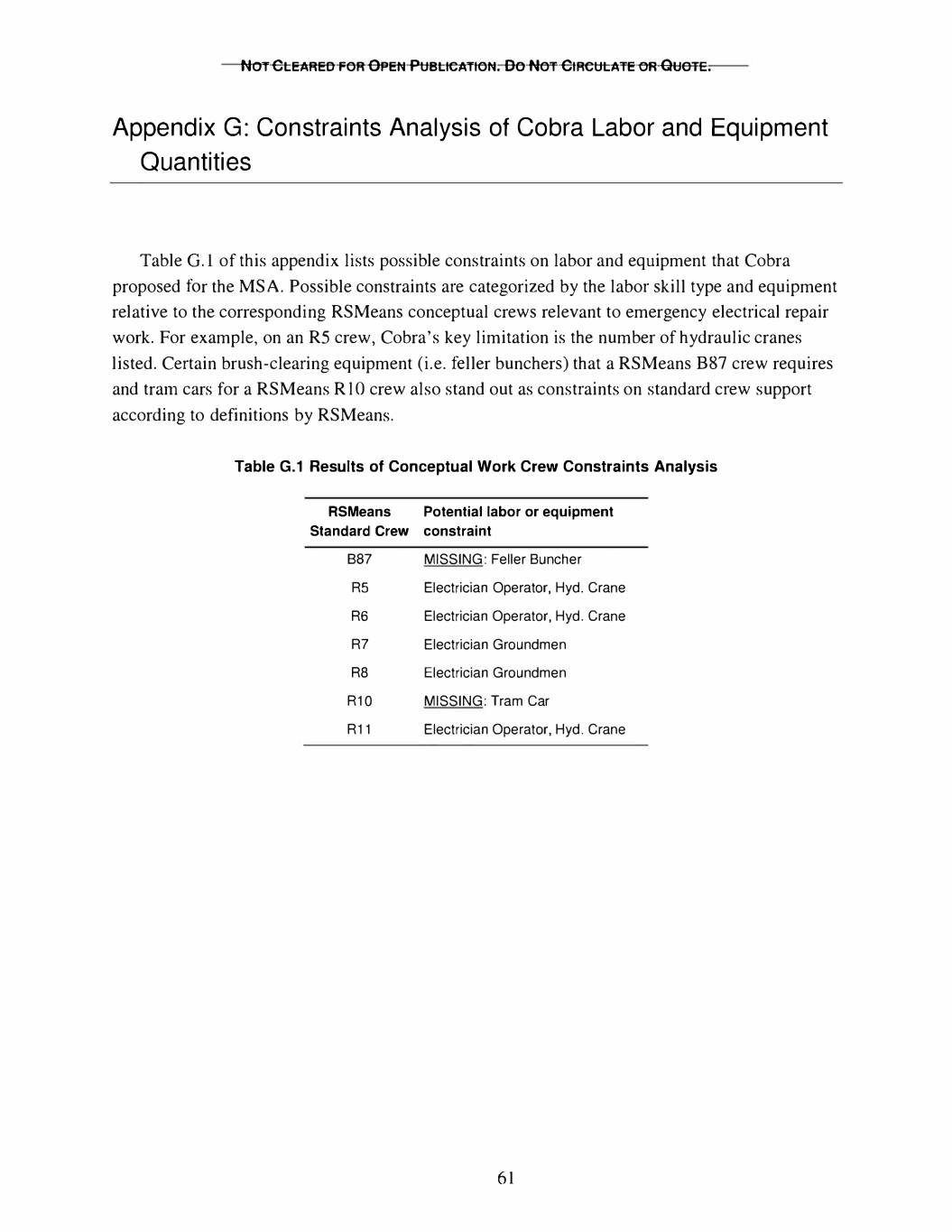
NOT CLEARED FOR OPEN PUBLICATION. 00 NOT CIRCULATE OR QUOTE. Appendix G: Constraints Analysis of Cobra Labor and Equipment Quantities Table G.1 of this appendix lists possible constraints on labor and equipment that Cobra proposed forthe MSA. Possible constraints are categorized by the labor skill type and equipment relative to the corresponding RSMeans conceptual crews relevant to emergency electrical repair work. For example, on an RS crew, Cobra's key limitation is the number of hydraulic cranes listed. Certain brush-clearing equipment (i.e. fellerbunchers) that a RSMeans B87 crew requires and tram cars for a RSMeans RlO crew also stand out as constraints on standard crew support according to definitions by RSMeans. Table G.1 Results of Conceptual Work Crew Constraints Analysis RSMeans Potential labor or equipment Standard Crew constraint 887 MISSING: Feller Buncher R5 Electrician Operator, Hyd. Crane R6 Electrician Operator, Hyd. Crane R7 Electrician Groundmen RB Electrician Groundmen R10 MISSING: Tram Car R11 Electrician Operator, Hyd. Crane 61

NOT CLEARED FOR OPEN PUBLICATION. 00 NOT CIRCULATE 0FI QUOTE. Appendix H: Results of One-Way Sensitivity Analysis of Cobra's Labor and Equipment Roster This appendix summarizes results of a one-way sensitivity analysis of blended rates estimated on a "roster" basis (i.e. a complete list of work crew labor and equipment offered by Cobra on the MSA.). Table H.1 shows the percentage change on the blended rate estimate after adding one unit of labor to each labor category. Table H.2 shows the percentage change on the blended rate estimate after adding one unit of equipment to each equipment category. Results suggest that blended rates are relatively insensitive to changes to the labor mix as well as changes in equipment quantities except for helicopters. A one-unit change in the number of helicopters affects the blended rate estimate by roughly an order of magnitude. The implication is that a representative blended rate, and therefore, a range of such rates produced for comparison to Cobra's billable rate, may need to consider variation in expensive equipment and the work that requires it. Table H.1 Percent Change of Blended Rate with One Additional Unit of Labor PREPA Labor Category Percent change General Foreman -0.22% Foreman -0.23% Lineman -0.23% Heavy Equipment Operator -0.25% Ground man -0.31% Apprentice -0.29% Diggers (Common Labor) -0.33% 62
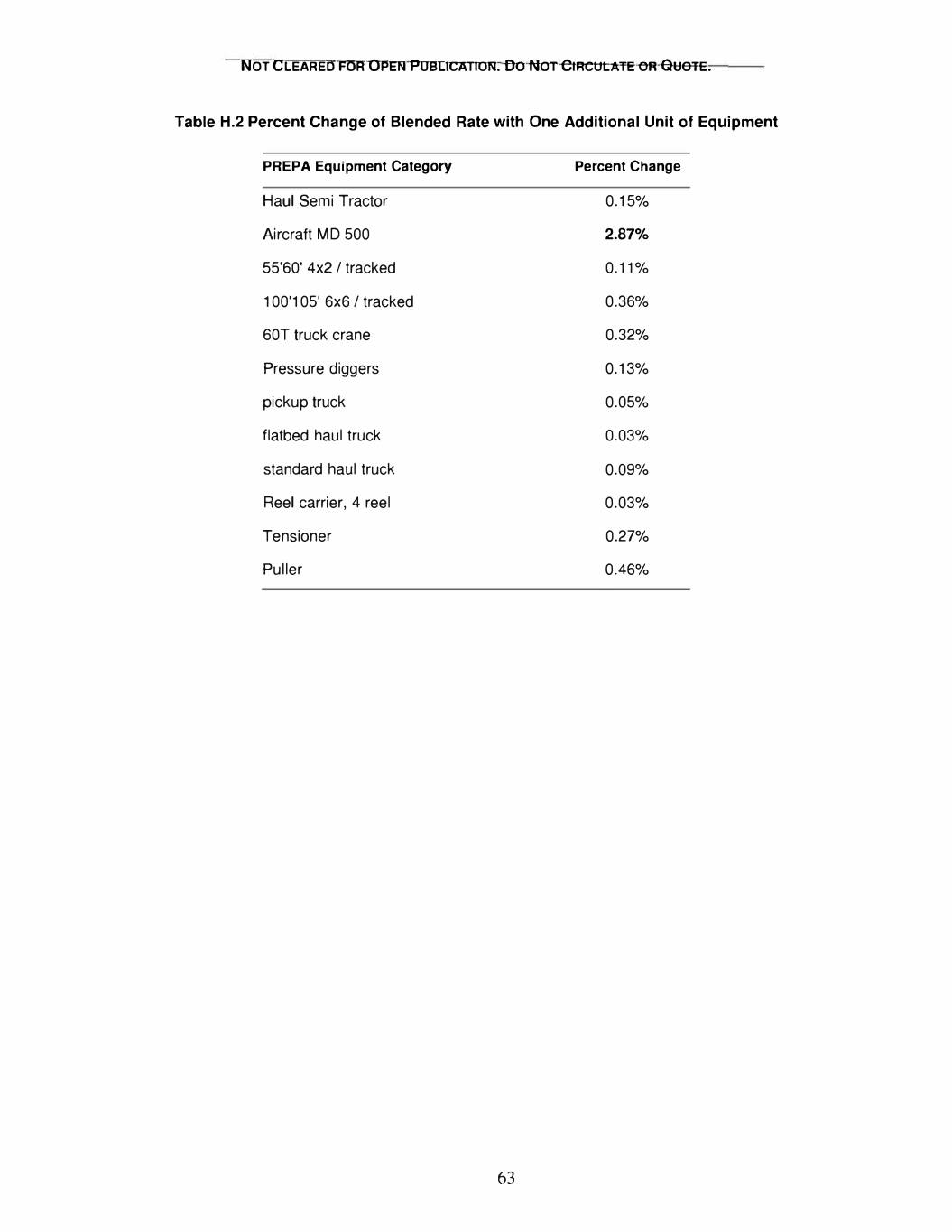
NOT CLEARED FOR OPEN PUBLICAI ION. Do NOT CIRCULATE OR QUOTE. Table H.2 Percent Change of Blended Rate with One Additional Unit of Equipment PREPA Equipment Category Percent Change Haul Semi Tractor 0.15% Aircraft MD 500 2.87% 55'60' 4x2 / tracked 0.11% 100'1 05' 6x6 / tracked 0.36% 60T truck crane 0.32% Pressure diggers 0.13% pickup truck 0.05% flatbed haul truck 0.03% standard haul truck 0.09% Reel carrier, 4 reel 0.03% Tensioner 0.27% Puller 0.46% 63
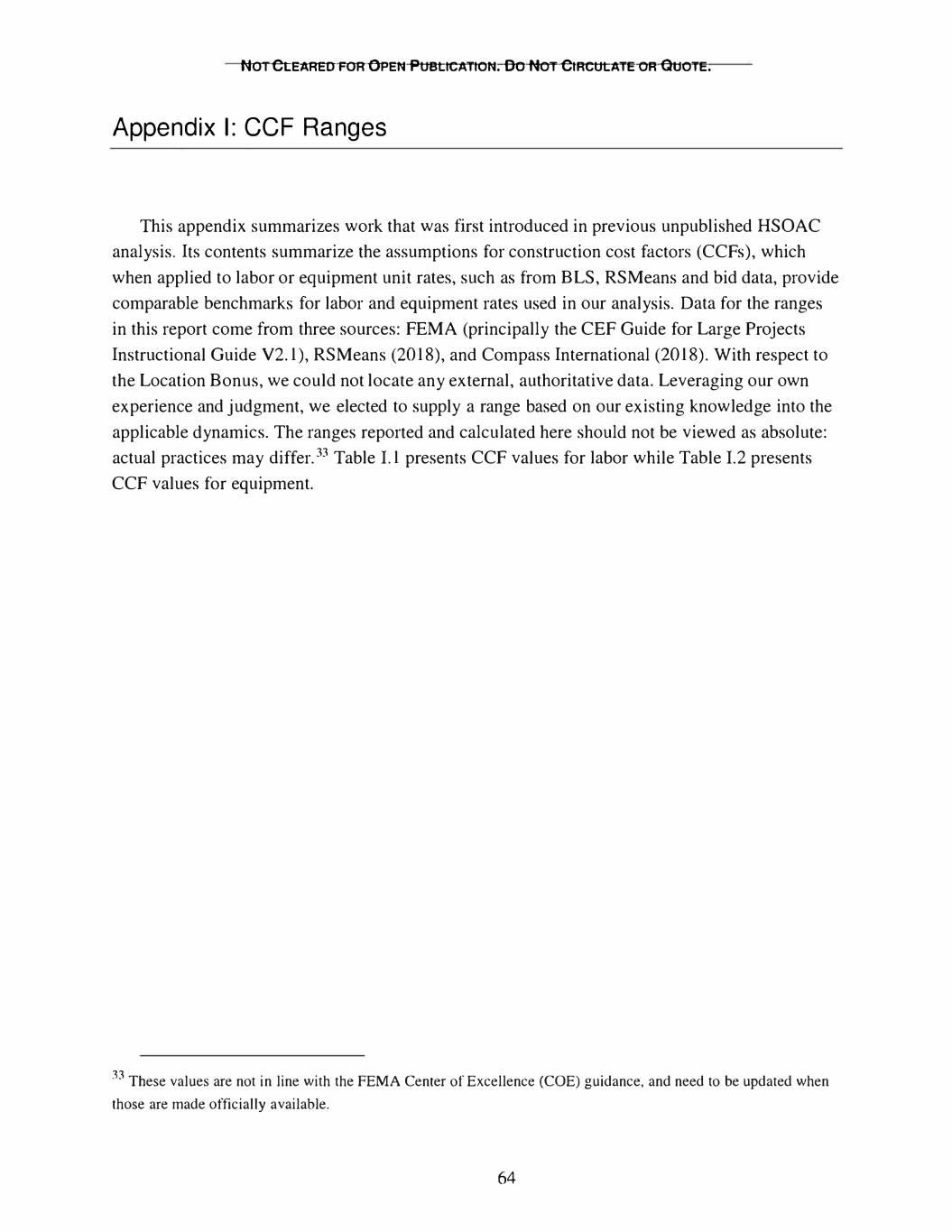
NOT CLEARED FOR OPEN PUBLICATION. Do NOT CIRCULATE OR QUOTE. Appendix I: CCF Ranges This appendix summarizes work that was firstintroduced in previous unpublished HSOAC analysis. Its contents summarize the assumptions for construction cost factors (CCFs), which when applied to labor or equipment unit rates, such as from BLS, RSMeans and bid data, provide comparable benchmarks for labor and equipment rates used in our analysis. Data for the ranges in this report come from three sources: FEMA (principally the CEF Guide for Large Projects Instructional Guide V2.1), RSMeans (2018), and Compass International (2018). With respect to the Location Bonus, we could not locate any external, authoritative data. Leveraging our own experience and judgment, we elected to supply a range based on our existing knowledge into the applicable dynamics. The ranges reported and calculated here should not be viewed as absolute: 33 actual practices may differ. Table 1.1 presents CCF values for labor while Table 1.2 presents CCF values for equipment. 33 These values are not in line with the FEMA Center of Excellence (COE) guidance, and need to be updated when those are made officially available. 64
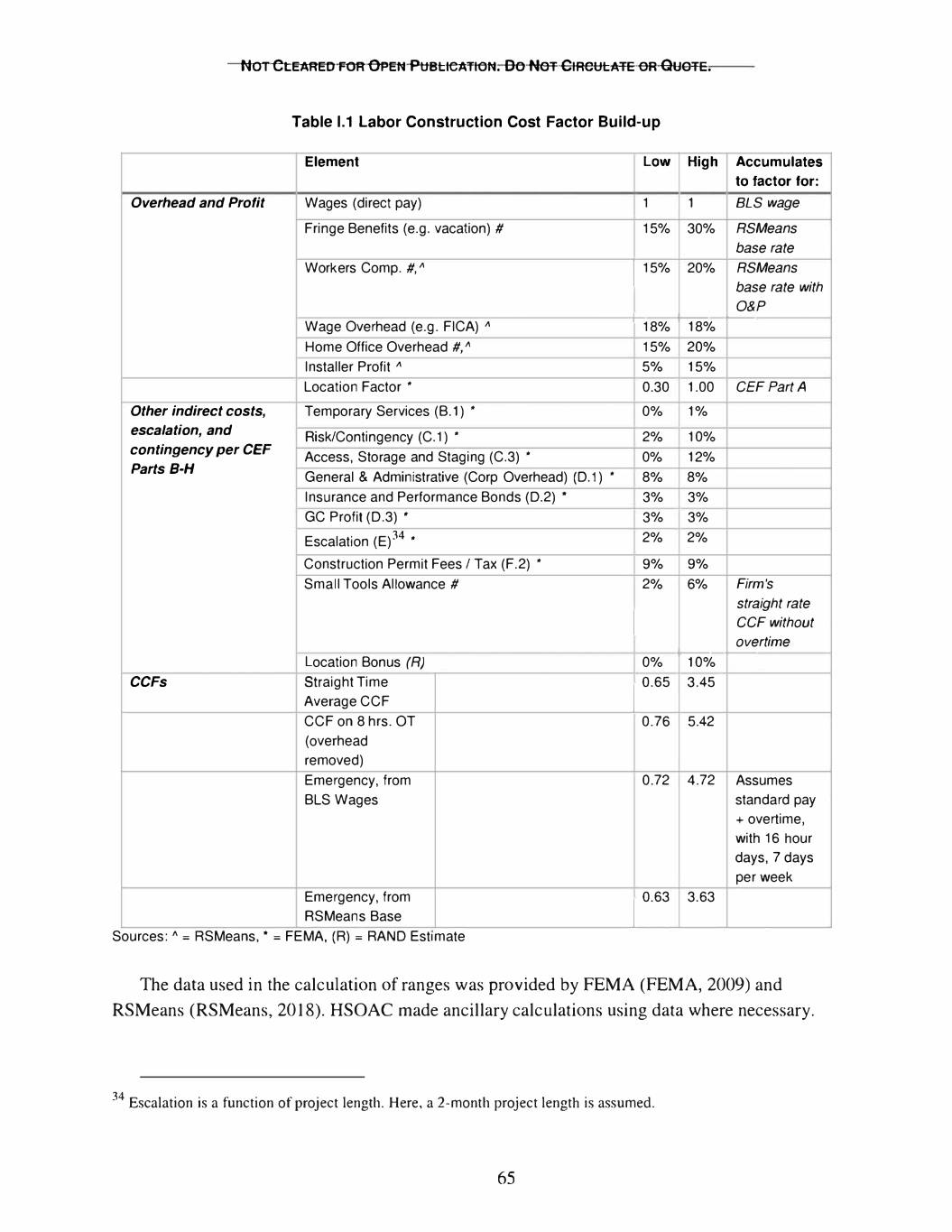
NOT CtEAFIEDF0FI OPEN PUBLICATION. 00 NOT CIRCULATE OR QUOTE. Table 1.1 Labor Construction Cost Factor Build-up Element Low High Accumulates to factor for: Overhead and Profit Wages (direct pay) 1 1 BLSwage Fringe Benefits (e.g. vacation) # 15% 30% RSMeans base rate #," RSMeans Work ers Comp. 115% 20% base rate with O&P "" ----- ,....__ Wage Overhead (e.g. FICA) " 18% 18% Home Office Overhead #," 15% 20% Installer Profit " 5% 15% Location Factor • 0.30 1.00 CEF Part A Other indirect costs, Temporary Services (B.1) • 0% 1% escalation, and Risk/Contingency (C.1) • 2% 10% contingency per CEF Parts B-H Access, Storage and Staging (C.3) • 0% 12% General & Administrative (Corp Overhead) (D.1) • 8% 8% Insurance and Performance Bonds (D.2) • 3% 3% GC Profit (D.3) * 3% 3% 34 Escalation (E) • 2% 2% Construction Permit Fees/ Tax (F.2) • 9% 9% Small Tools Allowance # 2% 6% Firm's straight rate I CCFwithout overtime ,....__. ----- Location Bonus (R) 0% 10% CCFs &raight Time o.65 3.45 Average CCF I CCF on 8 hrs. OT 0.76 5.42 (overhead removed) Emergency, from 0.72 4.72 Assumes BLS Wages standard pay + overtime, with 16 hour days, 7 days per week Emergency, from o.63 3.63 RSMeans Base I Sources: � = RSMeans, • = FEMA, (R) = RAND Estimate The data used in the calculation of ranges was provided by FEMA (FEMA, 2009) and RSMeans (RSMeans, 2018). HSOAC made ancillary calculations using data where necessary. 34 Escalation is a function of project length. Here, a 2-month project length is assumed. 65
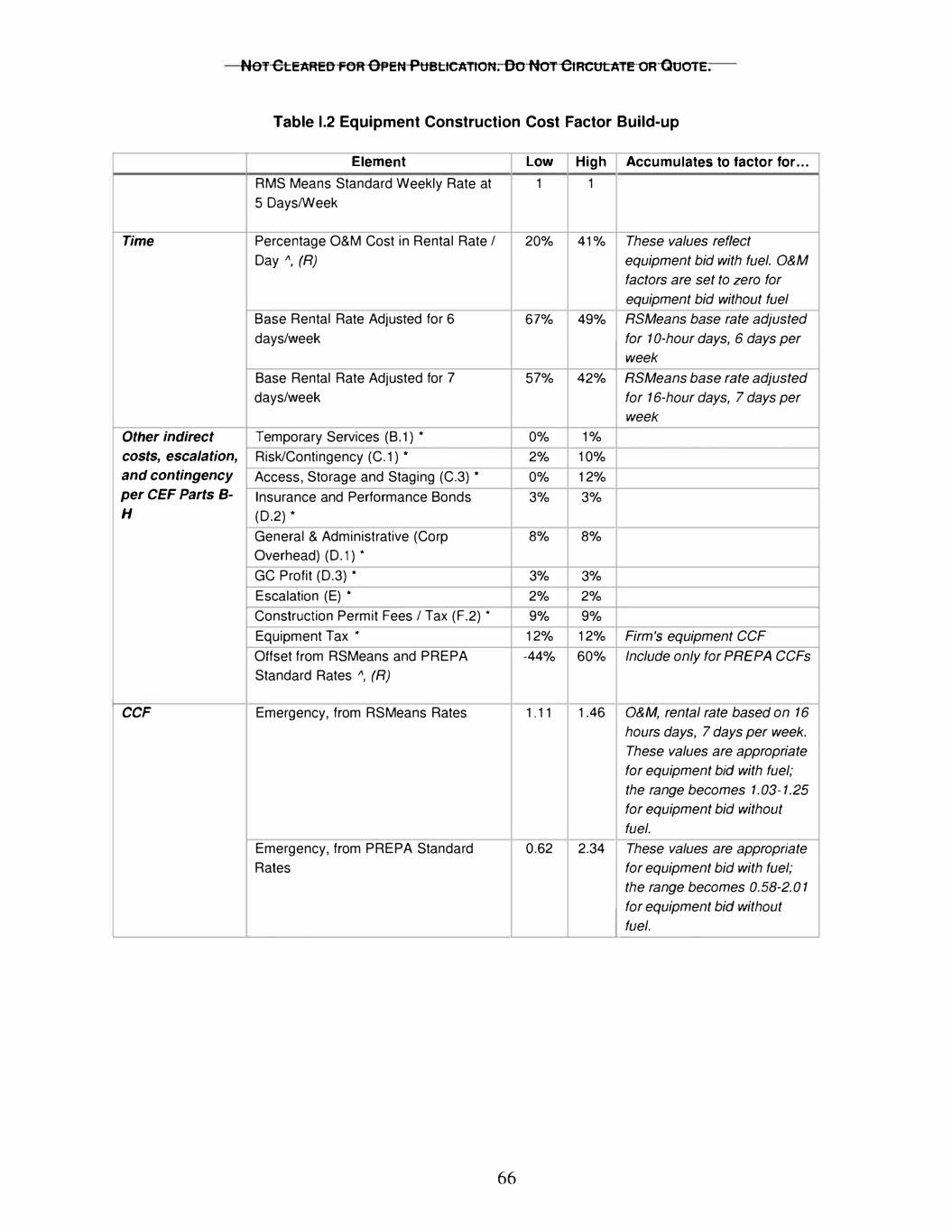
NOT CLEARED FOR OPEN PUBLICATION. Do NOT CIRCULATE OR QUOTE. Table 1.2 Equipment Construction Cost Factor Build-up Element Low High Accumulates to factor for ... RMS Means Standard Weekly Rate at 1 1 5 Days/Week Time Percentage O&M Cost in Rental Rate I 20% 41% These values reflect Day A, (R) equipment bid with fuel. O&M factors are set to zero for equipment bid without fuel Base Rental Rate Adjusted for 6 67% 49% RSMeans base rate adjusted days/week for 10-hour days, 6 days per I week Base Rental Rate Adjusted for 7 57% 42% RSMeans base rate adjusted days/week for 16-hour days, 7 days per week Other indirect Temporary Services (B.1) • 0% 1% costs, escalation, Risk/Contingency (C.1) • 2% 10% and contingency Access, Storage and Staging (C.3) • 0% 12% per CEF Parts B- Insurance and Performance Bonds 3% 3% H (D.2) * General & Administrative (Corp 8% 8% Overhead) (D.1) • GC Profit (D.3) * 3% 3% Escalation (E) * 2% 2% Construction Permit Fees / Tax (F.2) • 9% 9% Equipment Tax • 12% 12% Firm's equipment CCF Offset from RSMeans and PREPA -44% 60% Include only for PREPA CCFs Standard Rates A, (R) ..__ CCF Emergency, from RSMeans Rates 1 .11 1.46 O&M, rental rate based on 16 hours days, 7 days per week. These values are appropriate for equipment bid with fuel; the range becomes 1.03-1.25 for equipment bid without fuel. Emergency, from PREPA Standard 0.62 2.34 These values are appropriate Rates for equipment bid with fuel; the range becomes 0.58-2.01 for equipment bid without fuel. 1 66
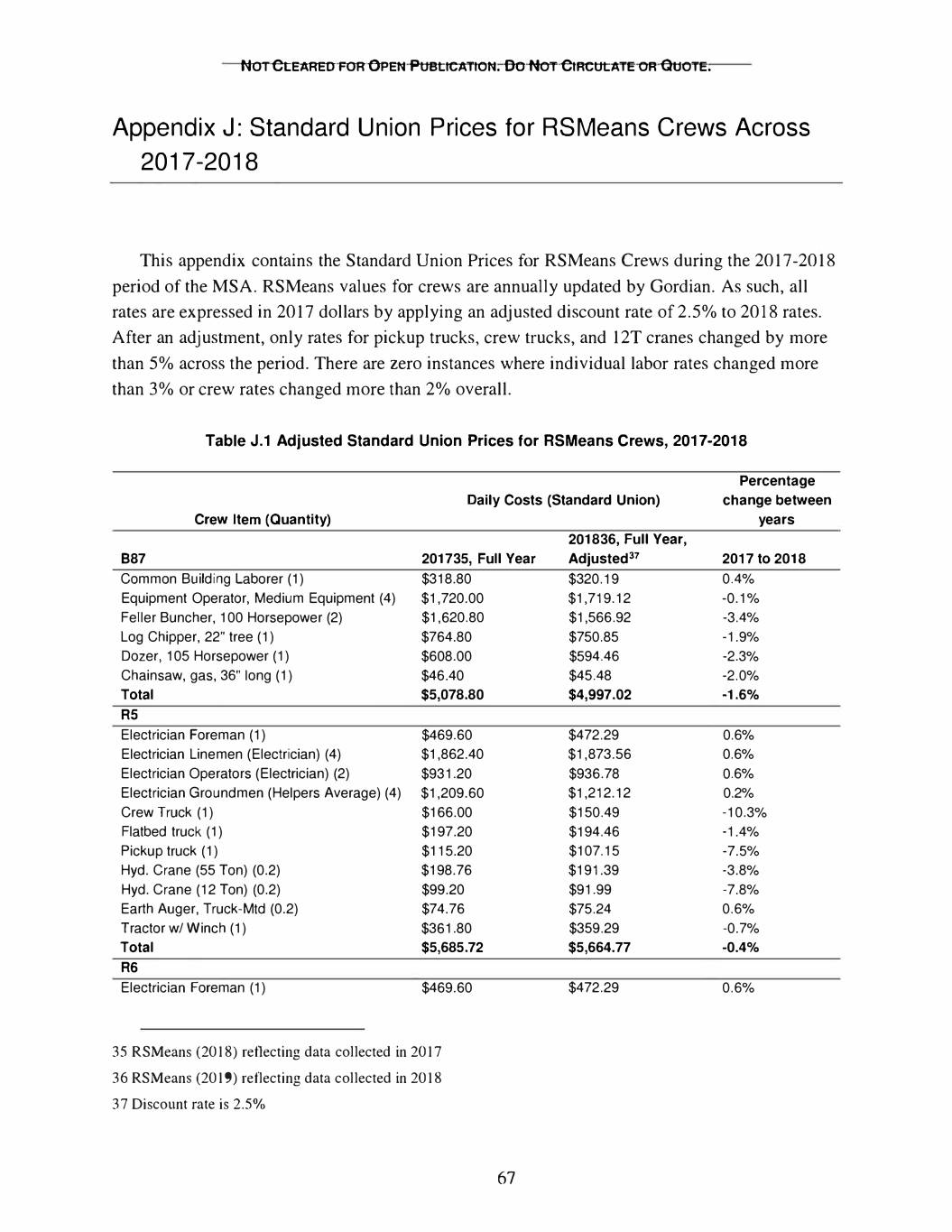
NOT CLEARED FOR OPEN PUBLICATION. Do NOT CIRCULATE OR QUOTE. Appendix J: Standard Union Prices for RSMeans Crews Across 2017-2018 This appendix contains the Standard Union Prices for RSMeans Crews during the 2017-2018 period of the MSA. RSMeans values for crews are annually updated by Gordian. As such, all rates are expressed in 2017 dollars by applying an adjusted discount rate of 2.5% to 2018 rates. After an adjustment, only rates for pickup trucks, crew h·ucks, and 12T cranes changed by more than 5% across the period. There are zero instances where individual labor rates changed more than 3% or crew rates changed more than 2% overall. Table J.1 Adjusted Standard Union Prices for RSMeans Crews, 2017-2018 Percentage Daily Costs (Standard Union) change between Crew Item (Quantity) years 201836, Full Year, B87 201735, Full Year Adjusted37 2017 to 2018 Common Building Laborer (1) $318.80 $320.19 0.4% Equipment Operator, Medium Equipment (4) $1,720.00 $1,719.12 -0.1% Feller Buncher, 100 Horsepower (2) $1,620.80 $1,566.92 -3.4% Log Chipper, 22" tree (1) $764.80 $750.85 -1.9% Dozer, 105 Horsepower (1) $608.00 $594.46 -2.3% Chainsaw, gas, 36" long (1) $46.40 $45.48 -2.0% Total $5,078.80 $4,997.02 -1.6% RS Electrician Foreman (1) $469.60 $472.29 0.6% Electrician Linemen (Electrician) (4) $1,862.40 $1,873.56 0.6% Electrician Operators (Electrician) (2) $931.20 $936.78 0.6% Electrician Groundmen (Helpers Average) (4) $1,209.60 $1,212.12 0.2% Crew Truck (1) $166.00 $150.49 -10.3% Flatbed truck (1 ) $197.20 $194.46 -1.4% Pickup truck ( 1) $115.20 $107.15 -7.5% Hyd. Crane (55 Ton) (0.2) $198.76 $191.39 -3.8% Hyd. Crane (12 Ton) (0.2) $99.20 $91.99 -7.8% Earth Auger, Truck-Mid (0.2) $74.76 $75.24 0.6% Tractor w/ Winch (1) $361.80 $359.29 -0.7% Total $5,685.72 $5,664.77 -0.4% R6 Electrician Foreman (1) $469.60 $472.29 0.6% 35 RSMeans (2018) reflecting data collected in 2017 36 RSMeans (2019) reflecting data collected in 2018 37 Discount rate is 2.5% 67
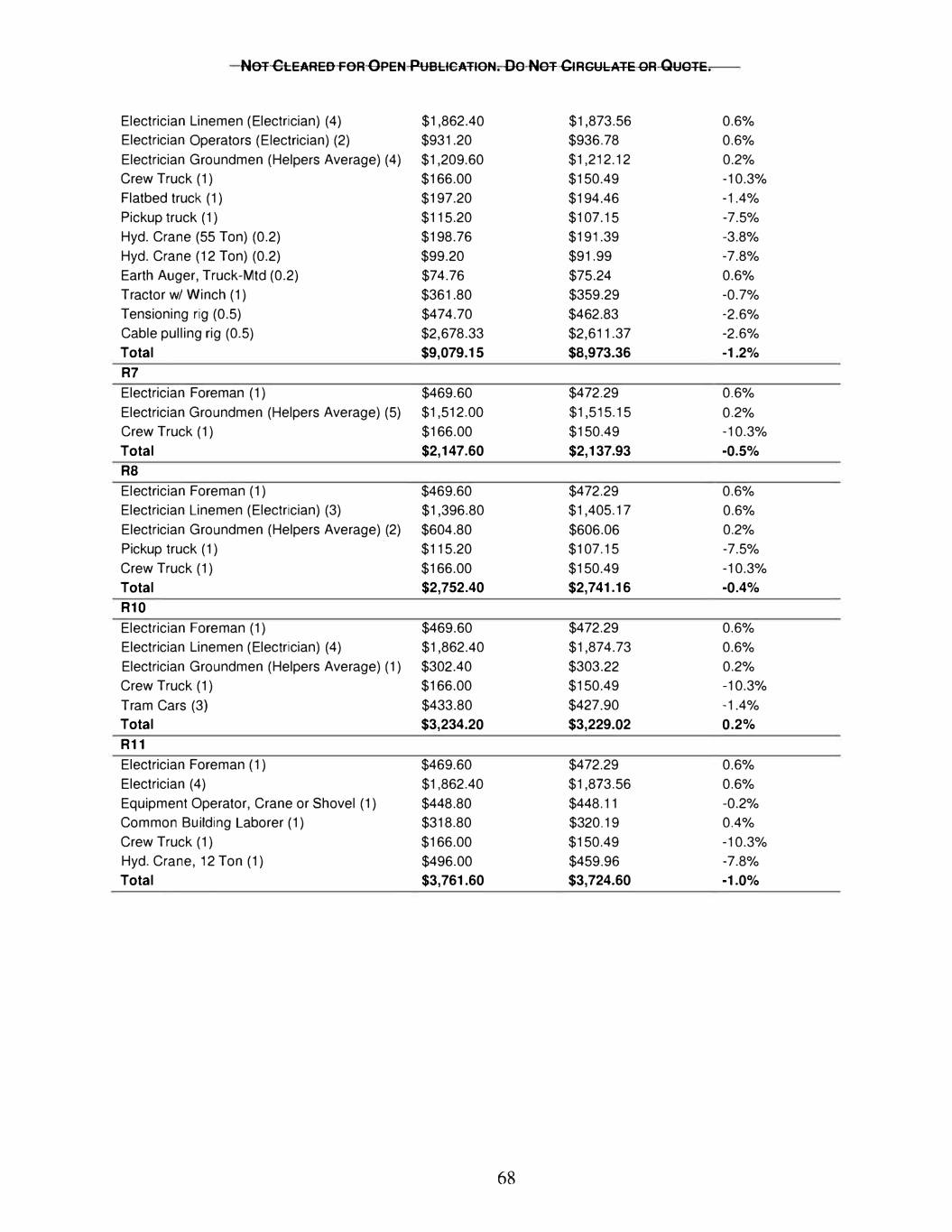
NOT CLEARED FOR OPEN PUBLICATION. Do NOT CIRCULATE OR QUOTE. Electrician Linemen (Electrician) (4) $1,862.40 $1,873.56 0.6% Electrician Operators (Electrician) (2) $931.20 $936.78 0.6% Electrician Groundmen (Helpers Average) (4) $1,209.60 $1,212.12 0.2% Crew Truck (1) $166.00 $150.49 -10.3% Flatbed truck (1 ) $197.20 $194.46 -1.4% Pickup truck (1) $115.20 $107.15 -7.5% Hyd. Crane (55 Ton) (0.2) $198.76 $191.39 -3.8% Hyd. Crane (12 Ton) (0.2) $99.20 $91.99 -7.8% Earth Auger, Truck-Mtd (0.2) $74.76 $75.24 0.6% Tractor w/ Winch (1) $361.80 $359.29 -0.7% Tensioning rig (0.5) $474.70 $462.83 -2.6% Cable pulling rig (0.5) $2,678.33 $2,611.37 -2.6% Total $9,079.15 $8,973.36 -1.2% R7 Electrician Foreman (1) $469.60 $472.29 0.6% Electrician Groundmen (Helpers Average) (5) $1,512.00 $1,515.15 0.2% Crew Truck (1) $166.00 $150.49 -10.3% Total $2,147.60 $2,137.93 -0.5% RS Electrician Foreman (1) $469.60 $472.29 0.6% Electrician Linemen (Electrician) (3) $1,396.80 $1,405.17 0.6% Electrician Groundmen (Helpers Average) (2) $604.80 $606.06 0.2% Pickup truck (1) $115.20 $107.15 -7.5% Crew Truck (1) $166.00 $150.49 -10.3% Total $2,752.40 $2,741.16 -0.4% R10 Electrician Foreman (1) $469.60 $472.29 0.6% Electrician Linemen (Electrician) (4) $1,862.40 $1,874.73 0.6% Electrician Groundmen (Helpers Average) (1) $302.40 $303.22 0.2% Crew Truck (1) $166.00 $150.49 -10.3% Tram Cars (3) $433.80 $427.90 -1.4% Total $3,234.20 $3,229.02 0.2% R11 Electrician Foreman (1) $469.60 $472.29 0.6% Electrician (4) $1,862.40 $1,873.56 0.6% Equipment Operator, Crane or Shovel (1) $448.80 $448.11 -0.2% Common Building Laborer (1) $318.80 $320.19 0.4% Crew Truck (1) $166.00 $150.49 -10.3% Hyd. Crane, 12 Ton (1) $496.00 $459.96 -7.8% Total $3,761.60 $3,724.60 -1.0% 68
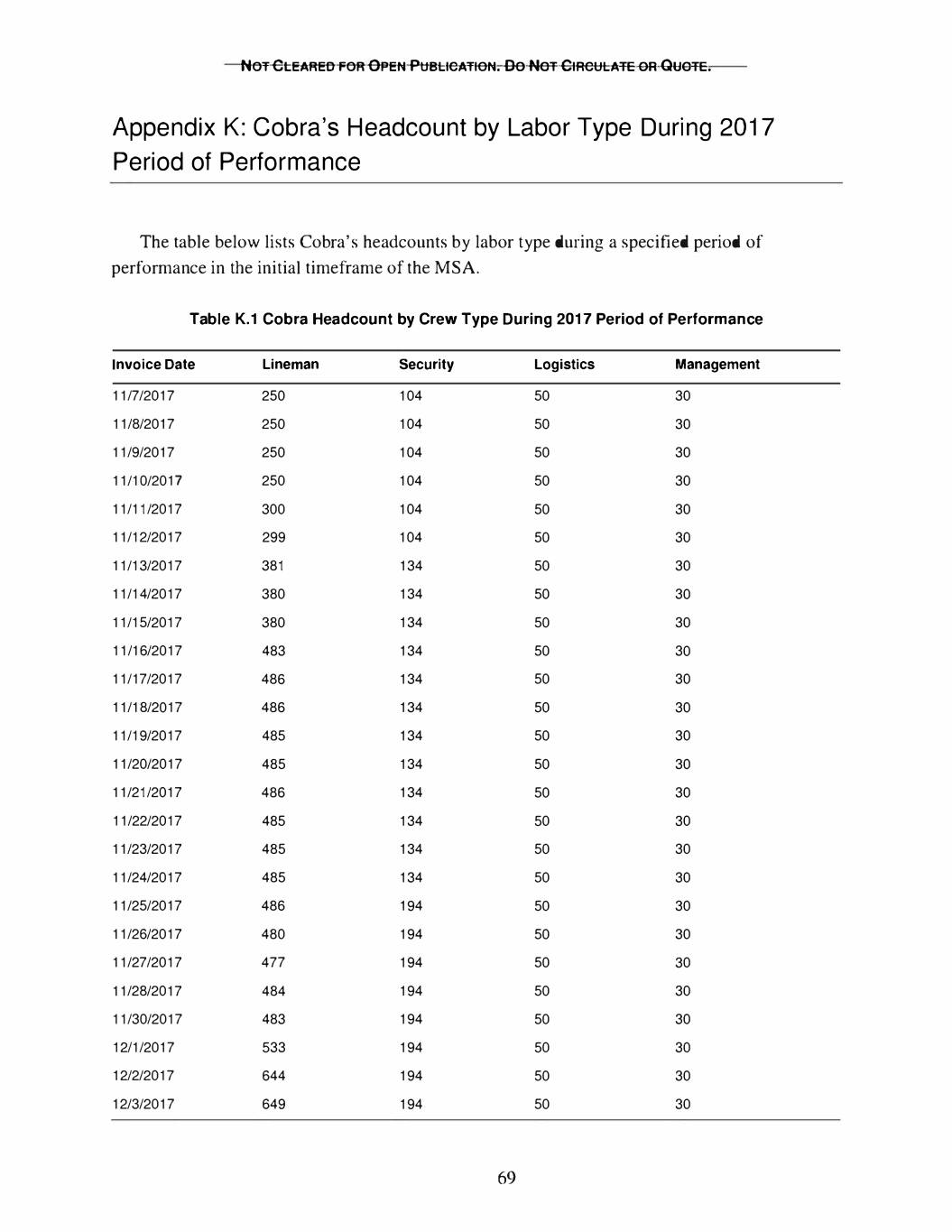
NOT CLEARED FOR OPEN PUBLICATION. 00 NOT CIRCULATE OR QUOTE. Appendix K: Cobra's Headcount by Labor Type During 2017 Period of Performance The table below lists Cobra's headcounts by labor type during a specifiedperiod of performance in the initial timeframe of the MSA. Table K.1 Cobra Headcount by Crew Type During 2017 Period of Performance Invoice Date Lineman Security Logistics Management 11/7/2017 250 104 50 30 11/8/2017 250 104 50 30 11/9/2017 250 104 50 30 11/10/2017 250 104 50 30 11/11/2017 300 104 50 30 11/12/2017 299 104 50 30 11/13/2017 381 134 50 30 11/14/2017 380 134 50 30 11/15/2017 380 134 50 30 11/16/2017 483 134 50 30 11/17/2017 486 134 50 30 11/18/2017 486 134 50 30 11/19/2017 485 134 50 30 11/20/2017 485 134 50 30 11/21/2017 486 134 50 30 11/22/2017 485 134 50 30 11/23/2017 485 134 50 30 11/24/2017 485 134 50 30 11/25/2017 486 194 50 30 11/26/2017 480 194 50 30 11/27/2017 477 194 50 30 11/28/2017 484 194 50 30 11/30/2017 483 194 50 30 12/1/2017 533 194 50 30 12/2/2017 644 194 50 30 12/3/2017 649 194 50 30 69
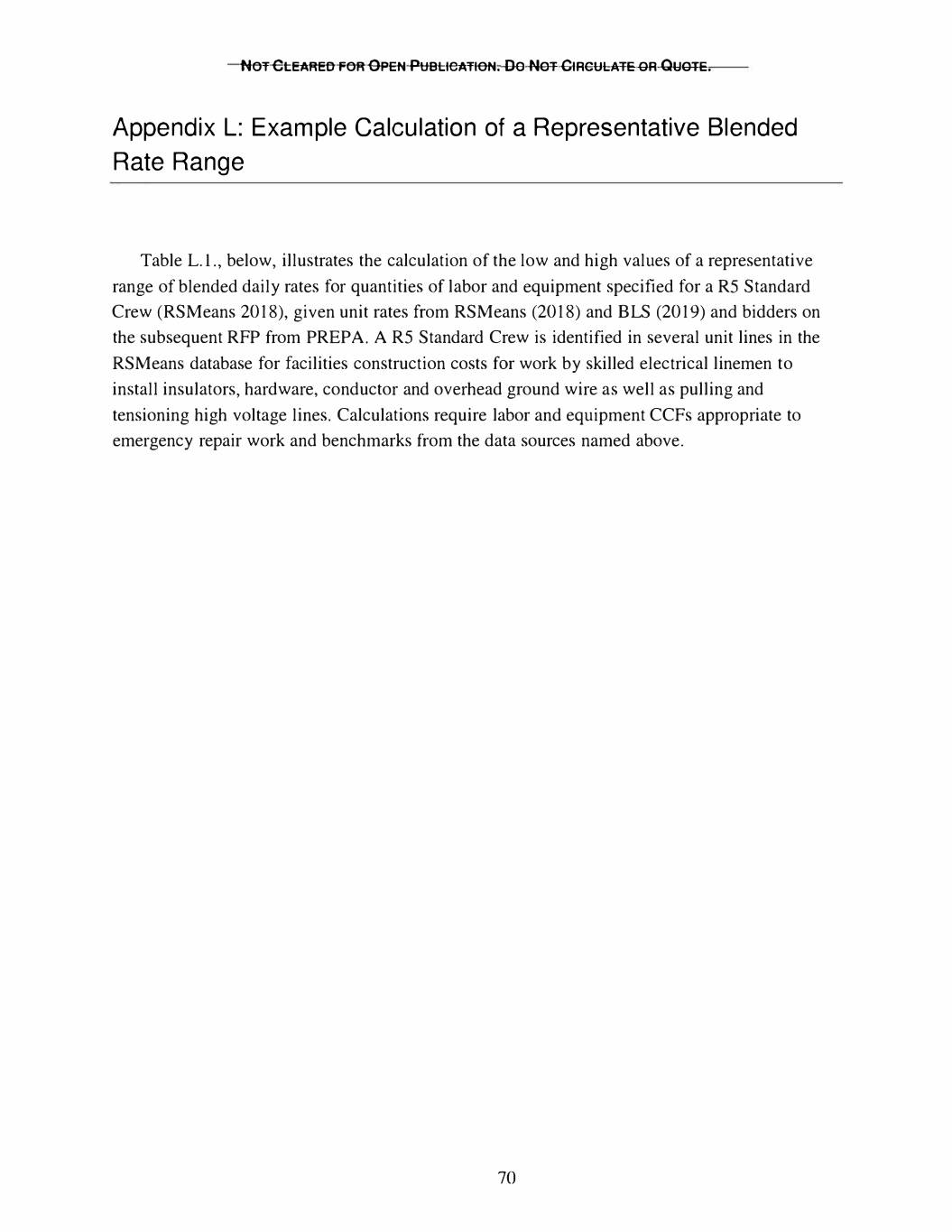
NOT CLEARED FOR OPEN PUBLICATION. Do NOT CIRCULATE OR Oll0TE. Appendix L: Example Calculation of a Representative Blended Rate Range Table L. l ., below, illustrates the calculation of the low and high values of a representative range of blended daily rates for quantities of labor and equipment specified for a RS Standard Crew (RSMeans 2018), given unit rates fromRSMeans (2018) and BLS (2019) and bidders on the subsequent RFP from PREP A. A RS Standard Crew is identified in several unit lines in the RSMeans database for facilities construction costs for work by skilled electrical linemen to install insulators, hardware, conductor and overhead ground wire as well as pulling and tensioning high voltage lines. Calculations require labor and equipment CCFs appropriate to emergency repair work and benchmarks from the data sources named above. 70
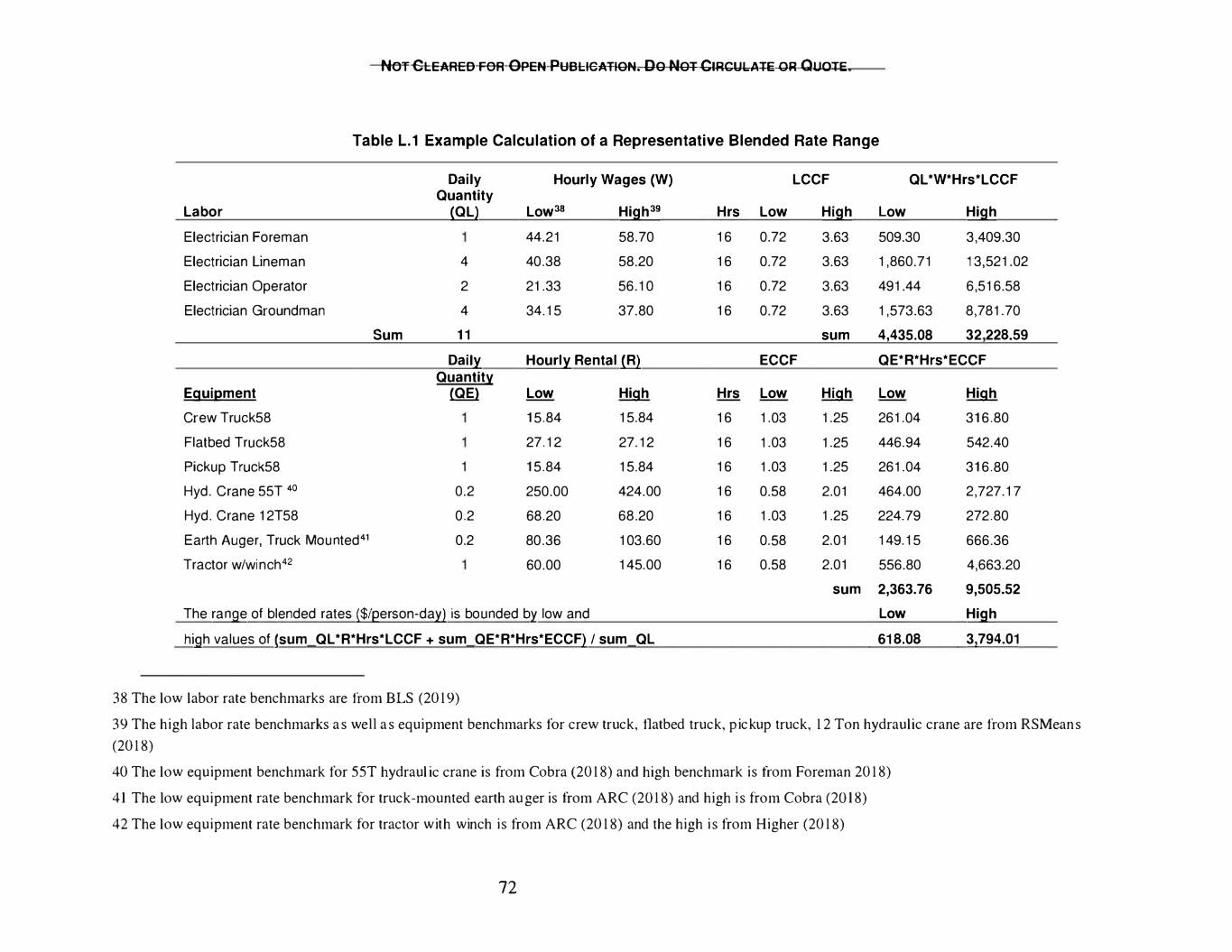
NOT CLEARED FOR OPEN PUBLICATION. Do NOT CIRCYlATE OR OU0TE Table L.1 Example Calculation of a Representative Blended Rate Range Daily Hourly Wages (W) LCCF QL *W*Hrs*LCCF Quantity Labor (QL) Low38 High39 Hrs Low High Low High Electrician Foreman 44.21 58.70 16 0.72 3.63 509.30 3,409.30 Electrician Lineman 4 40.38 58.20 16 0.72 3.63 1,860.71 13,521.02 Electrician Operator 2 21.33 56.10 16 0.72 3.63 491.44 6,516.58 Electrician Groundman 4 34.15 37.80 16 0.72 3.63 1,573.63 8,781.70 Sum 11 sum 4,435.08 32 228.59 Daily Hourly Rental (R) ECCF QE*R*Hrs*ECCF Quantitll Equipment (QE) Low High Hrs Low High Low High Crew Truck58 15.84 15.84 16 1.03 1.25 261.04 316.80 Flatbed Truck58 27.12 27.12 16 1.03 1.25 446.94 542.40 Pickup Truck58 1 15.84 15.84 16 1.03 1.25 261.04 316.80 Hyd. Crane 55T 40 0.2 250.00 424.00 16 0.58 2.01 464.00 2,727.17 Hyd. Crane 12T58 0.2 68.20 68.20 16 1.03 1.25 224.79 272.80 Earth Auger, Truck Mounted41 0.2 80.36 103.60 16 0.58 2.01 149.15 666.36 Tractor w/winch42 60.00 145.00 16 0.58 2.01 556.80 4,663.20 sum 2,363.76 9,505.52 The range of blended rates ($/person-day) is bounded by low and Low High high values of (sum QL*R*Hrs*LCCF + sum QE*R*Hrs*ECCF) / sum QL 618.08 3,794.01 38 The low labor rate benchmarks are from BLS (2019) 39 The high labor rate benchmarks as well as equipment benchmarks for crew truck, flatbed truck, pickup truck, 12 Ton hydraulic crane are from RSMeans (2018) 40 The low equipment benchmark for 55T hydraulic crane is from Cobra (2018) and high benchmark is from Foreman 2018) 41 The low equipment rate benchmark for truck-mounted earth auger is from ARC (2018) and high is from Cobra (2018) 42 The low equipment rate benchmark for tractor with winch is from ARC (2018) and the high is from Higher (2018) 72
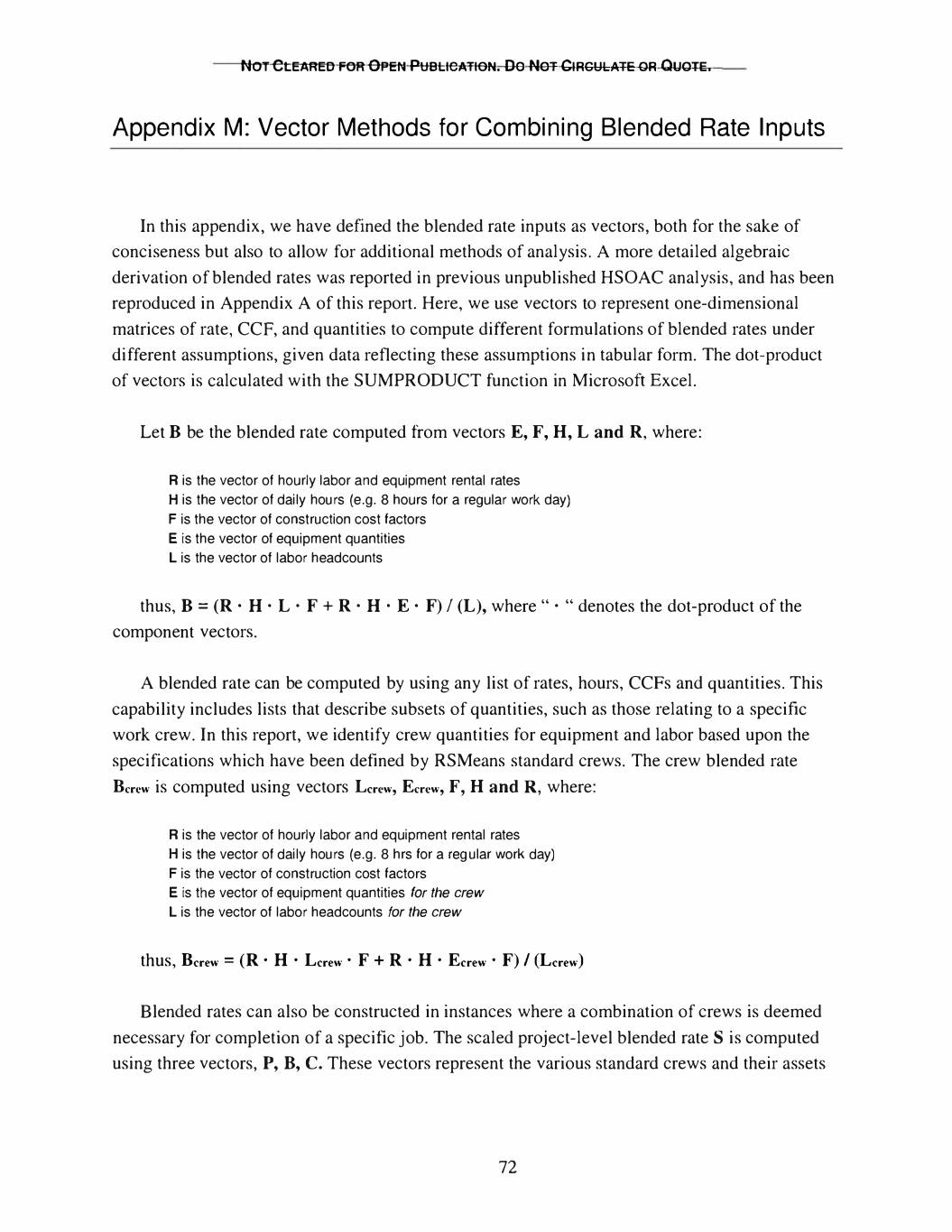
NOT CtEAFIEDFOR OPEN PUBLICATION. Do NOT CIRCULATE OR QUOTE. Appendix M: Vector Methods for Combining Blended Rate Inputs In this appendix, we have defined the blended rate inputs as vectors, both for the sake of conciseness but also to allow for additional methods of analysis. A more detailed algebraic derivation of blended rates was reported in previous unpublished HSOAC analysis, and has been reproduced in Appendix A of this report. Here, we use vectors to represent one-dimensional matrices of rate, CCF, and quantities to compute differentformulations of blended rates under different assumptions, given data reflecting these assumptions in tabular form. The dot-product of vectors is calculated with the SUMPRODUCT function in Microsoft Excel. Let B be the blended rate computed from vectors E, F, H, Land R, where: R is the vector of hourly labor and equipment rental rates H is the vector of daily hours (e.g. 8 hours for a regular work day) F is the vector of construction cost factors E is the vector of equipment quantities L is the vector of labor headcounts thus, B = (R · H · L · F + R · H · E · F) / (L), where" · "denotes the dot-product of the component vectors. A blended rate can be computed by using any list of rates, hours, CCFs and quantities. This capability includes lists that describe subsets of quantities, such as those relating to a specific work crew. In this report, we identify crew quantities forequipment and labor based upon the specifications which have been defined by RSMeans standard crews. The crew blended rate Bcrew is computed using vectors Lerew, Ecrew, F, Hand R, where: R is the vector of hourly labor and equipment rental rates H is the vector of daily hours (e.g. 8 hrs for a regular work day) F is the vector of construction cost factors E is the vector of equipment quantities for the crew L is the vector of labor headcounts for the crew thus, Berew = (R • H • Lerew• F + R • H • Ecrew • F) / (Lerew) Blended rates can also be constructed in instances where a combination of crews is deemed necessary for completion of a specific job. The scaled project-level blended rate S is computed using three vectors, P, B, C. These vectors represent the various standard crews and their assets 72

NOT CtEAFIEDFOFI OPEN PUBLICATION. Do NOT CIRCULATE OR QUOTE. needed to complete a given construction project. These values are establishing according to a Work Breakdown Structure (WBS): P is the crew profile for a category of work, assembled according to WBS Bcrew,i is the vector of blended rates for i crews C; is the vector of crew i size Sis the blended rate, scaled to the work given by profile P thus, S = (Bcrew,i • C · P) I (P · C) 73
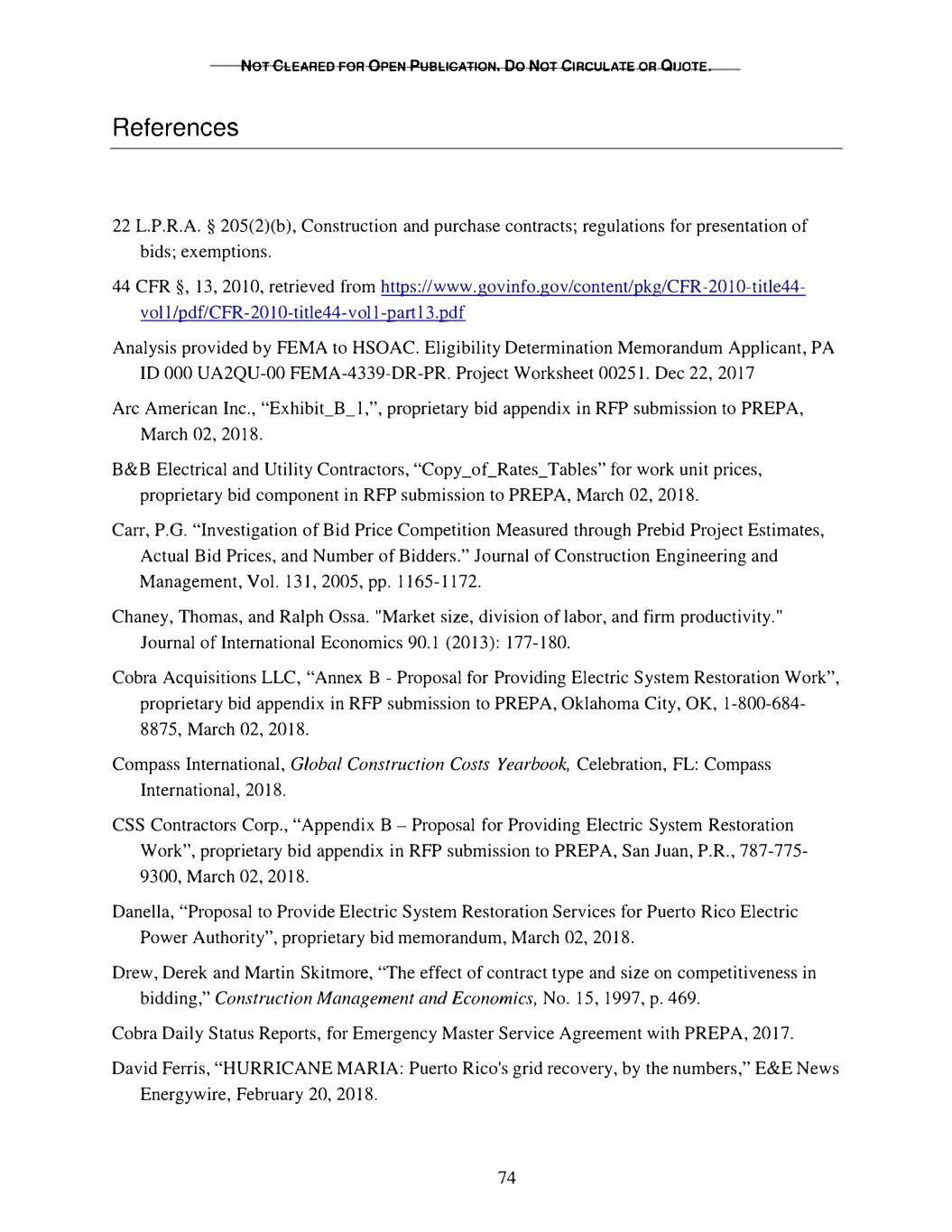
NOT CLEARED FOR OPEN PUBLICATION. Do NOT CIRCULATE OR a, I0TE References 22 L.P.R.A. § 205(2)(b), Construction and purchase contracts; regulations forpresentation of bids; exemptions. 44 CFR §, 13, 2010, retrieved from https://www.govinfo.gov/content/pkg/CFR-2010-title44- voll/pdf/CFR-2010-title44-voll-partl 3.pdf Analysis provided by FEMA to HSOAC. Eligibility Determination Memorandum Applicant, PA ID 000 UA2QU-00 FEMA-4339-DR-PR. Project Worksheet 00251. Dec 22, 2017 Arc American Inc., "Exhibit_B_l,", proprietary bid appendix in RFP submission to PREPA, March 02, 2018. B&B Electrical and Utility Contractors, "Copy_of_Rates_Tables"for work unit prices, proprietary bid component in RFP submission to PREPA, March 02, 2018. Carr, P.G. "Investigation of Bid Price Competition Measured through Prebid Project Estimates, Actual Bid Prices, and Number of Bidders." Journal of Construction Engineering and Management, Vol. 131, 2005, pp. 1165-1172. Chaney, Thomas, and Ralph Ossa. "Market size, division of labor, and firm productivity." Journal of International Economics 90.1 (2013): 177-180. Cobra Acquisitions LLC, "Annex B - Proposal for Providing Electric System Restoration Work", proprietary bid appendix in RFP submission to PREPA, Oklahoma City, OK, 1-800-684- 8875, March 02, 2018. Compass International, Global Construction Costs Yearbook, Celebration, FL: Compass International, 2018. CSS Contractors Corp., "Appendix B - Proposal for Providing Electric System Restoration Work", proprietary bid appendix in RFP submission to PREPA, San Juan, P.R., 787-775- 9300, March 02, 2018. Danella, "Proposal to Provide Electric System Restoration Services for Puerto Rico Electric Power Authority", proprietary bid memorandum, March 02, 2018. Drew, Derek and Martin Skitmore, "The effect of contract type and size on competitiveness in bidding," Construction Management and Economics, No. 15, 1997, p. 469. Cobra Daily Status Reports, for Emergency Master Service Agreement with PREPA, 2017. David Ferris, "HURRICANE MARIA: Puerto Rico's grid recovery, by the numbers," E&E News Energywire, February 20, 2018. 74
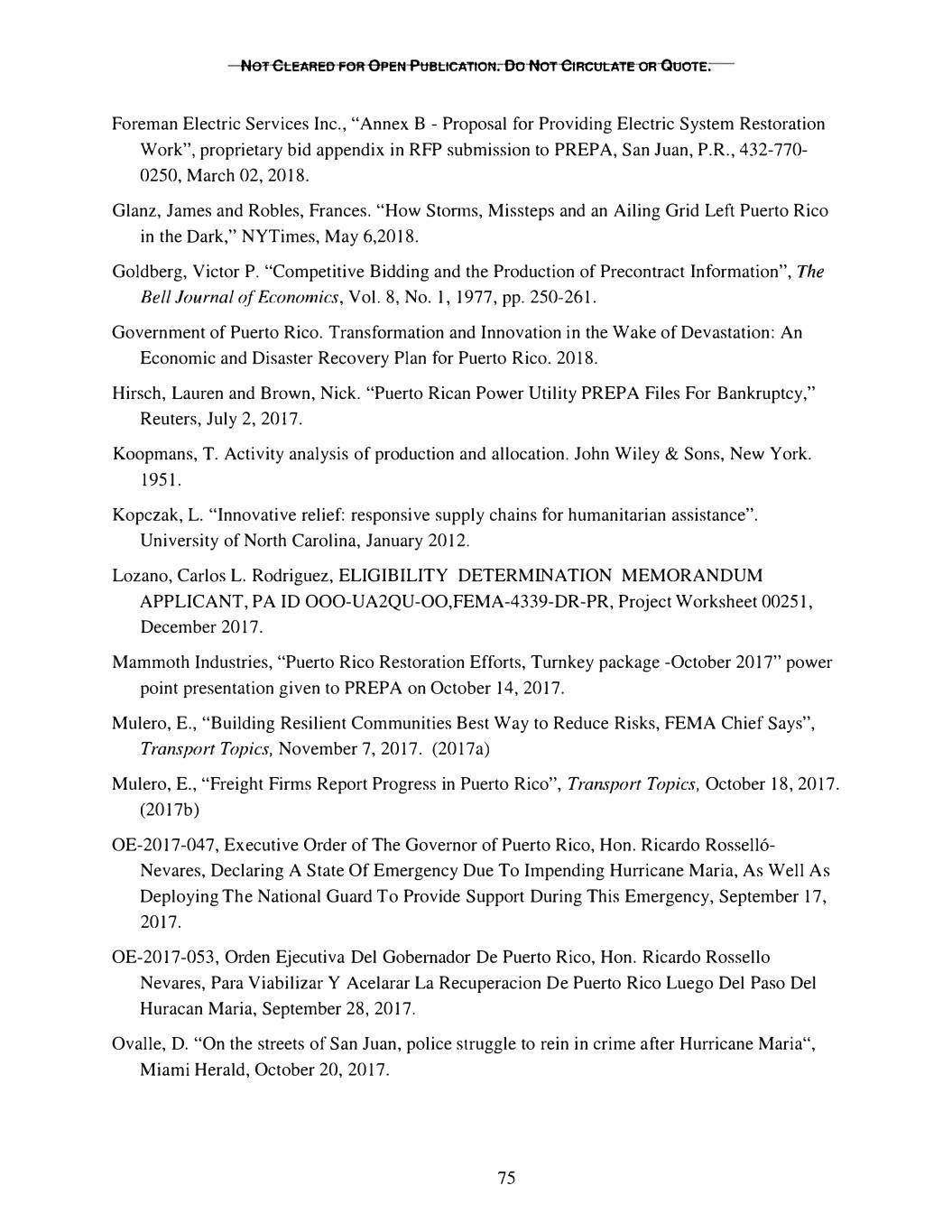
NOT CLEARED FOR OPEN PUBLICATION. Do NOT CIRCULATE OR QUOTE. Foreman Electric Services Inc., "Annex B - Proposal forProviding Electric System Restoration Work", proplietary bid appendix in RFP submission to PREPA, San Juan, P.R., 432-770- 0250, March 02, 2018. Glanz, James and Robles, Frances. "How Storms, Missteps and an Ailing Grid Left Puerto Rico in the Dark," NYTimes, May 6,2018. Goldberg, Victor P. "Competitive Bidding and the Production of Precontract Information", The Bell Journal of Economics, Vol. 8, No. 1, 1977, pp. 250-261. Government of Puerto Rico. Transformationand Innovation in the Wake of Devastation: An Economic and Disaster Recovery Plan forPuerto Rico. 2018. Hirsch, Lauren and Brown, Nick. "Puerto Rican Power Utility PREPA Files For Bankruptcy," Reuters, July 2, 2017. Koopmans, T. Activity analysis of production and allocation. John Wiley & Sons, New York. 1951. Kopczak, L. "Innovative relief: responsive supply chains forhumanitarian assistance". University of North Carolina, January 2012. Lozano, Carlos L. Rodriguez, ELIGIBILITY DETERMINATION MEMORANDUM APPLICANT, PA ID OOO-UA2QU-OO,FEMA-4339-DR-PR, Project Worksheet 00251, December 2017. Mammoth Industries, "Puerto Rico Restoration Efforts, Turnkey package -October 2017" power point presentation given to PREPA on October 14, 2017. Mulero, E., "Building Resilient Communities Best Way to Reduce Risks, FEMA Chief Says", Transport Topics, November 7, 2017. (2017a) Mulero, E., "Freight Firms Report Progress in Puerto Rico", Transport Topics, October 18, 2017. (2017b) OE-2017-04 7, Executive Order of The Governor of Puerto Rico, Hon. Ricardo Rossell6- Nevares, Declaring A State Of Emergency Due To Impending Hurricane Maria, As Well As Deploying The National Guard To Provide Support During This Emergency, September 17, 2017. OE-2017-053, Orden Ejecutiva Del Gobemador De Puerto Rico, Hon. Ricardo Rossello Nevares, Para Viabilizar Y Acelarar La Recuperacion De Puerto Rico Luego Del Paso Del Huracan Maria, September 28, 2017. Ovalle, D. "On the streets of San Juan, police struggle to rein in crime afterHurricane Maria", Miami Herald, October 20, 2017. 75
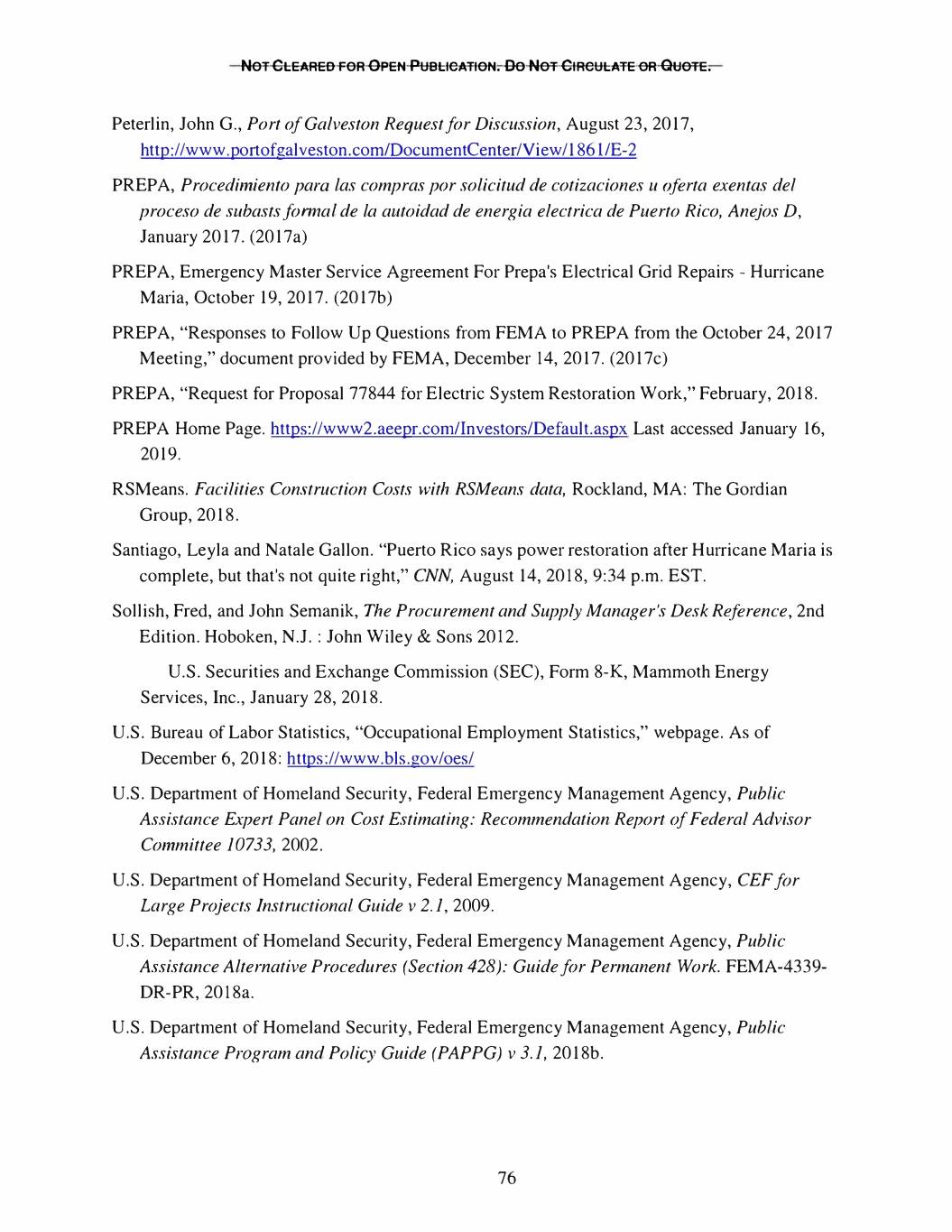
NOT CLEARED FOR OPEN PUBLICATION. 00 NOT CIRCULATE OR QUOTE. Peterlin, John G., Port of Galveston Request for Discussion, August 23, 2017, http://www. port of galveston . com/DocumentCenter/View /1 86 l/E-2 PREPA, Procedimiento para las compras por solicitud de cotizaciones u oferta exentas del proceso de subasts Jonna! de la autoidad de energia electrica de Puerto Rico, Anejos D, January 2017. (2017a) PREPA, Emergency Master Service Agreement For Prepa's Electrical Grid Repairs - Hurricane Maria, October 19, 2017. (2017b) PREPA, "Responses to Follow Up Questions from FEMA to PREPA from the October 24, 2017 Meeting," document provided by FEMA, December 14, 2017. (2017c) PREPA, "Request for Proposal 77844 for Electric System Restoration Work," February, 2018. PREPA Home Page. https://www2.aeepr.com/Investors/Default.aspx Last accessed January 16, 2019. RSMeans. Facilities Construction Costs with RSMeans data, Rockland, MA: The Gordian Group, 2018. Santiago, Leyla and Natale Gallon. "Puerto Rico says power restoration after Hurricane Maria is complete, but that's not quite right," CNN, August 14, 2018, 9:34 p.m. EST. Sollish, Fred, and John Semanik, The Procurement and Supply Manager's Desk Reference,2nd Edition. Hoboken, N.J.: John Wiley & Sons 2012. U.S. Securities and Exchange Commission (SEC), Form 8-K, Mammoth Energy Services, Inc., January 28, 2018. U.S. Bureau of Labor Statistics, "Occupational Employment Statistics," webpage. As of December 6, 2018: https://www.bls.gov/oes/ U.S. Department of Homeland Security, Federal Emergency Management Agency, Public Assistance Expert Panel on Cost Estimating: Recommendation Report of Federal Advisor Committee 10733, 2002. U.S. Department of Homeland Security, Federal Emergency Management Agency, CEF for Large Projects Instructional Guide v 2.1, 2009. U.S. Department of Homeland Security, Federal Emergency Management Agency, Public Assistance AlternativeProcedures (Section 428): Guide for Permanent Work. FEMA-4339- DR-PR, 2018a. U.S. Department of Homeland Security, Federal Emergency Management Agency, Public Assistance Program and Policy Guide (PAP PG) v 3.1, 2018b. 76
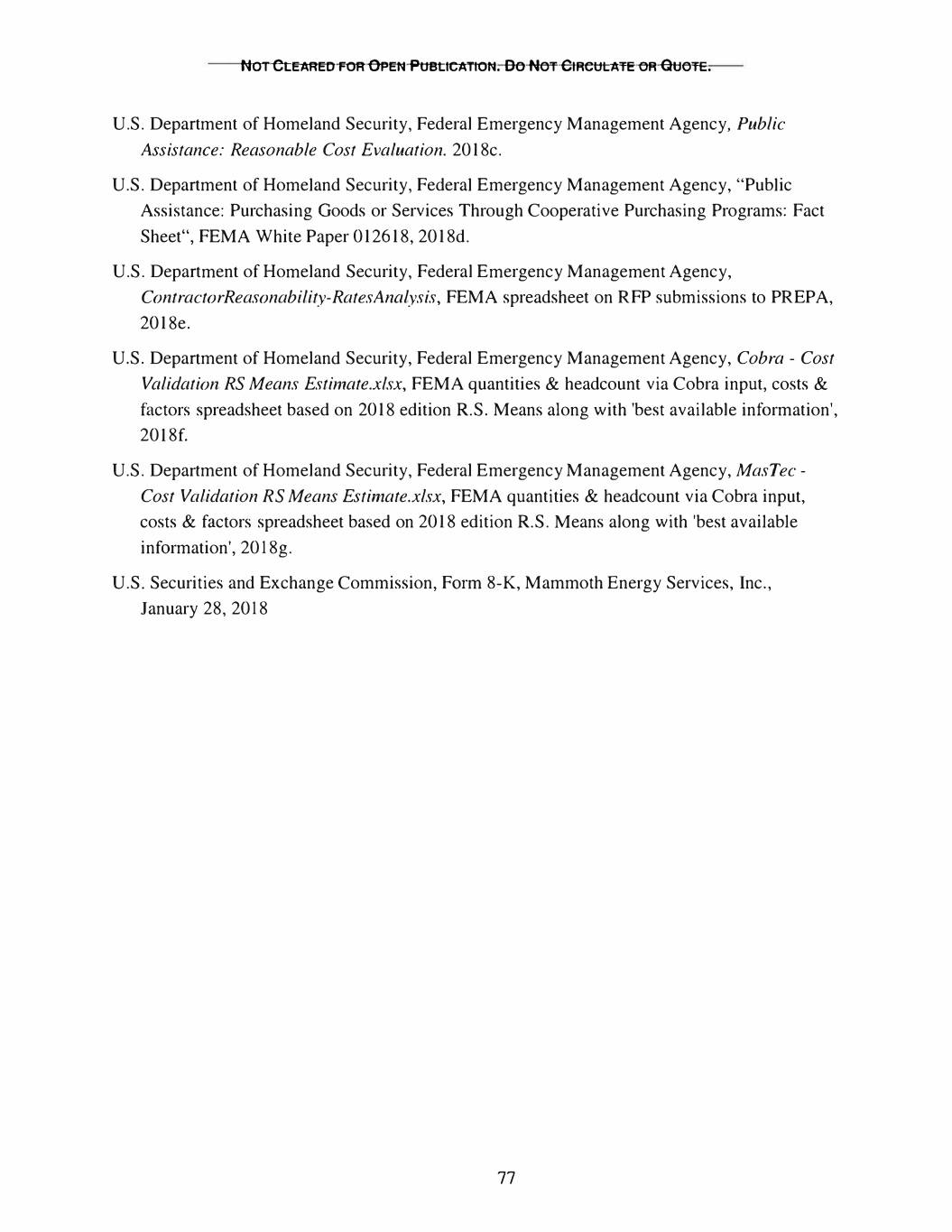
NOT CtEAFIEDFOFI OPEN PUBLICATION. 00 NOT CIRCULATE OR QUOTE. U.S. Department of Homeland Security, Federal Emergency Management Agency, Public Assistance: Reasonable Cost Evaluation. 2018c. U.S. Department of Homeland Security, Federal Emergency Management Agency, "Public Assistance: Purchasing Goods or Services Through Cooperative Purchasing Programs: Fact Sheet", FEMA White Paper 012618, 2018d. U.S. Department of Homeland Security, Federal Emergency Management Agency, ContractorReasonability-RatesAnalysis, FEMA spreadsheet on RFP submissions to PREPA, 2018e. U.S. Department of Homeland Security, Federal Emergency Management Agency, Cobra - Cost Validation RS Means Estimate.xlsx, FEMA quantities & headcount via Cobra input, costs & factors spreadsheet based on 2018 edition RS. Means along with 'best available information', 2018f. U.S. Department of Homeland Security, Federal Emergency Management Agency, MasTec - Cost Validation RS Means Estimate.xlsx, FEMA quantities & headcount via Cobra input, costs & factors spreadsheet based on 2018 edition RS. Means along with 'best available information', 2018g. U.S. Securities and Exchange Commission, Fmm 8-K, Mammoth Energy Services, Inc., January 28, 2018 77